mpact of Employee Cultural Differences on the Performance of the Organization
VerifiedAdded on 2021/05/31
|78
|20750
|15
AI Summary
Contribute Materials
Your contribution can guide someone’s learning journey. Share your
documents today.
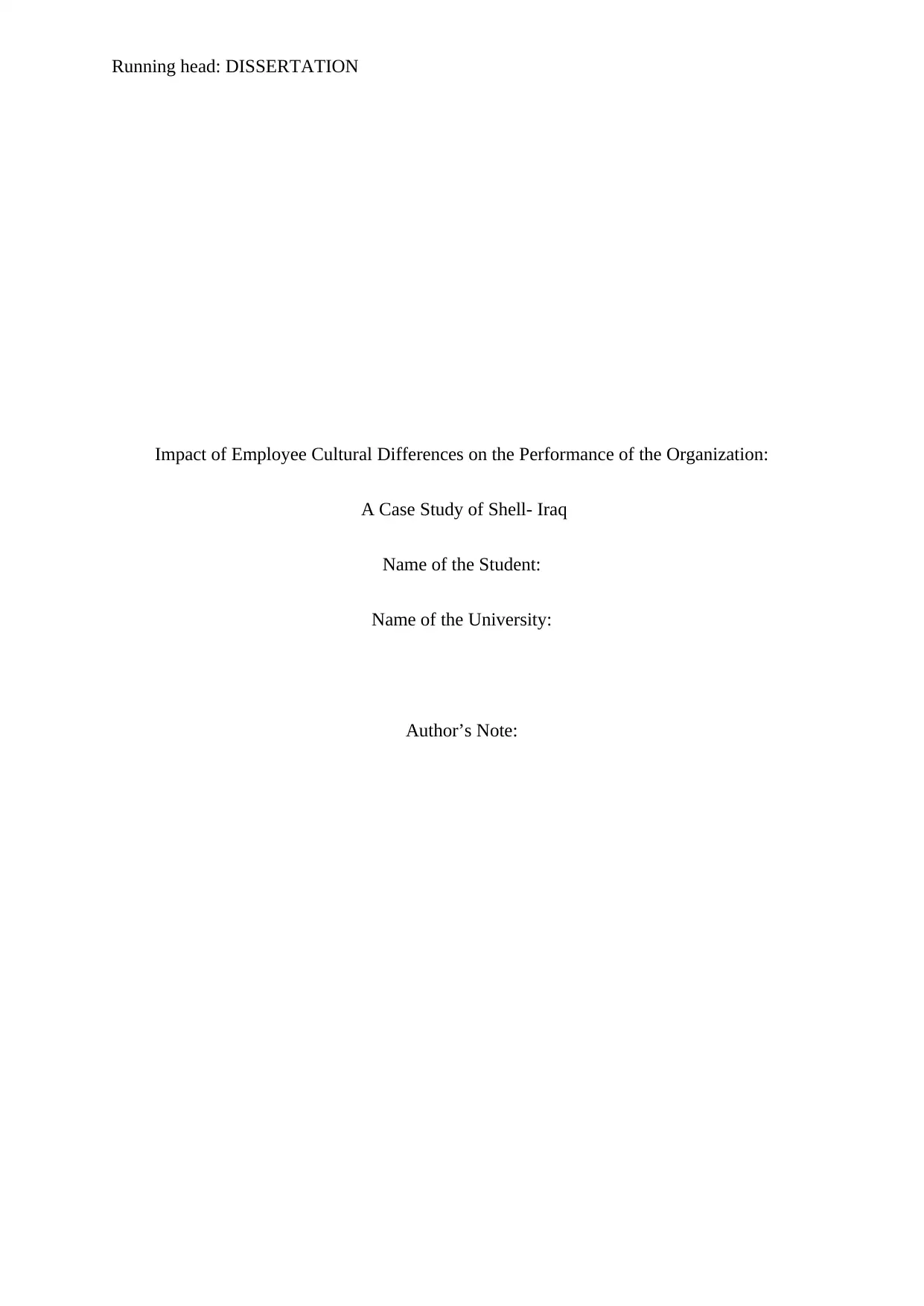
Running head: DISSERTATION
Impact of Employee Cultural Differences on the Performance of the Organization:
A Case Study of Shell- Iraq
Name of the Student:
Name of the University:
Author’s Note:
Impact of Employee Cultural Differences on the Performance of the Organization:
A Case Study of Shell- Iraq
Name of the Student:
Name of the University:
Author’s Note:
Secure Best Marks with AI Grader
Need help grading? Try our AI Grader for instant feedback on your assignments.
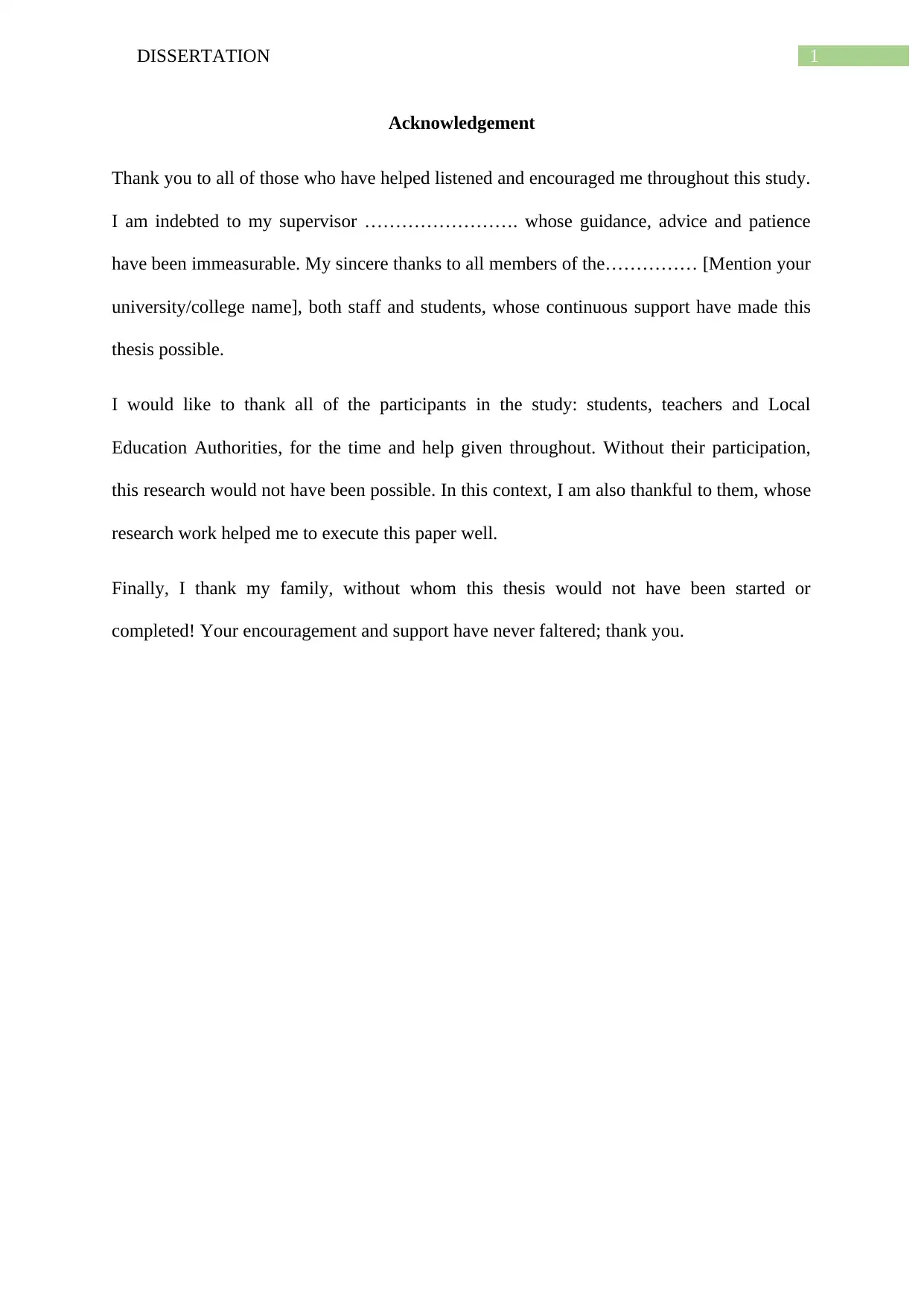
1DISSERTATION
Acknowledgement
Thank you to all of those who have helped listened and encouraged me throughout this study.
I am indebted to my supervisor ……………………. whose guidance, advice and patience
have been immeasurable. My sincere thanks to all members of the…………… [Mention your
university/college name], both staff and students, whose continuous support have made this
thesis possible.
I would like to thank all of the participants in the study: students, teachers and Local
Education Authorities, for the time and help given throughout. Without their participation,
this research would not have been possible. In this context, I am also thankful to them, whose
research work helped me to execute this paper well.
Finally, I thank my family, without whom this thesis would not have been started or
completed! Your encouragement and support have never faltered; thank you.
Acknowledgement
Thank you to all of those who have helped listened and encouraged me throughout this study.
I am indebted to my supervisor ……………………. whose guidance, advice and patience
have been immeasurable. My sincere thanks to all members of the…………… [Mention your
university/college name], both staff and students, whose continuous support have made this
thesis possible.
I would like to thank all of the participants in the study: students, teachers and Local
Education Authorities, for the time and help given throughout. Without their participation,
this research would not have been possible. In this context, I am also thankful to them, whose
research work helped me to execute this paper well.
Finally, I thank my family, without whom this thesis would not have been started or
completed! Your encouragement and support have never faltered; thank you.
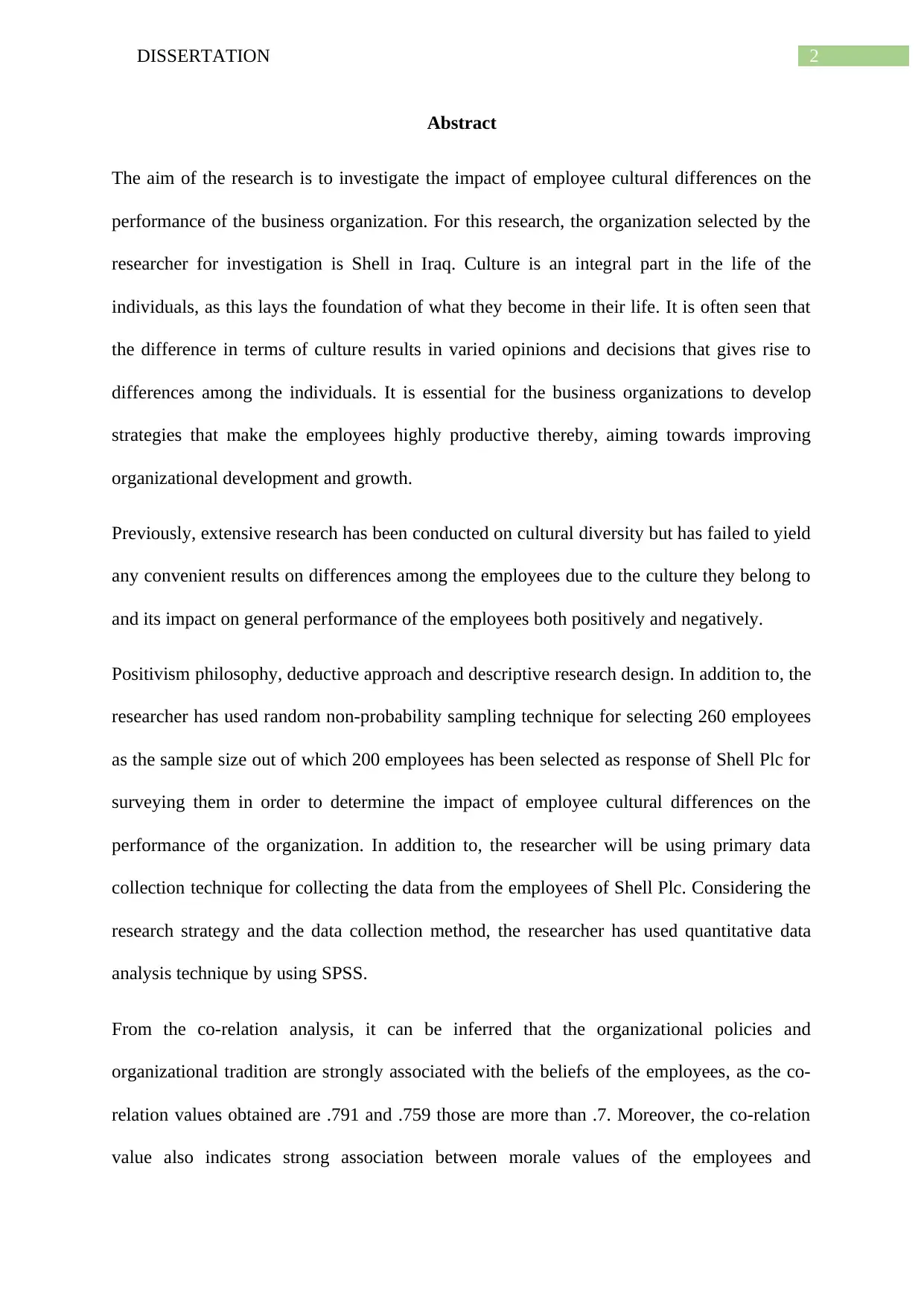
2DISSERTATION
Abstract
The aim of the research is to investigate the impact of employee cultural differences on the
performance of the business organization. For this research, the organization selected by the
researcher for investigation is Shell in Iraq. Culture is an integral part in the life of the
individuals, as this lays the foundation of what they become in their life. It is often seen that
the difference in terms of culture results in varied opinions and decisions that gives rise to
differences among the individuals. It is essential for the business organizations to develop
strategies that make the employees highly productive thereby, aiming towards improving
organizational development and growth.
Previously, extensive research has been conducted on cultural diversity but has failed to yield
any convenient results on differences among the employees due to the culture they belong to
and its impact on general performance of the employees both positively and negatively.
Positivism philosophy, deductive approach and descriptive research design. In addition to, the
researcher has used random non-probability sampling technique for selecting 260 employees
as the sample size out of which 200 employees has been selected as response of Shell Plc for
surveying them in order to determine the impact of employee cultural differences on the
performance of the organization. In addition to, the researcher will be using primary data
collection technique for collecting the data from the employees of Shell Plc. Considering the
research strategy and the data collection method, the researcher has used quantitative data
analysis technique by using SPSS.
From the co-relation analysis, it can be inferred that the organizational policies and
organizational tradition are strongly associated with the beliefs of the employees, as the co-
relation values obtained are .791 and .759 those are more than .7. Moreover, the co-relation
value also indicates strong association between morale values of the employees and
Abstract
The aim of the research is to investigate the impact of employee cultural differences on the
performance of the business organization. For this research, the organization selected by the
researcher for investigation is Shell in Iraq. Culture is an integral part in the life of the
individuals, as this lays the foundation of what they become in their life. It is often seen that
the difference in terms of culture results in varied opinions and decisions that gives rise to
differences among the individuals. It is essential for the business organizations to develop
strategies that make the employees highly productive thereby, aiming towards improving
organizational development and growth.
Previously, extensive research has been conducted on cultural diversity but has failed to yield
any convenient results on differences among the employees due to the culture they belong to
and its impact on general performance of the employees both positively and negatively.
Positivism philosophy, deductive approach and descriptive research design. In addition to, the
researcher has used random non-probability sampling technique for selecting 260 employees
as the sample size out of which 200 employees has been selected as response of Shell Plc for
surveying them in order to determine the impact of employee cultural differences on the
performance of the organization. In addition to, the researcher will be using primary data
collection technique for collecting the data from the employees of Shell Plc. Considering the
research strategy and the data collection method, the researcher has used quantitative data
analysis technique by using SPSS.
From the co-relation analysis, it can be inferred that the organizational policies and
organizational tradition are strongly associated with the beliefs of the employees, as the co-
relation values obtained are .791 and .759 those are more than .7. Moreover, the co-relation
value also indicates strong association between morale values of the employees and

3DISSERTATION
organizational tradition, as the value obtained is .745 that is more than .7. The second co-
relation analysis indicates that the independent variables such as beliefs, language, morale
values, organizational policies and tradition is strongly associated with organizational
performance, as the value obtained is .830 that is more than .7. Moreover, the result obtained
from the regression analysis indicates that the p-value is .000 that is less than .05. Hence, it
can be said that the null hypothesis has been rejected and the alternative hypothesis has been
accepted. The result of the regression analysis is supported by the results obtained from the
second co-relation analysis that indicates strong association. Therefore, it can be said that the
existing cultural difference among the employees in Shell Plc has an impact on the
organizational performance.
organizational tradition, as the value obtained is .745 that is more than .7. The second co-
relation analysis indicates that the independent variables such as beliefs, language, morale
values, organizational policies and tradition is strongly associated with organizational
performance, as the value obtained is .830 that is more than .7. Moreover, the result obtained
from the regression analysis indicates that the p-value is .000 that is less than .05. Hence, it
can be said that the null hypothesis has been rejected and the alternative hypothesis has been
accepted. The result of the regression analysis is supported by the results obtained from the
second co-relation analysis that indicates strong association. Therefore, it can be said that the
existing cultural difference among the employees in Shell Plc has an impact on the
organizational performance.
Secure Best Marks with AI Grader
Need help grading? Try our AI Grader for instant feedback on your assignments.

4DISSERTATION
Table of Contents
Chapter 1: Introduction..............................................................................................................8
1.0 Overview.....................................................................................................................8
1.1 Problem statement............................................................................................................9
1.2 Research aim..................................................................................................................10
1.3 Research objectives........................................................................................................10
1.4 Research questions.........................................................................................................10
1.5 Research hypotheses......................................................................................................11
1.6 Research rationale..........................................................................................................11
1.7 Structure of the dissertation...........................................................................................12
1.8 Summary........................................................................................................................13
Chapter 2: Literature Review...................................................................................................14
2.0 Overview...................................................................................................................14
2.1 Conceptual framework...................................................................................................14
2.2 Employee religion and organizational performance......................................................15
2.3 Factors affecting cultural differences.............................................................................16
2.3.1 Beliefs.....................................................................................................................17
2.3.2 Morale values..........................................................................................................17
2.3.3 Organizational policies............................................................................................18
2.3.4 Language.................................................................................................................19
Table of Contents
Chapter 1: Introduction..............................................................................................................8
1.0 Overview.....................................................................................................................8
1.1 Problem statement............................................................................................................9
1.2 Research aim..................................................................................................................10
1.3 Research objectives........................................................................................................10
1.4 Research questions.........................................................................................................10
1.5 Research hypotheses......................................................................................................11
1.6 Research rationale..........................................................................................................11
1.7 Structure of the dissertation...........................................................................................12
1.8 Summary........................................................................................................................13
Chapter 2: Literature Review...................................................................................................14
2.0 Overview...................................................................................................................14
2.1 Conceptual framework...................................................................................................14
2.2 Employee religion and organizational performance......................................................15
2.3 Factors affecting cultural differences.............................................................................16
2.3.1 Beliefs.....................................................................................................................17
2.3.2 Morale values..........................................................................................................17
2.3.3 Organizational policies............................................................................................18
2.3.4 Language.................................................................................................................19
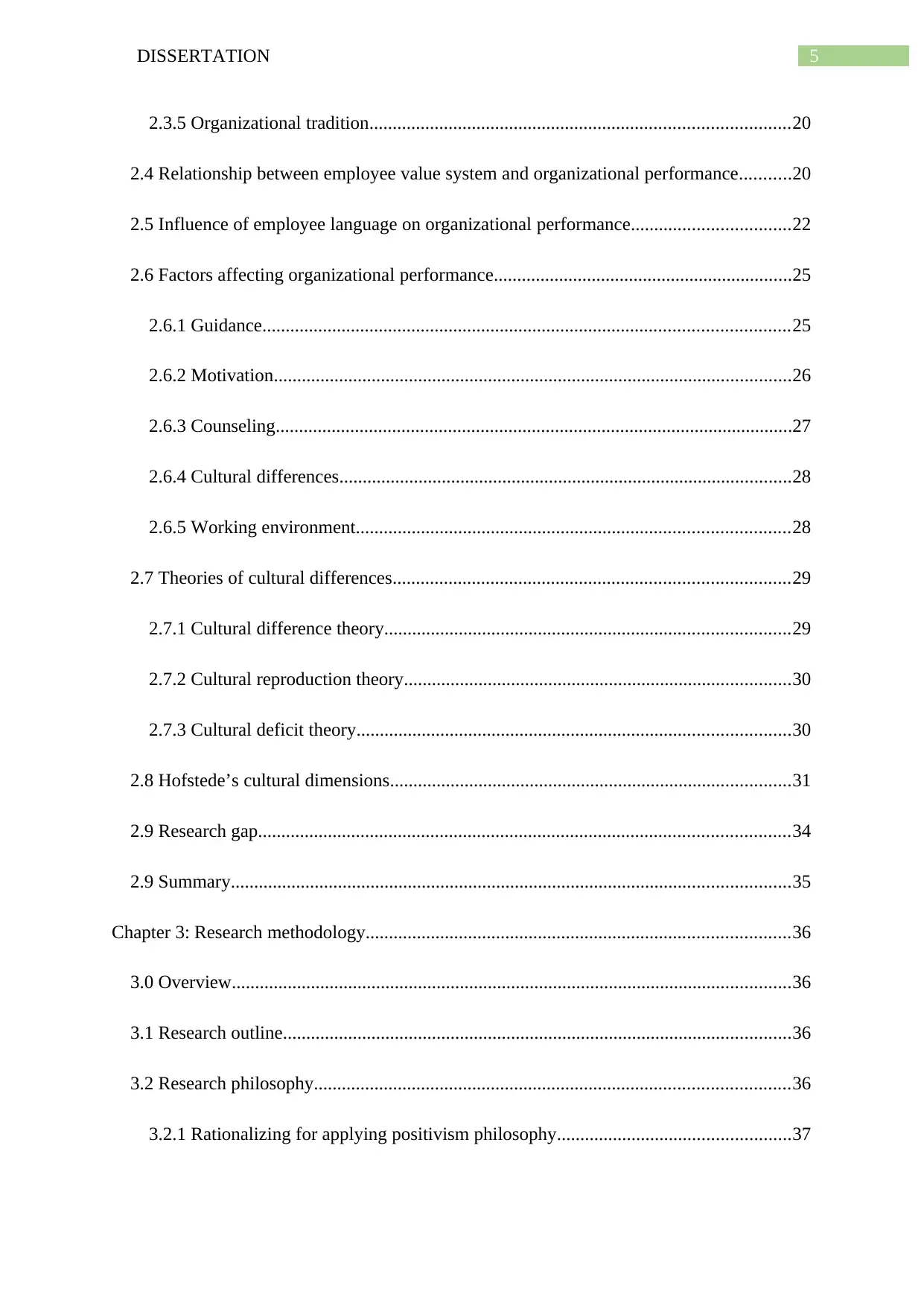
5DISSERTATION
2.3.5 Organizational tradition..........................................................................................20
2.4 Relationship between employee value system and organizational performance...........20
2.5 Influence of employee language on organizational performance..................................22
2.6 Factors affecting organizational performance................................................................25
2.6.1 Guidance.................................................................................................................25
2.6.2 Motivation...............................................................................................................26
2.6.3 Counseling...............................................................................................................27
2.6.4 Cultural differences.................................................................................................28
2.6.5 Working environment.............................................................................................28
2.7 Theories of cultural differences.....................................................................................29
2.7.1 Cultural difference theory.......................................................................................29
2.7.2 Cultural reproduction theory...................................................................................30
2.7.3 Cultural deficit theory.............................................................................................30
2.8 Hofstede’s cultural dimensions......................................................................................31
2.9 Research gap..................................................................................................................34
2.9 Summary........................................................................................................................35
Chapter 3: Research methodology...........................................................................................36
3.0 Overview........................................................................................................................36
3.1 Research outline.............................................................................................................36
3.2 Research philosophy......................................................................................................36
3.2.1 Rationalizing for applying positivism philosophy..................................................37
2.3.5 Organizational tradition..........................................................................................20
2.4 Relationship between employee value system and organizational performance...........20
2.5 Influence of employee language on organizational performance..................................22
2.6 Factors affecting organizational performance................................................................25
2.6.1 Guidance.................................................................................................................25
2.6.2 Motivation...............................................................................................................26
2.6.3 Counseling...............................................................................................................27
2.6.4 Cultural differences.................................................................................................28
2.6.5 Working environment.............................................................................................28
2.7 Theories of cultural differences.....................................................................................29
2.7.1 Cultural difference theory.......................................................................................29
2.7.2 Cultural reproduction theory...................................................................................30
2.7.3 Cultural deficit theory.............................................................................................30
2.8 Hofstede’s cultural dimensions......................................................................................31
2.9 Research gap..................................................................................................................34
2.9 Summary........................................................................................................................35
Chapter 3: Research methodology...........................................................................................36
3.0 Overview........................................................................................................................36
3.1 Research outline.............................................................................................................36
3.2 Research philosophy......................................................................................................36
3.2.1 Rationalizing for applying positivism philosophy..................................................37
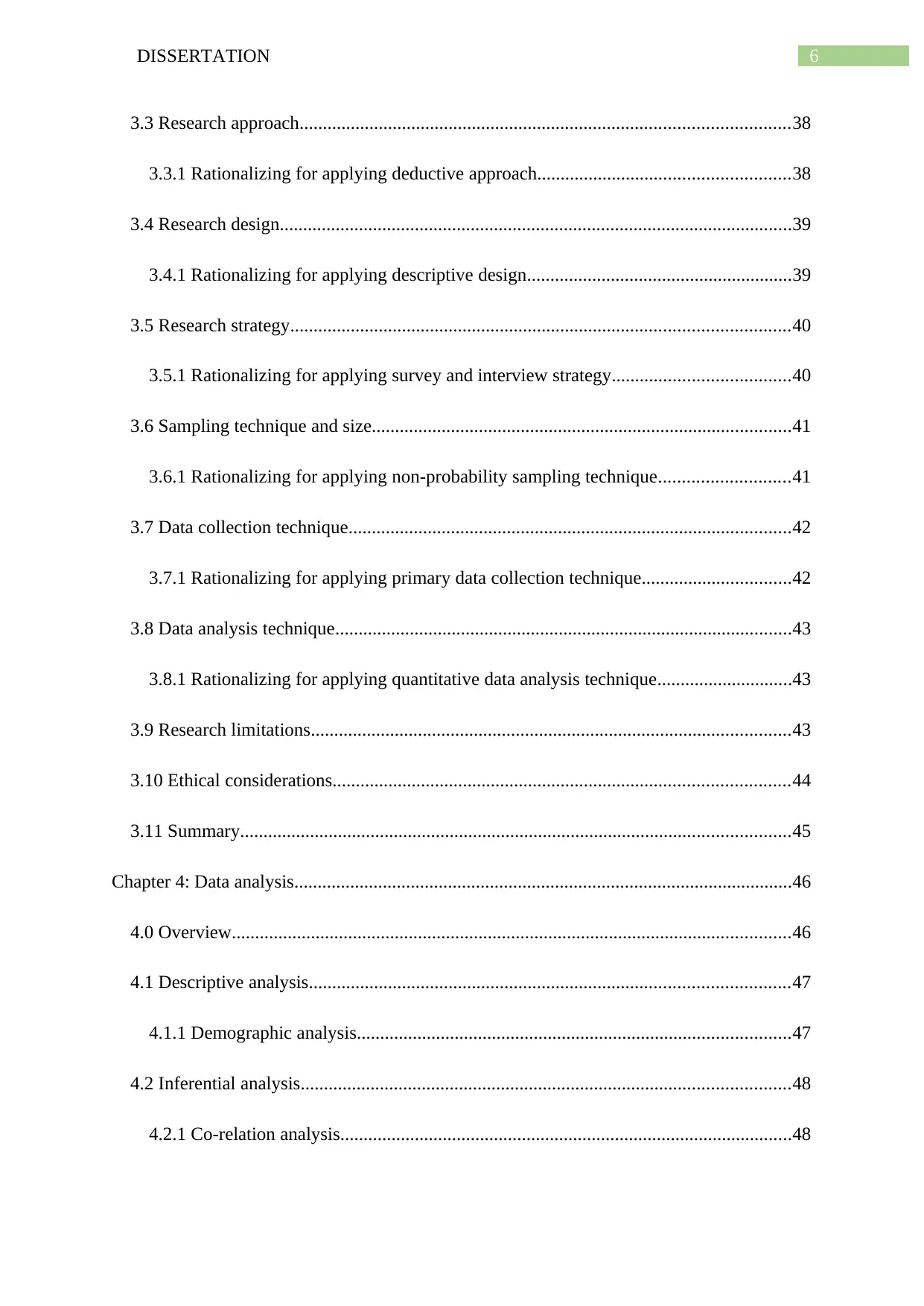
6DISSERTATION
3.3 Research approach.........................................................................................................38
3.3.1 Rationalizing for applying deductive approach......................................................38
3.4 Research design..............................................................................................................39
3.4.1 Rationalizing for applying descriptive design.........................................................39
3.5 Research strategy...........................................................................................................40
3.5.1 Rationalizing for applying survey and interview strategy......................................40
3.6 Sampling technique and size..........................................................................................41
3.6.1 Rationalizing for applying non-probability sampling technique............................41
3.7 Data collection technique...............................................................................................42
3.7.1 Rationalizing for applying primary data collection technique................................42
3.8 Data analysis technique..................................................................................................43
3.8.1 Rationalizing for applying quantitative data analysis technique.............................43
3.9 Research limitations.......................................................................................................43
3.10 Ethical considerations..................................................................................................44
3.11 Summary......................................................................................................................45
Chapter 4: Data analysis...........................................................................................................46
4.0 Overview........................................................................................................................46
4.1 Descriptive analysis.......................................................................................................47
4.1.1 Demographic analysis.............................................................................................47
4.2 Inferential analysis.........................................................................................................48
4.2.1 Co-relation analysis.................................................................................................48
3.3 Research approach.........................................................................................................38
3.3.1 Rationalizing for applying deductive approach......................................................38
3.4 Research design..............................................................................................................39
3.4.1 Rationalizing for applying descriptive design.........................................................39
3.5 Research strategy...........................................................................................................40
3.5.1 Rationalizing for applying survey and interview strategy......................................40
3.6 Sampling technique and size..........................................................................................41
3.6.1 Rationalizing for applying non-probability sampling technique............................41
3.7 Data collection technique...............................................................................................42
3.7.1 Rationalizing for applying primary data collection technique................................42
3.8 Data analysis technique..................................................................................................43
3.8.1 Rationalizing for applying quantitative data analysis technique.............................43
3.9 Research limitations.......................................................................................................43
3.10 Ethical considerations..................................................................................................44
3.11 Summary......................................................................................................................45
Chapter 4: Data analysis...........................................................................................................46
4.0 Overview........................................................................................................................46
4.1 Descriptive analysis.......................................................................................................47
4.1.1 Demographic analysis.............................................................................................47
4.2 Inferential analysis.........................................................................................................48
4.2.1 Co-relation analysis.................................................................................................48
Paraphrase This Document
Need a fresh take? Get an instant paraphrase of this document with our AI Paraphraser

7DISSERTATION
4.2.2 Regression analysis.................................................................................................50
4.3 Summary........................................................................................................................52
Chapter 5: Discussion..............................................................................................................53
Chapter 6: Conclusion and recommendations..........................................................................58
6.0 Conclusion......................................................................................................................58
6.1 Liking with objectives....................................................................................................59
6.2 Recommendations..........................................................................................................61
6.3 Future scope of the study...............................................................................................62
References................................................................................................................................63
Appendix 1...............................................................................................................................72
Survey questionnaire............................................................................................................72
4.2.2 Regression analysis.................................................................................................50
4.3 Summary........................................................................................................................52
Chapter 5: Discussion..............................................................................................................53
Chapter 6: Conclusion and recommendations..........................................................................58
6.0 Conclusion......................................................................................................................58
6.1 Liking with objectives....................................................................................................59
6.2 Recommendations..........................................................................................................61
6.3 Future scope of the study...............................................................................................62
References................................................................................................................................63
Appendix 1...............................................................................................................................72
Survey questionnaire............................................................................................................72
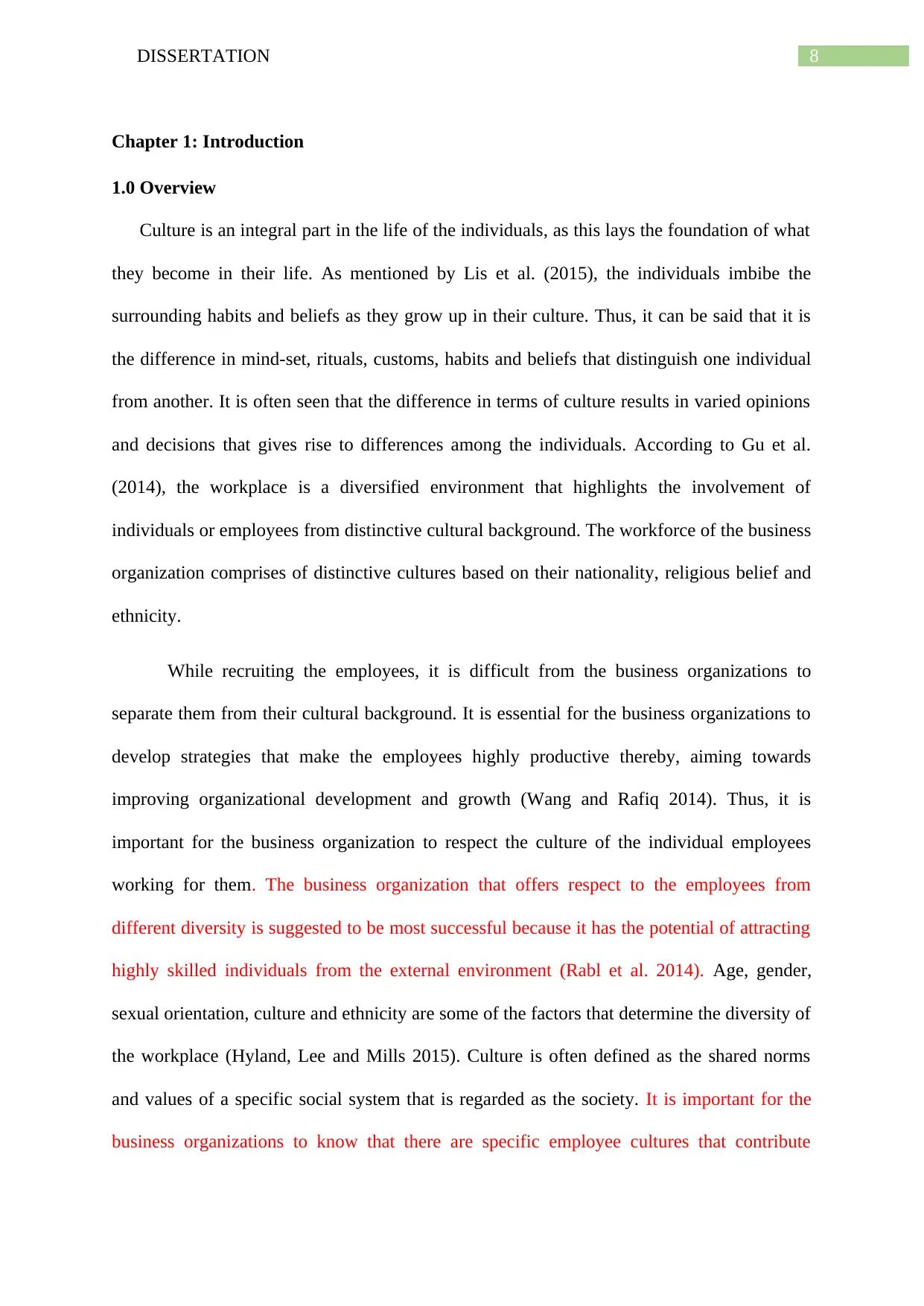
8DISSERTATION
Chapter 1: Introduction
1.0 Overview
Culture is an integral part in the life of the individuals, as this lays the foundation of what
they become in their life. As mentioned by Lis et al. (2015), the individuals imbibe the
surrounding habits and beliefs as they grow up in their culture. Thus, it can be said that it is
the difference in mind-set, rituals, customs, habits and beliefs that distinguish one individual
from another. It is often seen that the difference in terms of culture results in varied opinions
and decisions that gives rise to differences among the individuals. According to Gu et al.
(2014), the workplace is a diversified environment that highlights the involvement of
individuals or employees from distinctive cultural background. The workforce of the business
organization comprises of distinctive cultures based on their nationality, religious belief and
ethnicity.
While recruiting the employees, it is difficult from the business organizations to
separate them from their cultural background. It is essential for the business organizations to
develop strategies that make the employees highly productive thereby, aiming towards
improving organizational development and growth (Wang and Rafiq 2014). Thus, it is
important for the business organization to respect the culture of the individual employees
working for them. The business organization that offers respect to the employees from
different diversity is suggested to be most successful because it has the potential of attracting
highly skilled individuals from the external environment (Rabl et al. 2014). Age, gender,
sexual orientation, culture and ethnicity are some of the factors that determine the diversity of
the workplace (Hyland, Lee and Mills 2015). Culture is often defined as the shared norms
and values of a specific social system that is regarded as the society. It is important for the
business organizations to know that there are specific employee cultures that contribute
Chapter 1: Introduction
1.0 Overview
Culture is an integral part in the life of the individuals, as this lays the foundation of what
they become in their life. As mentioned by Lis et al. (2015), the individuals imbibe the
surrounding habits and beliefs as they grow up in their culture. Thus, it can be said that it is
the difference in mind-set, rituals, customs, habits and beliefs that distinguish one individual
from another. It is often seen that the difference in terms of culture results in varied opinions
and decisions that gives rise to differences among the individuals. According to Gu et al.
(2014), the workplace is a diversified environment that highlights the involvement of
individuals or employees from distinctive cultural background. The workforce of the business
organization comprises of distinctive cultures based on their nationality, religious belief and
ethnicity.
While recruiting the employees, it is difficult from the business organizations to
separate them from their cultural background. It is essential for the business organizations to
develop strategies that make the employees highly productive thereby, aiming towards
improving organizational development and growth (Wang and Rafiq 2014). Thus, it is
important for the business organization to respect the culture of the individual employees
working for them. The business organization that offers respect to the employees from
different diversity is suggested to be most successful because it has the potential of attracting
highly skilled individuals from the external environment (Rabl et al. 2014). Age, gender,
sexual orientation, culture and ethnicity are some of the factors that determine the diversity of
the workplace (Hyland, Lee and Mills 2015). Culture is often defined as the shared norms
and values of a specific social system that is regarded as the society. It is important for the
business organizations to know that there are specific employee cultures that contribute
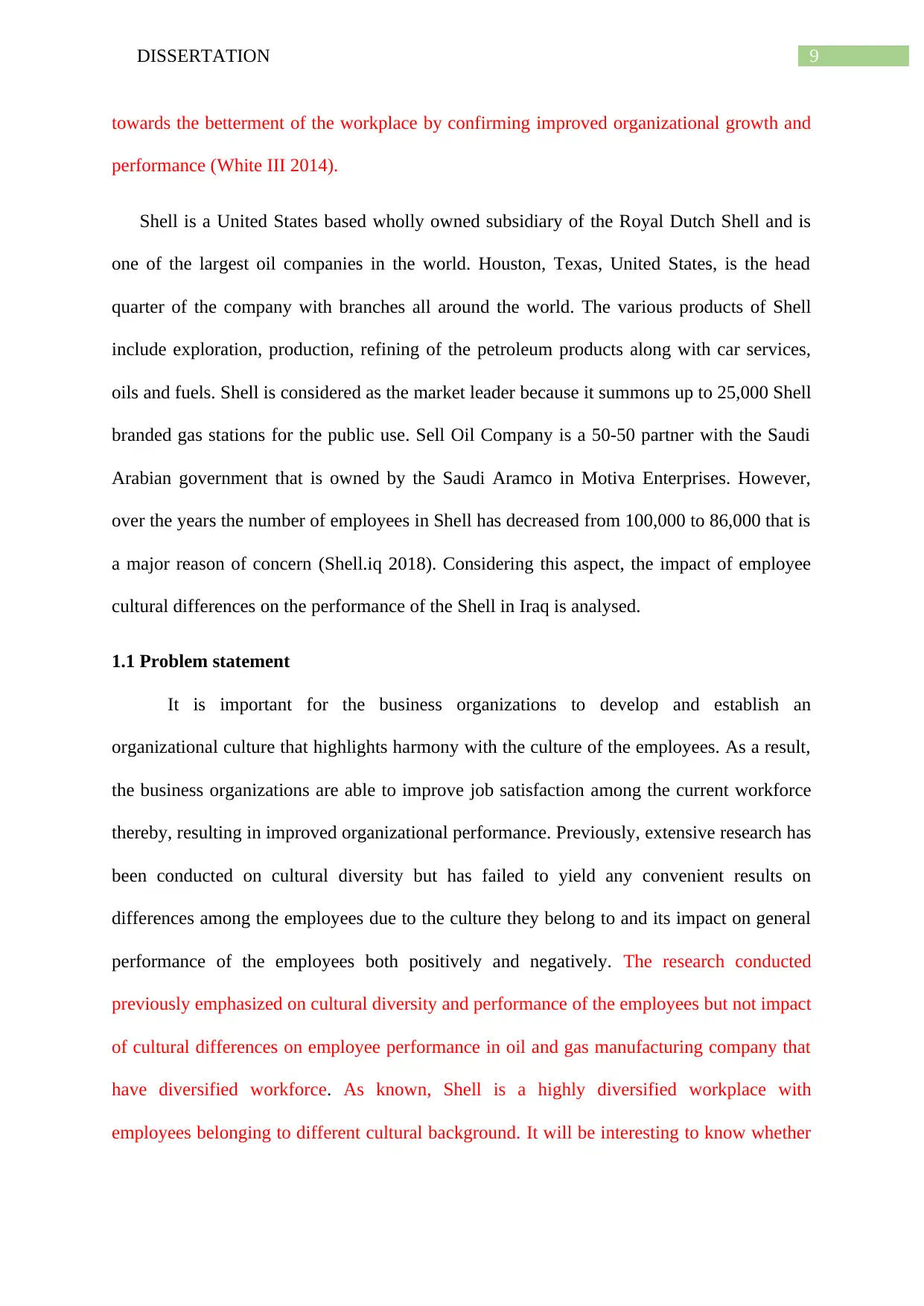
9DISSERTATION
towards the betterment of the workplace by confirming improved organizational growth and
performance (White III 2014).
Shell is a United States based wholly owned subsidiary of the Royal Dutch Shell and is
one of the largest oil companies in the world. Houston, Texas, United States, is the head
quarter of the company with branches all around the world. The various products of Shell
include exploration, production, refining of the petroleum products along with car services,
oils and fuels. Shell is considered as the market leader because it summons up to 25,000 Shell
branded gas stations for the public use. Sell Oil Company is a 50-50 partner with the Saudi
Arabian government that is owned by the Saudi Aramco in Motiva Enterprises. However,
over the years the number of employees in Shell has decreased from 100,000 to 86,000 that is
a major reason of concern (Shell.iq 2018). Considering this aspect, the impact of employee
cultural differences on the performance of the Shell in Iraq is analysed.
1.1 Problem statement
It is important for the business organizations to develop and establish an
organizational culture that highlights harmony with the culture of the employees. As a result,
the business organizations are able to improve job satisfaction among the current workforce
thereby, resulting in improved organizational performance. Previously, extensive research has
been conducted on cultural diversity but has failed to yield any convenient results on
differences among the employees due to the culture they belong to and its impact on general
performance of the employees both positively and negatively. The research conducted
previously emphasized on cultural diversity and performance of the employees but not impact
of cultural differences on employee performance in oil and gas manufacturing company that
have diversified workforce. As known, Shell is a highly diversified workplace with
employees belonging to different cultural background. It will be interesting to know whether
towards the betterment of the workplace by confirming improved organizational growth and
performance (White III 2014).
Shell is a United States based wholly owned subsidiary of the Royal Dutch Shell and is
one of the largest oil companies in the world. Houston, Texas, United States, is the head
quarter of the company with branches all around the world. The various products of Shell
include exploration, production, refining of the petroleum products along with car services,
oils and fuels. Shell is considered as the market leader because it summons up to 25,000 Shell
branded gas stations for the public use. Sell Oil Company is a 50-50 partner with the Saudi
Arabian government that is owned by the Saudi Aramco in Motiva Enterprises. However,
over the years the number of employees in Shell has decreased from 100,000 to 86,000 that is
a major reason of concern (Shell.iq 2018). Considering this aspect, the impact of employee
cultural differences on the performance of the Shell in Iraq is analysed.
1.1 Problem statement
It is important for the business organizations to develop and establish an
organizational culture that highlights harmony with the culture of the employees. As a result,
the business organizations are able to improve job satisfaction among the current workforce
thereby, resulting in improved organizational performance. Previously, extensive research has
been conducted on cultural diversity but has failed to yield any convenient results on
differences among the employees due to the culture they belong to and its impact on general
performance of the employees both positively and negatively. The research conducted
previously emphasized on cultural diversity and performance of the employees but not impact
of cultural differences on employee performance in oil and gas manufacturing company that
have diversified workforce. As known, Shell is a highly diversified workplace with
employees belonging to different cultural background. It will be interesting to know whether
Secure Best Marks with AI Grader
Need help grading? Try our AI Grader for instant feedback on your assignments.
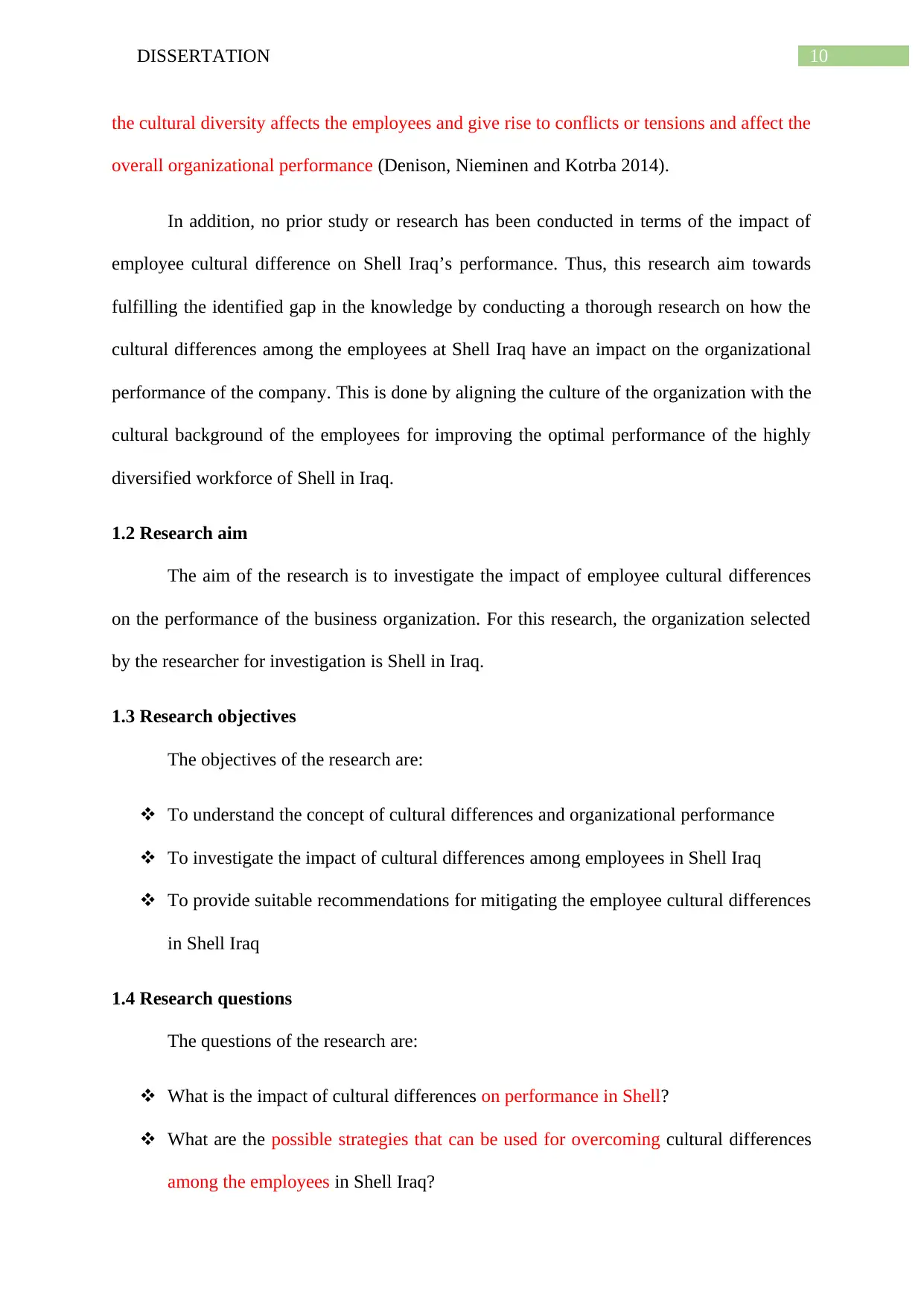
10DISSERTATION
the cultural diversity affects the employees and give rise to conflicts or tensions and affect the
overall organizational performance (Denison, Nieminen and Kotrba 2014).
In addition, no prior study or research has been conducted in terms of the impact of
employee cultural difference on Shell Iraq’s performance. Thus, this research aim towards
fulfilling the identified gap in the knowledge by conducting a thorough research on how the
cultural differences among the employees at Shell Iraq have an impact on the organizational
performance of the company. This is done by aligning the culture of the organization with the
cultural background of the employees for improving the optimal performance of the highly
diversified workforce of Shell in Iraq.
1.2 Research aim
The aim of the research is to investigate the impact of employee cultural differences
on the performance of the business organization. For this research, the organization selected
by the researcher for investigation is Shell in Iraq.
1.3 Research objectives
The objectives of the research are:
To understand the concept of cultural differences and organizational performance
To investigate the impact of cultural differences among employees in Shell Iraq
To provide suitable recommendations for mitigating the employee cultural differences
in Shell Iraq
1.4 Research questions
The questions of the research are:
What is the impact of cultural differences on performance in Shell?
What are the possible strategies that can be used for overcoming cultural differences
among the employees in Shell Iraq?
the cultural diversity affects the employees and give rise to conflicts or tensions and affect the
overall organizational performance (Denison, Nieminen and Kotrba 2014).
In addition, no prior study or research has been conducted in terms of the impact of
employee cultural difference on Shell Iraq’s performance. Thus, this research aim towards
fulfilling the identified gap in the knowledge by conducting a thorough research on how the
cultural differences among the employees at Shell Iraq have an impact on the organizational
performance of the company. This is done by aligning the culture of the organization with the
cultural background of the employees for improving the optimal performance of the highly
diversified workforce of Shell in Iraq.
1.2 Research aim
The aim of the research is to investigate the impact of employee cultural differences
on the performance of the business organization. For this research, the organization selected
by the researcher for investigation is Shell in Iraq.
1.3 Research objectives
The objectives of the research are:
To understand the concept of cultural differences and organizational performance
To investigate the impact of cultural differences among employees in Shell Iraq
To provide suitable recommendations for mitigating the employee cultural differences
in Shell Iraq
1.4 Research questions
The questions of the research are:
What is the impact of cultural differences on performance in Shell?
What are the possible strategies that can be used for overcoming cultural differences
among the employees in Shell Iraq?

11DISSERTATION
1.5 Research hypotheses
H0: Employee cultural differences do not have an impact on the performance of the
organization
H1: Employee cultural differences affect the performance of the organization largely
1.6 Research rationale
Taking into account the research topic that has been discussed in the above section, it
can be said that this is an important aspect for research because this will provide an
opportunity for investigating the influence on the cultural differences among the performance
of the employees for Shell Oil Company in Iraq. As a result, the research will allow
encouraging the trend if the outcome turns out to be positive (Singh, Darwish and Potocnik
2016).
On the other hand, upon encountering negative results the research can also prohibit
conducting further research on the cultural differences among the employees for improving
organizational growth and performance of Shell Oil Company in Iraq. This research also
highlights potential significance for the researchers and the academicians, as the findings of
the research will help in contributing towards the skills and knowledge that facilitate
improved organizational performance regardless of the existing cultural diversity among the
employees. In addition to, the findings of the research will also provide an opportunity for
other researchers to recognizing and addressing the gaps in the research that needs to be taken
into consideration in the future (Ovidiu-Iliuta 2014).
The research is also significant as the management of the Shell Oil Company in Iraq
will be able to gain adequate knowledge in terms of the impact of the performance of the
employees due to cultural differences along with developing strategies that facilitate Shell to
1.5 Research hypotheses
H0: Employee cultural differences do not have an impact on the performance of the
organization
H1: Employee cultural differences affect the performance of the organization largely
1.6 Research rationale
Taking into account the research topic that has been discussed in the above section, it
can be said that this is an important aspect for research because this will provide an
opportunity for investigating the influence on the cultural differences among the performance
of the employees for Shell Oil Company in Iraq. As a result, the research will allow
encouraging the trend if the outcome turns out to be positive (Singh, Darwish and Potocnik
2016).
On the other hand, upon encountering negative results the research can also prohibit
conducting further research on the cultural differences among the employees for improving
organizational growth and performance of Shell Oil Company in Iraq. This research also
highlights potential significance for the researchers and the academicians, as the findings of
the research will help in contributing towards the skills and knowledge that facilitate
improved organizational performance regardless of the existing cultural diversity among the
employees. In addition to, the findings of the research will also provide an opportunity for
other researchers to recognizing and addressing the gaps in the research that needs to be taken
into consideration in the future (Ovidiu-Iliuta 2014).
The research is also significant as the management of the Shell Oil Company in Iraq
will be able to gain adequate knowledge in terms of the impact of the performance of the
employees due to cultural differences along with developing strategies that facilitate Shell to
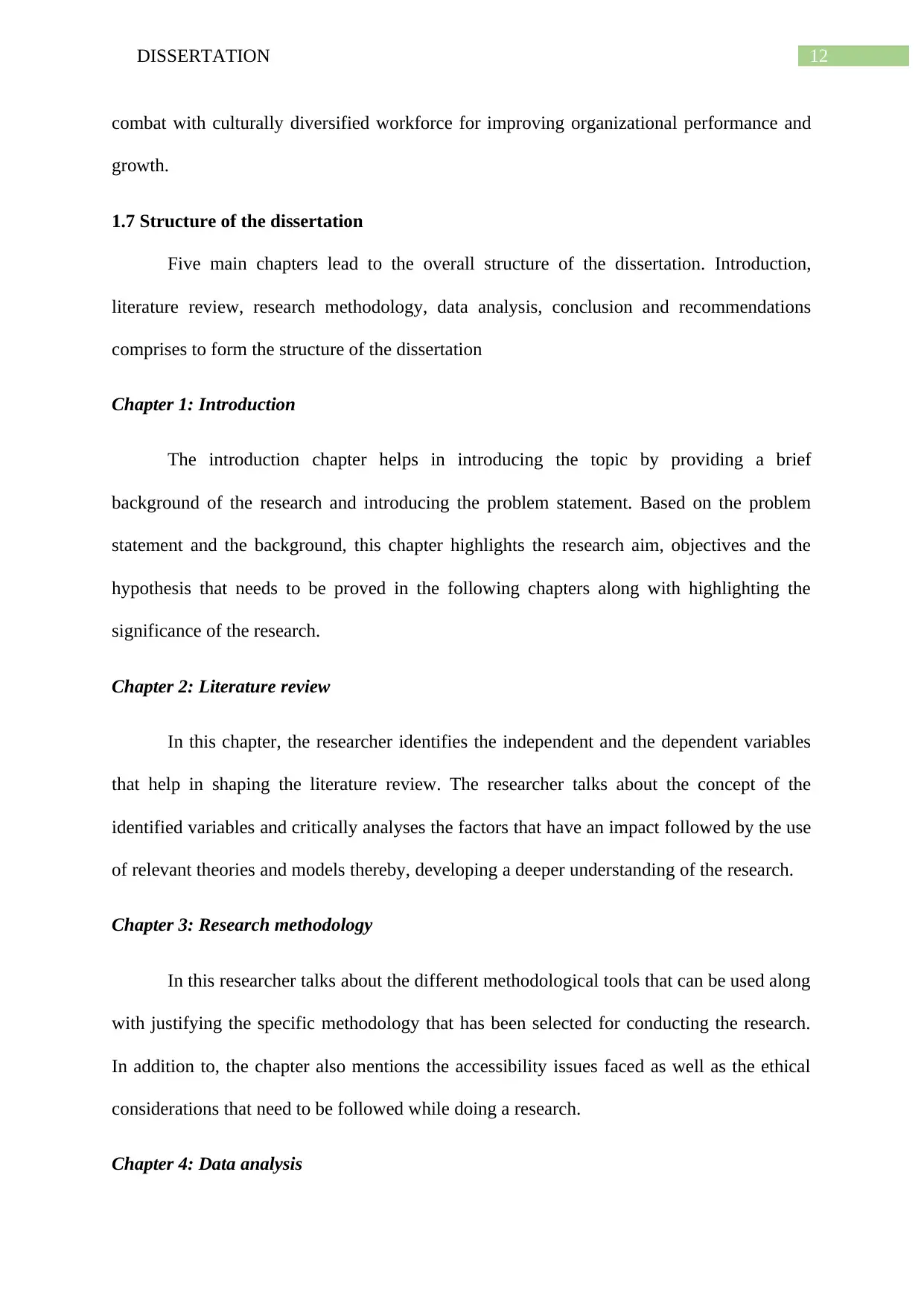
12DISSERTATION
combat with culturally diversified workforce for improving organizational performance and
growth.
1.7 Structure of the dissertation
Five main chapters lead to the overall structure of the dissertation. Introduction,
literature review, research methodology, data analysis, conclusion and recommendations
comprises to form the structure of the dissertation
Chapter 1: Introduction
The introduction chapter helps in introducing the topic by providing a brief
background of the research and introducing the problem statement. Based on the problem
statement and the background, this chapter highlights the research aim, objectives and the
hypothesis that needs to be proved in the following chapters along with highlighting the
significance of the research.
Chapter 2: Literature review
In this chapter, the researcher identifies the independent and the dependent variables
that help in shaping the literature review. The researcher talks about the concept of the
identified variables and critically analyses the factors that have an impact followed by the use
of relevant theories and models thereby, developing a deeper understanding of the research.
Chapter 3: Research methodology
In this researcher talks about the different methodological tools that can be used along
with justifying the specific methodology that has been selected for conducting the research.
In addition to, the chapter also mentions the accessibility issues faced as well as the ethical
considerations that need to be followed while doing a research.
Chapter 4: Data analysis
combat with culturally diversified workforce for improving organizational performance and
growth.
1.7 Structure of the dissertation
Five main chapters lead to the overall structure of the dissertation. Introduction,
literature review, research methodology, data analysis, conclusion and recommendations
comprises to form the structure of the dissertation
Chapter 1: Introduction
The introduction chapter helps in introducing the topic by providing a brief
background of the research and introducing the problem statement. Based on the problem
statement and the background, this chapter highlights the research aim, objectives and the
hypothesis that needs to be proved in the following chapters along with highlighting the
significance of the research.
Chapter 2: Literature review
In this chapter, the researcher identifies the independent and the dependent variables
that help in shaping the literature review. The researcher talks about the concept of the
identified variables and critically analyses the factors that have an impact followed by the use
of relevant theories and models thereby, developing a deeper understanding of the research.
Chapter 3: Research methodology
In this researcher talks about the different methodological tools that can be used along
with justifying the specific methodology that has been selected for conducting the research.
In addition to, the chapter also mentions the accessibility issues faced as well as the ethical
considerations that need to be followed while doing a research.
Chapter 4: Data analysis
Paraphrase This Document
Need a fresh take? Get an instant paraphrase of this document with our AI Paraphraser
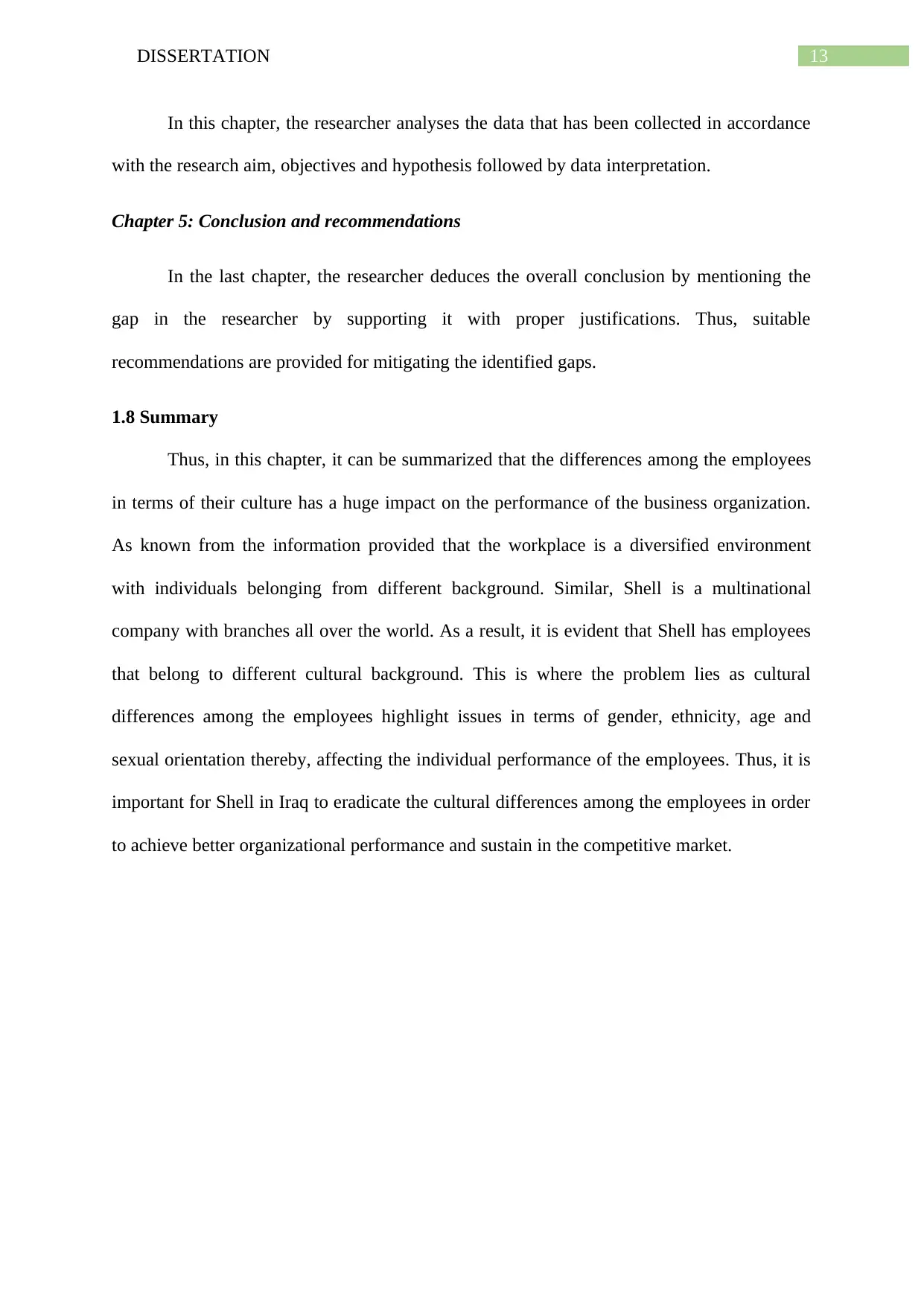
13DISSERTATION
In this chapter, the researcher analyses the data that has been collected in accordance
with the research aim, objectives and hypothesis followed by data interpretation.
Chapter 5: Conclusion and recommendations
In the last chapter, the researcher deduces the overall conclusion by mentioning the
gap in the researcher by supporting it with proper justifications. Thus, suitable
recommendations are provided for mitigating the identified gaps.
1.8 Summary
Thus, in this chapter, it can be summarized that the differences among the employees
in terms of their culture has a huge impact on the performance of the business organization.
As known from the information provided that the workplace is a diversified environment
with individuals belonging from different background. Similar, Shell is a multinational
company with branches all over the world. As a result, it is evident that Shell has employees
that belong to different cultural background. This is where the problem lies as cultural
differences among the employees highlight issues in terms of gender, ethnicity, age and
sexual orientation thereby, affecting the individual performance of the employees. Thus, it is
important for Shell in Iraq to eradicate the cultural differences among the employees in order
to achieve better organizational performance and sustain in the competitive market.
In this chapter, the researcher analyses the data that has been collected in accordance
with the research aim, objectives and hypothesis followed by data interpretation.
Chapter 5: Conclusion and recommendations
In the last chapter, the researcher deduces the overall conclusion by mentioning the
gap in the researcher by supporting it with proper justifications. Thus, suitable
recommendations are provided for mitigating the identified gaps.
1.8 Summary
Thus, in this chapter, it can be summarized that the differences among the employees
in terms of their culture has a huge impact on the performance of the business organization.
As known from the information provided that the workplace is a diversified environment
with individuals belonging from different background. Similar, Shell is a multinational
company with branches all over the world. As a result, it is evident that Shell has employees
that belong to different cultural background. This is where the problem lies as cultural
differences among the employees highlight issues in terms of gender, ethnicity, age and
sexual orientation thereby, affecting the individual performance of the employees. Thus, it is
important for Shell in Iraq to eradicate the cultural differences among the employees in order
to achieve better organizational performance and sustain in the competitive market.
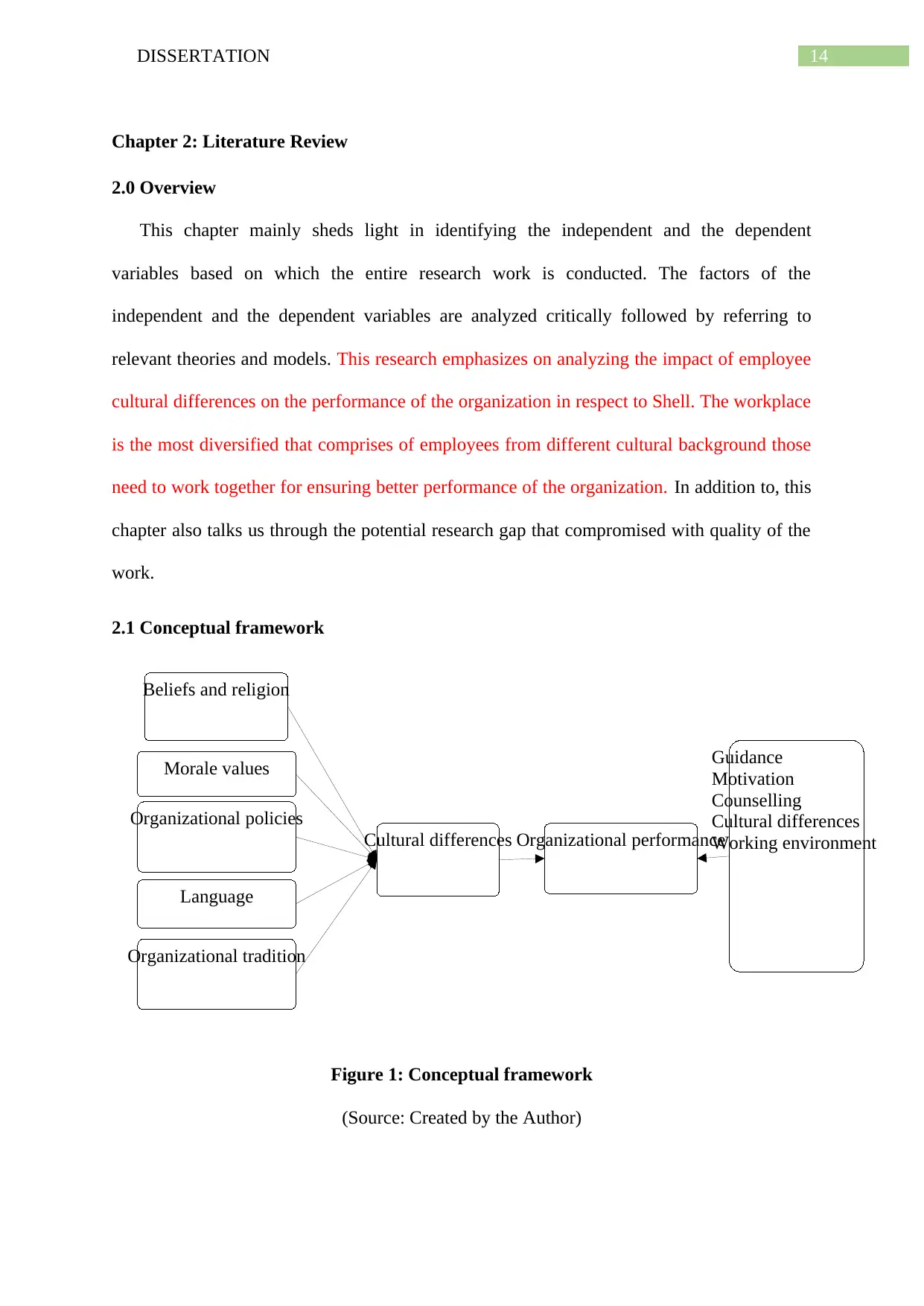
14DISSERTATION
Cultural differences
Beliefs and religion
Morale values
Organizational policies
Language
Organizational tradition
Organizational performance
Guidance
Motivation
Counselling
Cultural differences
Working environment
Chapter 2: Literature Review
2.0 Overview
This chapter mainly sheds light in identifying the independent and the dependent
variables based on which the entire research work is conducted. The factors of the
independent and the dependent variables are analyzed critically followed by referring to
relevant theories and models. This research emphasizes on analyzing the impact of employee
cultural differences on the performance of the organization in respect to Shell. The workplace
is the most diversified that comprises of employees from different cultural background those
need to work together for ensuring better performance of the organization. In addition to, this
chapter also talks us through the potential research gap that compromised with quality of the
work.
2.1 Conceptual framework
Figure 1: Conceptual framework
(Source: Created by the Author)
Cultural differences
Beliefs and religion
Morale values
Organizational policies
Language
Organizational tradition
Organizational performance
Guidance
Motivation
Counselling
Cultural differences
Working environment
Chapter 2: Literature Review
2.0 Overview
This chapter mainly sheds light in identifying the independent and the dependent
variables based on which the entire research work is conducted. The factors of the
independent and the dependent variables are analyzed critically followed by referring to
relevant theories and models. This research emphasizes on analyzing the impact of employee
cultural differences on the performance of the organization in respect to Shell. The workplace
is the most diversified that comprises of employees from different cultural background those
need to work together for ensuring better performance of the organization. In addition to, this
chapter also talks us through the potential research gap that compromised with quality of the
work.
2.1 Conceptual framework
Figure 1: Conceptual framework
(Source: Created by the Author)
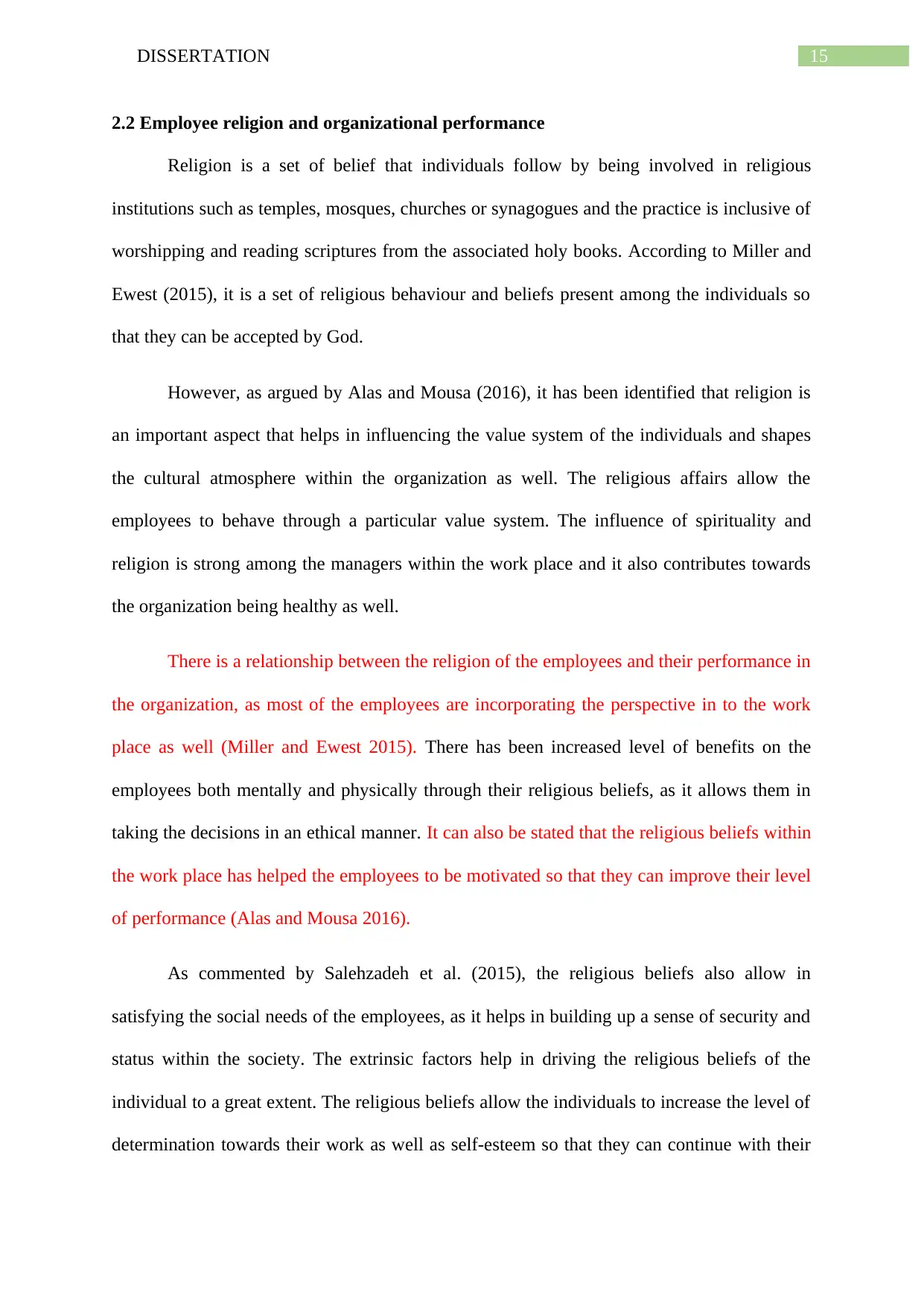
15DISSERTATION
2.2 Employee religion and organizational performance
Religion is a set of belief that individuals follow by being involved in religious
institutions such as temples, mosques, churches or synagogues and the practice is inclusive of
worshipping and reading scriptures from the associated holy books. According to Miller and
Ewest (2015), it is a set of religious behaviour and beliefs present among the individuals so
that they can be accepted by God.
However, as argued by Alas and Mousa (2016), it has been identified that religion is
an important aspect that helps in influencing the value system of the individuals and shapes
the cultural atmosphere within the organization as well. The religious affairs allow the
employees to behave through a particular value system. The influence of spirituality and
religion is strong among the managers within the work place and it also contributes towards
the organization being healthy as well.
There is a relationship between the religion of the employees and their performance in
the organization, as most of the employees are incorporating the perspective in to the work
place as well (Miller and Ewest 2015). There has been increased level of benefits on the
employees both mentally and physically through their religious beliefs, as it allows them in
taking the decisions in an ethical manner. It can also be stated that the religious beliefs within
the work place has helped the employees to be motivated so that they can improve their level
of performance (Alas and Mousa 2016).
As commented by Salehzadeh et al. (2015), the religious beliefs also allow in
satisfying the social needs of the employees, as it helps in building up a sense of security and
status within the society. The extrinsic factors help in driving the religious beliefs of the
individual to a great extent. The religious beliefs allow the individuals to increase the level of
determination towards their work as well as self-esteem so that they can continue with their
2.2 Employee religion and organizational performance
Religion is a set of belief that individuals follow by being involved in religious
institutions such as temples, mosques, churches or synagogues and the practice is inclusive of
worshipping and reading scriptures from the associated holy books. According to Miller and
Ewest (2015), it is a set of religious behaviour and beliefs present among the individuals so
that they can be accepted by God.
However, as argued by Alas and Mousa (2016), it has been identified that religion is
an important aspect that helps in influencing the value system of the individuals and shapes
the cultural atmosphere within the organization as well. The religious affairs allow the
employees to behave through a particular value system. The influence of spirituality and
religion is strong among the managers within the work place and it also contributes towards
the organization being healthy as well.
There is a relationship between the religion of the employees and their performance in
the organization, as most of the employees are incorporating the perspective in to the work
place as well (Miller and Ewest 2015). There has been increased level of benefits on the
employees both mentally and physically through their religious beliefs, as it allows them in
taking the decisions in an ethical manner. It can also be stated that the religious beliefs within
the work place has helped the employees to be motivated so that they can improve their level
of performance (Alas and Mousa 2016).
As commented by Salehzadeh et al. (2015), the religious beliefs also allow in
satisfying the social needs of the employees, as it helps in building up a sense of security and
status within the society. The extrinsic factors help in driving the religious beliefs of the
individual to a great extent. The religious beliefs allow the individuals to increase the level of
determination towards their work as well as self-esteem so that they can continue with their
Secure Best Marks with AI Grader
Need help grading? Try our AI Grader for instant feedback on your assignments.
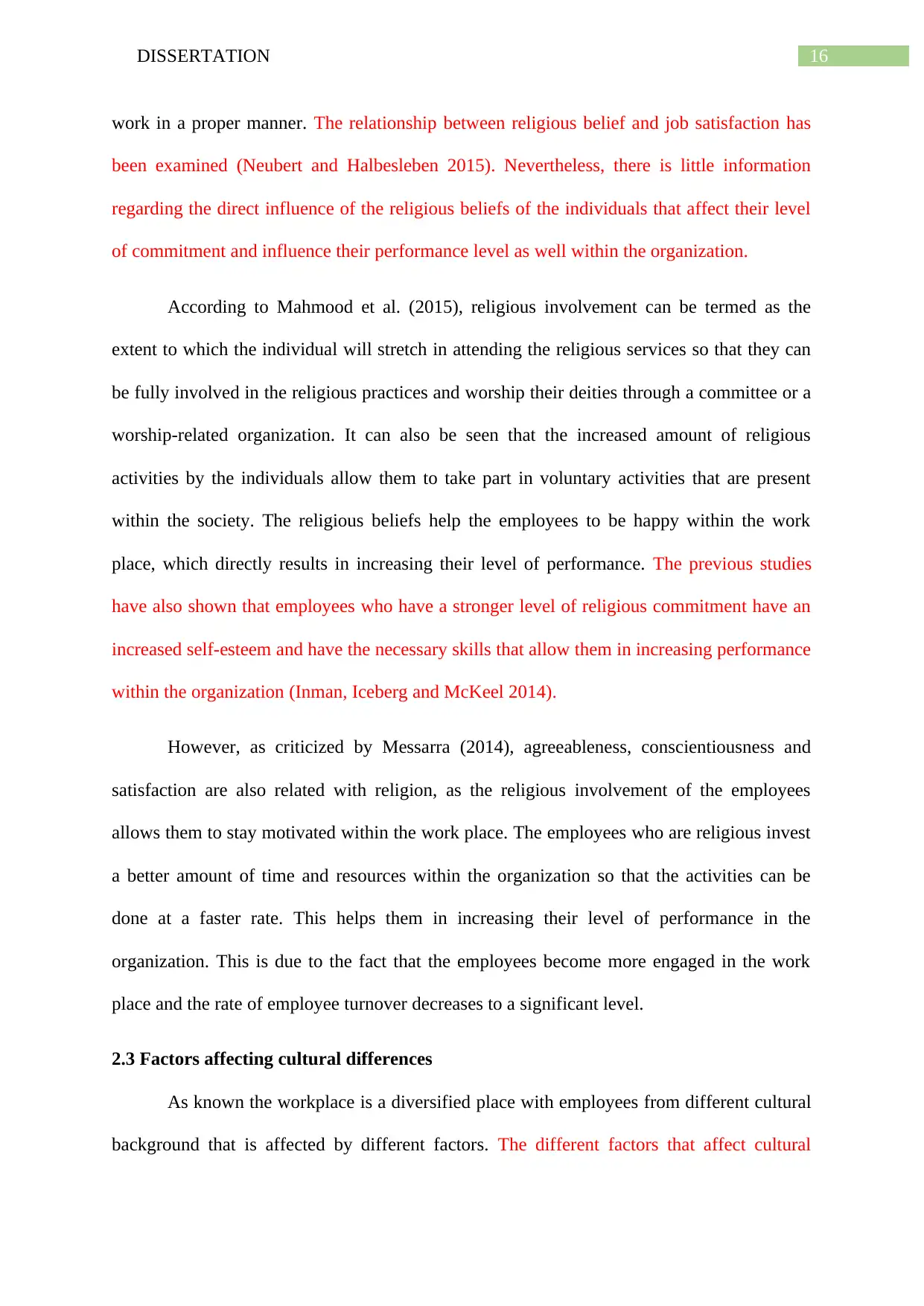
16DISSERTATION
work in a proper manner. The relationship between religious belief and job satisfaction has
been examined (Neubert and Halbesleben 2015). Nevertheless, there is little information
regarding the direct influence of the religious beliefs of the individuals that affect their level
of commitment and influence their performance level as well within the organization.
According to Mahmood et al. (2015), religious involvement can be termed as the
extent to which the individual will stretch in attending the religious services so that they can
be fully involved in the religious practices and worship their deities through a committee or a
worship-related organization. It can also be seen that the increased amount of religious
activities by the individuals allow them to take part in voluntary activities that are present
within the society. The religious beliefs help the employees to be happy within the work
place, which directly results in increasing their level of performance. The previous studies
have also shown that employees who have a stronger level of religious commitment have an
increased self-esteem and have the necessary skills that allow them in increasing performance
within the organization (Inman, Iceberg and McKeel 2014).
However, as criticized by Messarra (2014), agreeableness, conscientiousness and
satisfaction are also related with religion, as the religious involvement of the employees
allows them to stay motivated within the work place. The employees who are religious invest
a better amount of time and resources within the organization so that the activities can be
done at a faster rate. This helps them in increasing their level of performance in the
organization. This is due to the fact that the employees become more engaged in the work
place and the rate of employee turnover decreases to a significant level.
2.3 Factors affecting cultural differences
As known the workplace is a diversified place with employees from different cultural
background that is affected by different factors. The different factors that affect cultural
work in a proper manner. The relationship between religious belief and job satisfaction has
been examined (Neubert and Halbesleben 2015). Nevertheless, there is little information
regarding the direct influence of the religious beliefs of the individuals that affect their level
of commitment and influence their performance level as well within the organization.
According to Mahmood et al. (2015), religious involvement can be termed as the
extent to which the individual will stretch in attending the religious services so that they can
be fully involved in the religious practices and worship their deities through a committee or a
worship-related organization. It can also be seen that the increased amount of religious
activities by the individuals allow them to take part in voluntary activities that are present
within the society. The religious beliefs help the employees to be happy within the work
place, which directly results in increasing their level of performance. The previous studies
have also shown that employees who have a stronger level of religious commitment have an
increased self-esteem and have the necessary skills that allow them in increasing performance
within the organization (Inman, Iceberg and McKeel 2014).
However, as criticized by Messarra (2014), agreeableness, conscientiousness and
satisfaction are also related with religion, as the religious involvement of the employees
allows them to stay motivated within the work place. The employees who are religious invest
a better amount of time and resources within the organization so that the activities can be
done at a faster rate. This helps them in increasing their level of performance in the
organization. This is due to the fact that the employees become more engaged in the work
place and the rate of employee turnover decreases to a significant level.
2.3 Factors affecting cultural differences
As known the workplace is a diversified place with employees from different cultural
background that is affected by different factors. The different factors that affect cultural
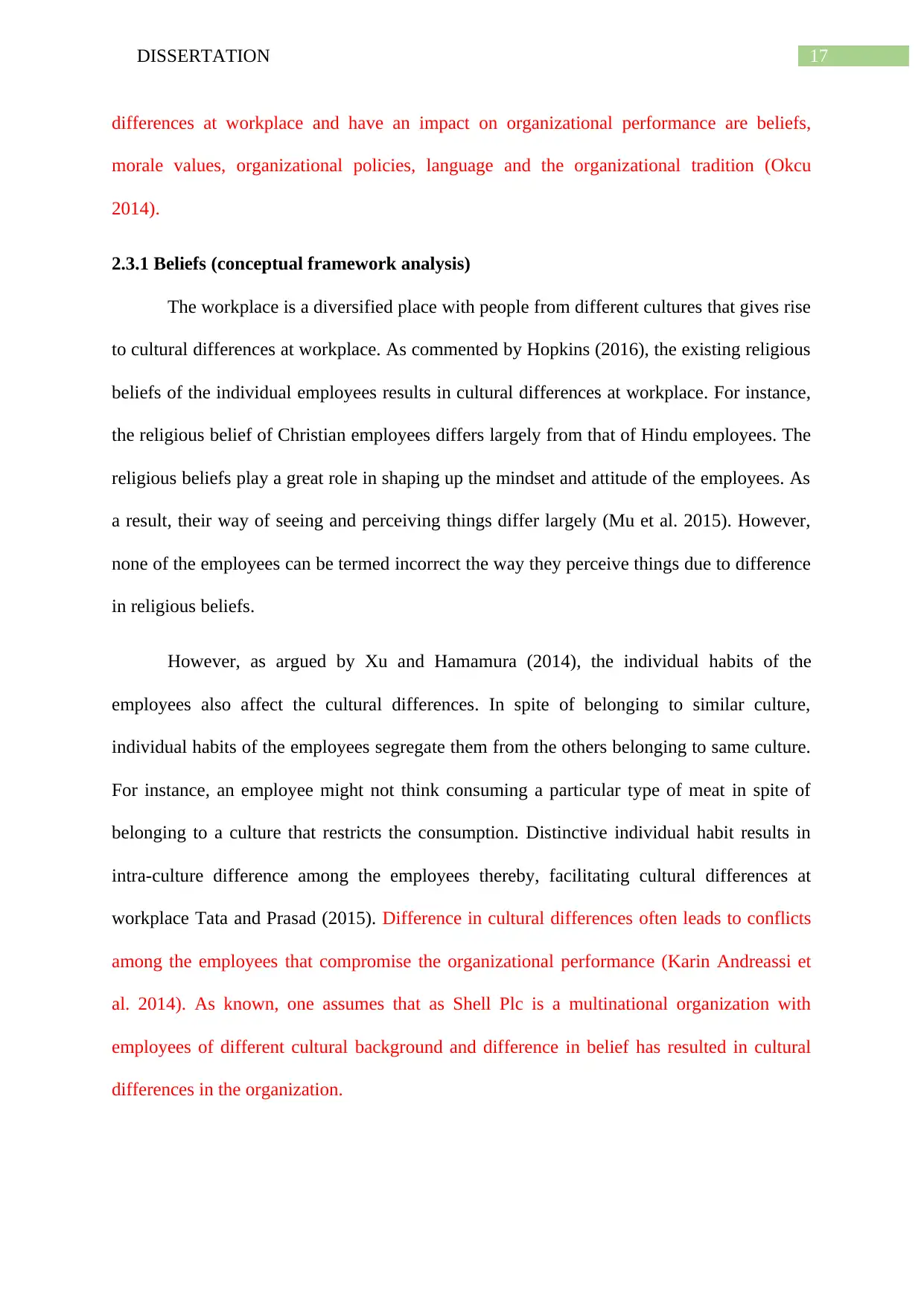
17DISSERTATION
differences at workplace and have an impact on organizational performance are beliefs,
morale values, organizational policies, language and the organizational tradition (Okcu
2014).
2.3.1 Beliefs (conceptual framework analysis)
The workplace is a diversified place with people from different cultures that gives rise
to cultural differences at workplace. As commented by Hopkins (2016), the existing religious
beliefs of the individual employees results in cultural differences at workplace. For instance,
the religious belief of Christian employees differs largely from that of Hindu employees. The
religious beliefs play a great role in shaping up the mindset and attitude of the employees. As
a result, their way of seeing and perceiving things differ largely (Mu et al. 2015). However,
none of the employees can be termed incorrect the way they perceive things due to difference
in religious beliefs.
However, as argued by Xu and Hamamura (2014), the individual habits of the
employees also affect the cultural differences. In spite of belonging to similar culture,
individual habits of the employees segregate them from the others belonging to same culture.
For instance, an employee might not think consuming a particular type of meat in spite of
belonging to a culture that restricts the consumption. Distinctive individual habit results in
intra-culture difference among the employees thereby, facilitating cultural differences at
workplace Tata and Prasad (2015). Difference in cultural differences often leads to conflicts
among the employees that compromise the organizational performance (Karin Andreassi et
al. 2014). As known, one assumes that as Shell Plc is a multinational organization with
employees of different cultural background and difference in belief has resulted in cultural
differences in the organization.
differences at workplace and have an impact on organizational performance are beliefs,
morale values, organizational policies, language and the organizational tradition (Okcu
2014).
2.3.1 Beliefs (conceptual framework analysis)
The workplace is a diversified place with people from different cultures that gives rise
to cultural differences at workplace. As commented by Hopkins (2016), the existing religious
beliefs of the individual employees results in cultural differences at workplace. For instance,
the religious belief of Christian employees differs largely from that of Hindu employees. The
religious beliefs play a great role in shaping up the mindset and attitude of the employees. As
a result, their way of seeing and perceiving things differ largely (Mu et al. 2015). However,
none of the employees can be termed incorrect the way they perceive things due to difference
in religious beliefs.
However, as argued by Xu and Hamamura (2014), the individual habits of the
employees also affect the cultural differences. In spite of belonging to similar culture,
individual habits of the employees segregate them from the others belonging to same culture.
For instance, an employee might not think consuming a particular type of meat in spite of
belonging to a culture that restricts the consumption. Distinctive individual habit results in
intra-culture difference among the employees thereby, facilitating cultural differences at
workplace Tata and Prasad (2015). Difference in cultural differences often leads to conflicts
among the employees that compromise the organizational performance (Karin Andreassi et
al. 2014). As known, one assumes that as Shell Plc is a multinational organization with
employees of different cultural background and difference in belief has resulted in cultural
differences in the organization.

18DISSERTATION
2.3.2 Moral values
The moral values of the employees play a significant role in influencing the cultural
differences at workplace. It is evident that employees have individual principles that they
intend to follow regardless of anything happening in the surrounding. As commented by
Graham et al. (2016), the nature of the work in an organization results in cultural differences.
This is because the employees have certain mind set and opinion about how things should be
conducted at workplace. When they have to go out of their comfort zone due to the nature of
work, cultural differences arise. This often results in conflicts between the employees and the
management, as the management forces the employees to do things that is against their
nature.
However, as criticized by Mu et al. (2015), individual level of satisfaction also affects
the cultural difference within the organization. Satisfaction is an individual thing that depends
on the attitude and habit of individual employees. It is supposed that if the employees are not
satisfied with the existing culture of the organization, differences are witnessed. For instance,
the nature of equal treatment is not satisfactory for the employees within the organization,
cultural differences occur (Dusterhoff, Cunningham and MacGregor 2014). As known Shell
Plc is a multinational company operating worldwide including Iraq and the moral values of
the employees are questioned that gives rise to cultural differences.
2.3.3 Organizational policies
Organizational policies are defined as the set of principles, guidelines and rules
adopted by an organization for achieving its long-term goal. However, while adopting
policies, the organization needs to consider the needs and expectations of the employees in
order to ensure that the policies do not raise conflicts based on cultures. According to Belias
and Koustelios (2014), organizational policy needs to promote and facilitate equal
employment regardless of the cultural background. If the organizational policy developed
2.3.2 Moral values
The moral values of the employees play a significant role in influencing the cultural
differences at workplace. It is evident that employees have individual principles that they
intend to follow regardless of anything happening in the surrounding. As commented by
Graham et al. (2016), the nature of the work in an organization results in cultural differences.
This is because the employees have certain mind set and opinion about how things should be
conducted at workplace. When they have to go out of their comfort zone due to the nature of
work, cultural differences arise. This often results in conflicts between the employees and the
management, as the management forces the employees to do things that is against their
nature.
However, as criticized by Mu et al. (2015), individual level of satisfaction also affects
the cultural difference within the organization. Satisfaction is an individual thing that depends
on the attitude and habit of individual employees. It is supposed that if the employees are not
satisfied with the existing culture of the organization, differences are witnessed. For instance,
the nature of equal treatment is not satisfactory for the employees within the organization,
cultural differences occur (Dusterhoff, Cunningham and MacGregor 2014). As known Shell
Plc is a multinational company operating worldwide including Iraq and the moral values of
the employees are questioned that gives rise to cultural differences.
2.3.3 Organizational policies
Organizational policies are defined as the set of principles, guidelines and rules
adopted by an organization for achieving its long-term goal. However, while adopting
policies, the organization needs to consider the needs and expectations of the employees in
order to ensure that the policies do not raise conflicts based on cultures. According to Belias
and Koustelios (2014), organizational policy needs to promote and facilitate equal
employment regardless of the cultural background. If the organizational policy developed
Paraphrase This Document
Need a fresh take? Get an instant paraphrase of this document with our AI Paraphraser

19DISSERTATION
fails to promote equal employment for all the employees, cultural differences are prevalent.
For instance, a Christian employee should be given equal employment terms and conditions
as given to an employee belonging to another culture. In addition, equal employment should
also be provided irrespective of gender of the employees.
However, as argued by White III (2014), the incentive policy of an organization
should also be equal for mitigating cultural differences in the workplace. Each employee
should be given equal terms and conditions of earning incentives and this should be affected
by the cultural background of the employees. Difference in organizational policies hampers
the working environment and dedication of the employees, as they feel other employees are
valued more compared to them resulting in lack of dedication and commitment towards their
job roles and responsibilities. Organizational policies in Shell Plc are questioned, as the
policies fail to ensure equal treatment to all the employees regardless of their cultural
background and gender thereby, affecting the organizational performance negatively.
2.3.4 Language
Each language has embedded cultural overtones due to which the culture of a country
is expressed highly through language. As commented by Heine (2015), use of different native
language can result in cultural difference within an organization. As a result, it is advisable
that the workplace should have a specific language that each employee should be able to use
and understand. Making a single language mandatory ensures that no particular language of
any culture is given more preference than others thereby, restricting the chances of cultural
differences based on language issues. However, in Shell Plc in Iraq the use of native language
for informal purpose such as communication between the employees for casual purpose is
resulting in cultural differences. This is because not all the employees are able to understand
the native language and they feel that they are not considered as a part of the organization and
feel free in communicating.
fails to promote equal employment for all the employees, cultural differences are prevalent.
For instance, a Christian employee should be given equal employment terms and conditions
as given to an employee belonging to another culture. In addition, equal employment should
also be provided irrespective of gender of the employees.
However, as argued by White III (2014), the incentive policy of an organization
should also be equal for mitigating cultural differences in the workplace. Each employee
should be given equal terms and conditions of earning incentives and this should be affected
by the cultural background of the employees. Difference in organizational policies hampers
the working environment and dedication of the employees, as they feel other employees are
valued more compared to them resulting in lack of dedication and commitment towards their
job roles and responsibilities. Organizational policies in Shell Plc are questioned, as the
policies fail to ensure equal treatment to all the employees regardless of their cultural
background and gender thereby, affecting the organizational performance negatively.
2.3.4 Language
Each language has embedded cultural overtones due to which the culture of a country
is expressed highly through language. As commented by Heine (2015), use of different native
language can result in cultural difference within an organization. As a result, it is advisable
that the workplace should have a specific language that each employee should be able to use
and understand. Making a single language mandatory ensures that no particular language of
any culture is given more preference than others thereby, restricting the chances of cultural
differences based on language issues. However, in Shell Plc in Iraq the use of native language
for informal purpose such as communication between the employees for casual purpose is
resulting in cultural differences. This is because not all the employees are able to understand
the native language and they feel that they are not considered as a part of the organization and
feel free in communicating.

20DISSERTATION
2.3.5 Organizational tradition
The organizational tradition plays a crucial role in influencing cultural difference at
workplace. According to Christensen et al. (2014), the tradition of having a leader with layers
of subordinates to follow highlights positive behavior and organizational culture. As a result,
the employees develop a sense of trust and respect about the fellow colleagues and works
with a friendly approach. This helps in keeping all the employees aligned and works together
without influencing the rise of cultural differences among the employees. In Shell Plc, the
organization lacks traditional structure due to which cultural differences have come into
existence that has affected the organizational performance negatively.
2.4 Relationship between employee value system and organizational performance
Different humans have different goals based on which they are expected to work
within the organization. As mentioned by Mason (2014), this is due to the fact that they
follow different cultures and are able to make the decisions in a different manner than others.
The values that are instilled within the individuals are effective and acceptable with respect to
their cultural aspects. Most of the individuals are governed through a set of values, which
helps them in treating others with courtesy. The company cannot create an impact on the
values and behaviours of the individuals before hiring them in the organization.
However, as criticized by Bhatti et al. (2016), the rewards and punishment system
needs to be present in the organization so that it can help in fostering the values of the
employees within the company and their behaviour can be monitored. The reward system
within the organization will help the employees in showing their best behaviour towards the
work so that they can earn it, which will also increase their values. The values that are present
in the employees are transcended through experiences that allow them in taking the decisions
in a better manner.
2.3.5 Organizational tradition
The organizational tradition plays a crucial role in influencing cultural difference at
workplace. According to Christensen et al. (2014), the tradition of having a leader with layers
of subordinates to follow highlights positive behavior and organizational culture. As a result,
the employees develop a sense of trust and respect about the fellow colleagues and works
with a friendly approach. This helps in keeping all the employees aligned and works together
without influencing the rise of cultural differences among the employees. In Shell Plc, the
organization lacks traditional structure due to which cultural differences have come into
existence that has affected the organizational performance negatively.
2.4 Relationship between employee value system and organizational performance
Different humans have different goals based on which they are expected to work
within the organization. As mentioned by Mason (2014), this is due to the fact that they
follow different cultures and are able to make the decisions in a different manner than others.
The values that are instilled within the individuals are effective and acceptable with respect to
their cultural aspects. Most of the individuals are governed through a set of values, which
helps them in treating others with courtesy. The company cannot create an impact on the
values and behaviours of the individuals before hiring them in the organization.
However, as criticized by Bhatti et al. (2016), the rewards and punishment system
needs to be present in the organization so that it can help in fostering the values of the
employees within the company and their behaviour can be monitored. The reward system
within the organization will help the employees in showing their best behaviour towards the
work so that they can earn it, which will also increase their values. The values that are present
in the employees are transcended through experiences that allow them in taking the decisions
in a better manner.
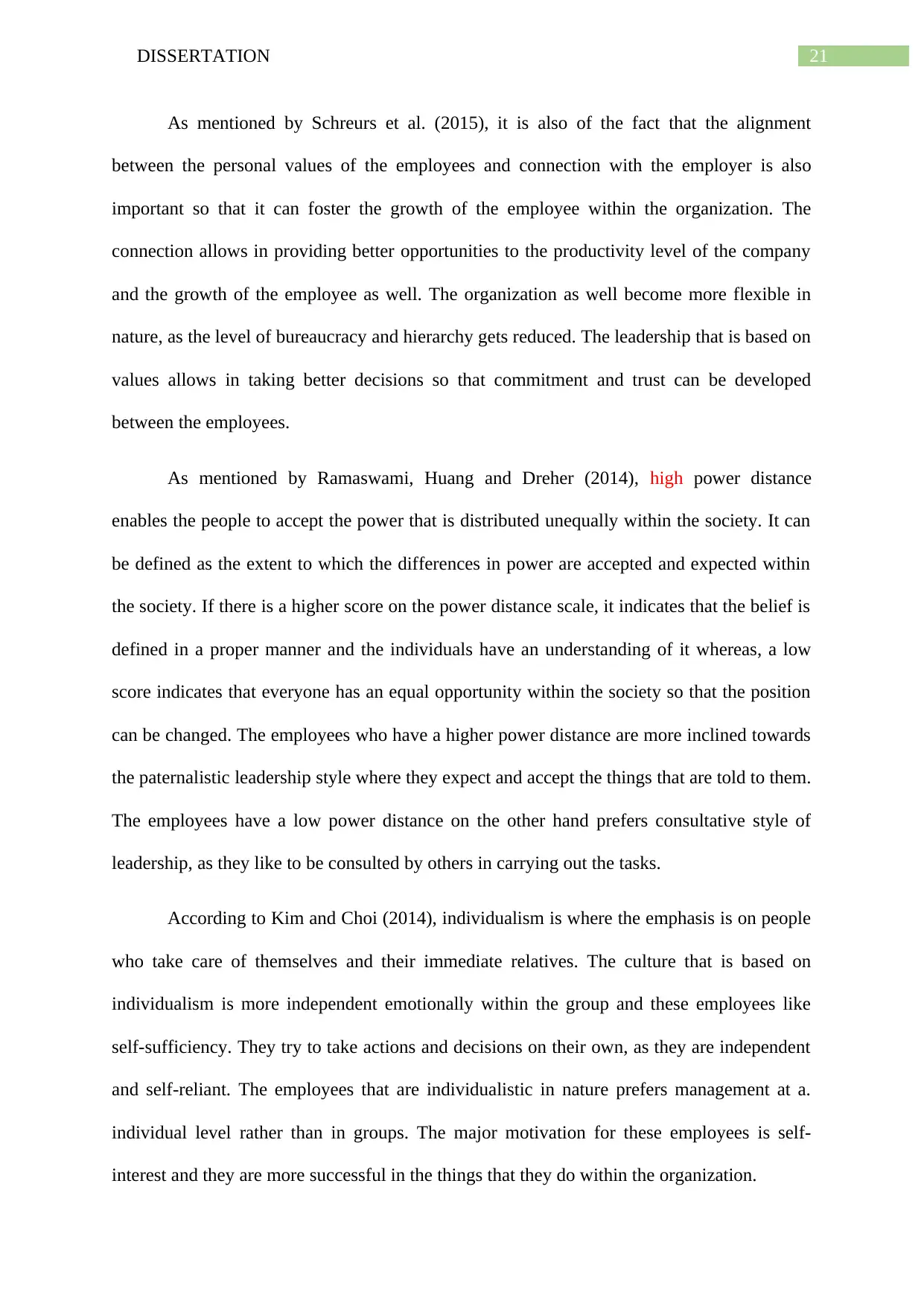
21DISSERTATION
As mentioned by Schreurs et al. (2015), it is also of the fact that the alignment
between the personal values of the employees and connection with the employer is also
important so that it can foster the growth of the employee within the organization. The
connection allows in providing better opportunities to the productivity level of the company
and the growth of the employee as well. The organization as well become more flexible in
nature, as the level of bureaucracy and hierarchy gets reduced. The leadership that is based on
values allows in taking better decisions so that commitment and trust can be developed
between the employees.
As mentioned by Ramaswami, Huang and Dreher (2014), high power distance
enables the people to accept the power that is distributed unequally within the society. It can
be defined as the extent to which the differences in power are accepted and expected within
the society. If there is a higher score on the power distance scale, it indicates that the belief is
defined in a proper manner and the individuals have an understanding of it whereas, a low
score indicates that everyone has an equal opportunity within the society so that the position
can be changed. The employees who have a higher power distance are more inclined towards
the paternalistic leadership style where they expect and accept the things that are told to them.
The employees have a low power distance on the other hand prefers consultative style of
leadership, as they like to be consulted by others in carrying out the tasks.
According to Kim and Choi (2014), individualism is where the emphasis is on people
who take care of themselves and their immediate relatives. The culture that is based on
individualism is more independent emotionally within the group and these employees like
self-sufficiency. They try to take actions and decisions on their own, as they are independent
and self-reliant. The employees that are individualistic in nature prefers management at a.
individual level rather than in groups. The major motivation for these employees is self-
interest and they are more successful in the things that they do within the organization.
As mentioned by Schreurs et al. (2015), it is also of the fact that the alignment
between the personal values of the employees and connection with the employer is also
important so that it can foster the growth of the employee within the organization. The
connection allows in providing better opportunities to the productivity level of the company
and the growth of the employee as well. The organization as well become more flexible in
nature, as the level of bureaucracy and hierarchy gets reduced. The leadership that is based on
values allows in taking better decisions so that commitment and trust can be developed
between the employees.
As mentioned by Ramaswami, Huang and Dreher (2014), high power distance
enables the people to accept the power that is distributed unequally within the society. It can
be defined as the extent to which the differences in power are accepted and expected within
the society. If there is a higher score on the power distance scale, it indicates that the belief is
defined in a proper manner and the individuals have an understanding of it whereas, a low
score indicates that everyone has an equal opportunity within the society so that the position
can be changed. The employees who have a higher power distance are more inclined towards
the paternalistic leadership style where they expect and accept the things that are told to them.
The employees have a low power distance on the other hand prefers consultative style of
leadership, as they like to be consulted by others in carrying out the tasks.
According to Kim and Choi (2014), individualism is where the emphasis is on people
who take care of themselves and their immediate relatives. The culture that is based on
individualism is more independent emotionally within the group and these employees like
self-sufficiency. They try to take actions and decisions on their own, as they are independent
and self-reliant. The employees that are individualistic in nature prefers management at a.
individual level rather than in groups. The major motivation for these employees is self-
interest and they are more successful in the things that they do within the organization.
Secure Best Marks with AI Grader
Need help grading? Try our AI Grader for instant feedback on your assignments.
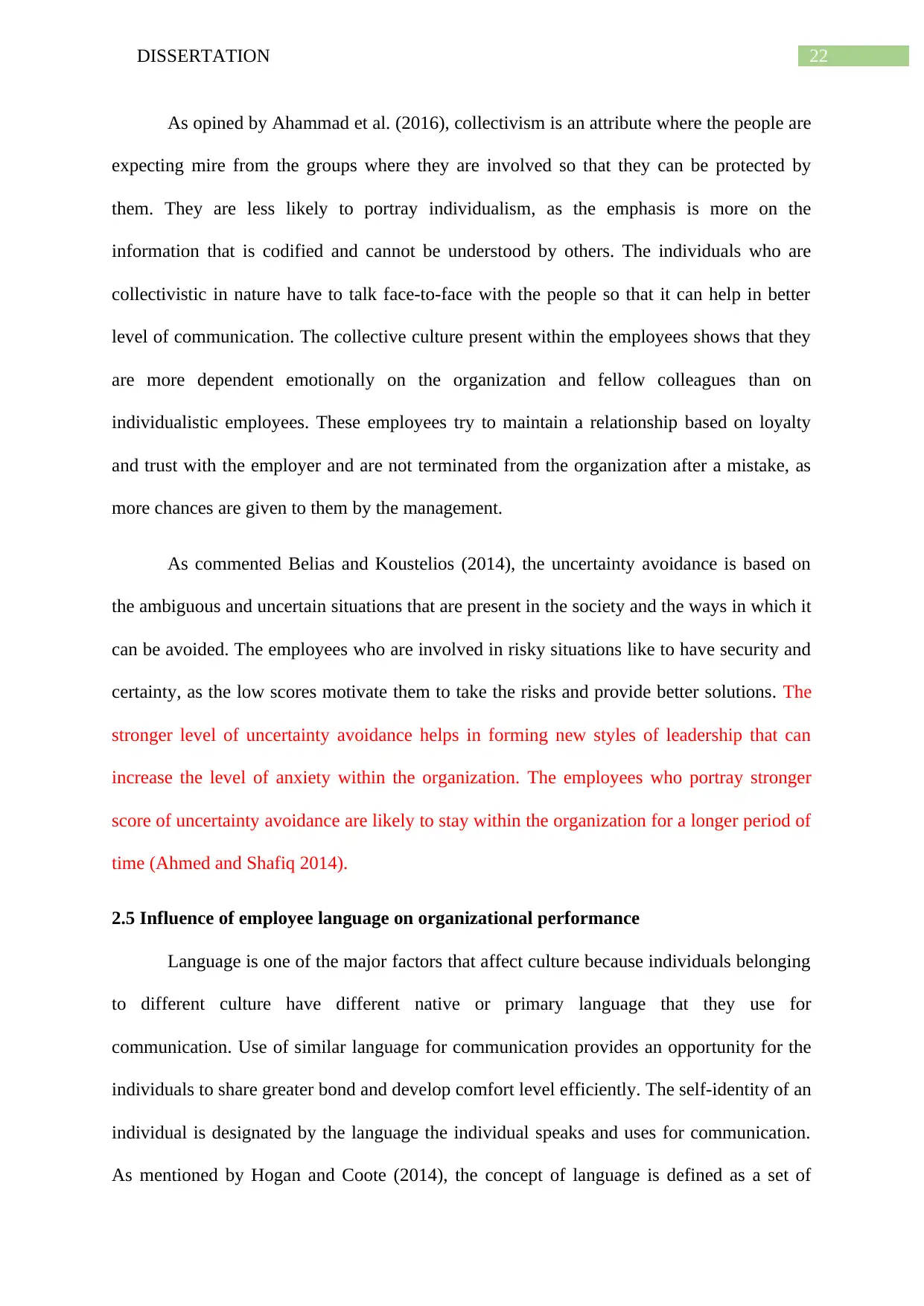
22DISSERTATION
As opined by Ahammad et al. (2016), collectivism is an attribute where the people are
expecting mire from the groups where they are involved so that they can be protected by
them. They are less likely to portray individualism, as the emphasis is more on the
information that is codified and cannot be understood by others. The individuals who are
collectivistic in nature have to talk face-to-face with the people so that it can help in better
level of communication. The collective culture present within the employees shows that they
are more dependent emotionally on the organization and fellow colleagues than on
individualistic employees. These employees try to maintain a relationship based on loyalty
and trust with the employer and are not terminated from the organization after a mistake, as
more chances are given to them by the management.
As commented Belias and Koustelios (2014), the uncertainty avoidance is based on
the ambiguous and uncertain situations that are present in the society and the ways in which it
can be avoided. The employees who are involved in risky situations like to have security and
certainty, as the low scores motivate them to take the risks and provide better solutions. The
stronger level of uncertainty avoidance helps in forming new styles of leadership that can
increase the level of anxiety within the organization. The employees who portray stronger
score of uncertainty avoidance are likely to stay within the organization for a longer period of
time (Ahmed and Shafiq 2014).
2.5 Influence of employee language on organizational performance
Language is one of the major factors that affect culture because individuals belonging
to different culture have different native or primary language that they use for
communication. Use of similar language for communication provides an opportunity for the
individuals to share greater bond and develop comfort level efficiently. The self-identity of an
individual is designated by the language the individual speaks and uses for communication.
As mentioned by Hogan and Coote (2014), the concept of language is defined as a set of
As opined by Ahammad et al. (2016), collectivism is an attribute where the people are
expecting mire from the groups where they are involved so that they can be protected by
them. They are less likely to portray individualism, as the emphasis is more on the
information that is codified and cannot be understood by others. The individuals who are
collectivistic in nature have to talk face-to-face with the people so that it can help in better
level of communication. The collective culture present within the employees shows that they
are more dependent emotionally on the organization and fellow colleagues than on
individualistic employees. These employees try to maintain a relationship based on loyalty
and trust with the employer and are not terminated from the organization after a mistake, as
more chances are given to them by the management.
As commented Belias and Koustelios (2014), the uncertainty avoidance is based on
the ambiguous and uncertain situations that are present in the society and the ways in which it
can be avoided. The employees who are involved in risky situations like to have security and
certainty, as the low scores motivate them to take the risks and provide better solutions. The
stronger level of uncertainty avoidance helps in forming new styles of leadership that can
increase the level of anxiety within the organization. The employees who portray stronger
score of uncertainty avoidance are likely to stay within the organization for a longer period of
time (Ahmed and Shafiq 2014).
2.5 Influence of employee language on organizational performance
Language is one of the major factors that affect culture because individuals belonging
to different culture have different native or primary language that they use for
communication. Use of similar language for communication provides an opportunity for the
individuals to share greater bond and develop comfort level efficiently. The self-identity of an
individual is designated by the language the individual speaks and uses for communication.
As mentioned by Hogan and Coote (2014), the concept of language is defined as a set of

23DISSERTATION
conceptual symbols that provides an opportunity for the individuals to communicate and
share and bond with each other. Language is an integral part of any culture and is important
in every aspect of life. The individuals portray their identity by the language they use to
communicate and also use it for expressing feelings, sharing knowledge and complex
messages.
Difference has been found in natural and corporate language, as colloquial language
cannot be used in the corporate sector. Selection of language in accordance with the culture is
crucial for ensuring improved organizational performance. However, argued by Bordia and
Bordia (2015), the decision makers of the company need to select the language they use for
the organizational communication wisely. This is because appropriate selection of the
language facilitates shaping and bounding the focus of the company followed by articulation
of the strategic opinions. As the workplace is a diversified environment with employees from
different background, the language selected and used by the business organization both
facilitate and restrict the strategic performance and growth of the company. This is also
supported by Dugguh and Dennis (2014) that states that language can be one of the
significant barriers between individual employees belonging to distinctive cultures. The
language barrier eventually gives rise to hindrances in service experience thereby, becoming
a major issue during intercultural working environment at the organizations.
However, as mentioned by Yamao and Sekiguchi (2015), individual employees
develop negative approach towards each other when they are unable to connect and identify
with fellow colleagues belonging to other cultures due to language differences. Ignorance due
to such cultural differences restricts communication among the employees working for the
same organizations thereby, hampering the organizational performance. However as argued
by Sumelius et al. (2014), language also prevents effective communication with the
customers. This is because the business organizations also encounter customers belonging to
conceptual symbols that provides an opportunity for the individuals to communicate and
share and bond with each other. Language is an integral part of any culture and is important
in every aspect of life. The individuals portray their identity by the language they use to
communicate and also use it for expressing feelings, sharing knowledge and complex
messages.
Difference has been found in natural and corporate language, as colloquial language
cannot be used in the corporate sector. Selection of language in accordance with the culture is
crucial for ensuring improved organizational performance. However, argued by Bordia and
Bordia (2015), the decision makers of the company need to select the language they use for
the organizational communication wisely. This is because appropriate selection of the
language facilitates shaping and bounding the focus of the company followed by articulation
of the strategic opinions. As the workplace is a diversified environment with employees from
different background, the language selected and used by the business organization both
facilitate and restrict the strategic performance and growth of the company. This is also
supported by Dugguh and Dennis (2014) that states that language can be one of the
significant barriers between individual employees belonging to distinctive cultures. The
language barrier eventually gives rise to hindrances in service experience thereby, becoming
a major issue during intercultural working environment at the organizations.
However, as mentioned by Yamao and Sekiguchi (2015), individual employees
develop negative approach towards each other when they are unable to connect and identify
with fellow colleagues belonging to other cultures due to language differences. Ignorance due
to such cultural differences restricts communication among the employees working for the
same organizations thereby, hampering the organizational performance. However as argued
by Sumelius et al. (2014), language also prevents effective communication with the
customers. This is because the business organizations also encounter customers belonging to

24DISSERTATION
different cultures and speaking different languages. Organizational performance is also
determined by the way the employees treat the customers. But cultural differences results in
language barrier and restricts effective communication with the customer due to which the
organizational performance is hindered.
As mentioned by Oyemomi et al. (2016), communication among employees speaking
different languages can be difficult thereby, making it difficult in expressing individual
thoughts and opinions to others efficiently. For example, employees who are unfamiliar with
the primary language used at workplace encounter difficulty in responding to requests by
fellow colleagues as well as expressing their needs and sharing their opinions in terms of
improving organizational performance. At certain instances, misleading or incorrect
information can also be cascaded in the organization due to lack of fluency of the primary
language used at the workplace due to cultural differences. However, as criticized by Wu,
Straub and Liang (2015), language barrier at workplace due to cultural differences results in
developing working environment where the employees lack knowledge and information
about the company. Both verbal and non-verbal communications are important for an
organization to be successful. This is because transferring the linguistic signals to individuals
of different culture fails to transfer the actual meaning of the message. This is further argued
by Zohar and Polachek (2014), language is more important in knowledge sharing within the
business organizations. Ineffective communication due to cultural difference in terms of
language restricts the sharing of language among the employees. As a result, the employees
are unable to share the knowledge they have with each other thereby, restricting the attitude
of knowledge sharing.
As mentioned by Helmreich and Merritt (2017), individual employees of different
cultures exhibit emotions differently thereby, displaying emotions cultures that are different
from culture to culture. For example, for some culture expressing anger, fear and frustration
different cultures and speaking different languages. Organizational performance is also
determined by the way the employees treat the customers. But cultural differences results in
language barrier and restricts effective communication with the customer due to which the
organizational performance is hindered.
As mentioned by Oyemomi et al. (2016), communication among employees speaking
different languages can be difficult thereby, making it difficult in expressing individual
thoughts and opinions to others efficiently. For example, employees who are unfamiliar with
the primary language used at workplace encounter difficulty in responding to requests by
fellow colleagues as well as expressing their needs and sharing their opinions in terms of
improving organizational performance. At certain instances, misleading or incorrect
information can also be cascaded in the organization due to lack of fluency of the primary
language used at the workplace due to cultural differences. However, as criticized by Wu,
Straub and Liang (2015), language barrier at workplace due to cultural differences results in
developing working environment where the employees lack knowledge and information
about the company. Both verbal and non-verbal communications are important for an
organization to be successful. This is because transferring the linguistic signals to individuals
of different culture fails to transfer the actual meaning of the message. This is further argued
by Zohar and Polachek (2014), language is more important in knowledge sharing within the
business organizations. Ineffective communication due to cultural difference in terms of
language restricts the sharing of language among the employees. As a result, the employees
are unable to share the knowledge they have with each other thereby, restricting the attitude
of knowledge sharing.
As mentioned by Helmreich and Merritt (2017), individual employees of different
cultures exhibit emotions differently thereby, displaying emotions cultures that are different
from culture to culture. For example, for some culture expressing anger, fear and frustration
Paraphrase This Document
Need a fresh take? Get an instant paraphrase of this document with our AI Paraphraser

25DISSERTATION
openly is common while for some culture it is found inappropriate at workplace. Thus, it is
important for the business organizations to identify the significance of language when it
comes to distinctive culture. Use of appropriate language at workplace by taking into account
the culture of the employees help in developing a positive, healthy, knowledge sharing and
comfortable working environment that facilitates team work and support for the fellow
colleagues thereby, improving organizational performance. As known, Shell Plc is a
multinational company with a diversified workforce where language has become an issue, as
the organization has employees from different cultural background (Ikegbunam 2014).
2.6 Factors affecting organizational performance
As known from the previous information, organizational performance highlights the
actual output of an organization as measured against its intended outputs in terms of goals
and objectives. The factors affecting organizational performance are guidance, motivation,
counselling, cultural differences and the working environment (Osabiya 2015).
2.6.1 Guidance
Workplace is a continuous learning process that indicates learning new skills as well
as improving the existing skills. According to Turel and Bart (2014), workplace guidance
helps in ensuring that the employees are going on the right track in order to achieve
organizational goals and objectives. The guidance received by the employees from
supervisors or fellow colleagues can help them in improving as well as correcting them. As a
result of improved performance of the employees due to adequate guidance, the
organizational performance also improves. Improved organizational performance ensures
competitive advantage and strengthens their position in the business sector.
However, as argued by Lee and Steers (2017), apart from ensuring that the employees
are on the right track, guidance also facilitates increased confidence in the employees that
openly is common while for some culture it is found inappropriate at workplace. Thus, it is
important for the business organizations to identify the significance of language when it
comes to distinctive culture. Use of appropriate language at workplace by taking into account
the culture of the employees help in developing a positive, healthy, knowledge sharing and
comfortable working environment that facilitates team work and support for the fellow
colleagues thereby, improving organizational performance. As known, Shell Plc is a
multinational company with a diversified workforce where language has become an issue, as
the organization has employees from different cultural background (Ikegbunam 2014).
2.6 Factors affecting organizational performance
As known from the previous information, organizational performance highlights the
actual output of an organization as measured against its intended outputs in terms of goals
and objectives. The factors affecting organizational performance are guidance, motivation,
counselling, cultural differences and the working environment (Osabiya 2015).
2.6.1 Guidance
Workplace is a continuous learning process that indicates learning new skills as well
as improving the existing skills. According to Turel and Bart (2014), workplace guidance
helps in ensuring that the employees are going on the right track in order to achieve
organizational goals and objectives. The guidance received by the employees from
supervisors or fellow colleagues can help them in improving as well as correcting them. As a
result of improved performance of the employees due to adequate guidance, the
organizational performance also improves. Improved organizational performance ensures
competitive advantage and strengthens their position in the business sector.
However, as argued by Lee and Steers (2017), apart from ensuring that the employees
are on the right track, guidance also facilitates increased confidence in the employees that

26DISSERTATION
provides an opportunity for them to better professional relationship and organizational
outcomes. Appropriate guidance to the employees allows them to resolve their inner queries
that they might have regarding their job roles and responsibilities as well as their relationship
with co-workers. Therefore, guidance helps in creating greater awareness and understanding
thereby, improving organizational performance. In Shell Plc, appropriate guidance to the
employees is not noticed that is hampering the organizational performance.
2.6.2 Motivation
Motivation is one of the significant factors that ensure greater organizational
performance. This is because having a motivated workforce highlights greater dedication and
commitment towards job roles and responsibilities. According to Osabiya (2015), adequate
motivation ensures that the employees remain focused towards achieving organizational goals
and objectives. Being focused ensures that the employees show greater level of dedication
and commitment towards their job roles and responsibilities and goes an extra mile in
fulfilling organizational goals and objectives. Motivated employees lead to increased
productivity thereby, enabling the organization to achieve higher levels of output. However,
as criticized by Cerasoli, Nicklin and Ford (2014), in spite of being important, ensuring
motivation for all employees is difficult because the motivational factor might vary from
employee to employee.
According to Arifin (2015), adequate motivation pushes the employees to work hard,
as their effort and hard work towards the organization are valued appropriately. As a result,
the employees tend to work work more and put in more effort towards their job roles and
responsibilities. Additionally, being motivated helps one employee in up lifting another
fellow colleague thereby, improving the overall organizational performance. Motivation also
provides an opportunity for the business organizations to retaining highly skilled and
qualified employees whose effort is helpful in improving organizational performance. In
provides an opportunity for them to better professional relationship and organizational
outcomes. Appropriate guidance to the employees allows them to resolve their inner queries
that they might have regarding their job roles and responsibilities as well as their relationship
with co-workers. Therefore, guidance helps in creating greater awareness and understanding
thereby, improving organizational performance. In Shell Plc, appropriate guidance to the
employees is not noticed that is hampering the organizational performance.
2.6.2 Motivation
Motivation is one of the significant factors that ensure greater organizational
performance. This is because having a motivated workforce highlights greater dedication and
commitment towards job roles and responsibilities. According to Osabiya (2015), adequate
motivation ensures that the employees remain focused towards achieving organizational goals
and objectives. Being focused ensures that the employees show greater level of dedication
and commitment towards their job roles and responsibilities and goes an extra mile in
fulfilling organizational goals and objectives. Motivated employees lead to increased
productivity thereby, enabling the organization to achieve higher levels of output. However,
as criticized by Cerasoli, Nicklin and Ford (2014), in spite of being important, ensuring
motivation for all employees is difficult because the motivational factor might vary from
employee to employee.
According to Arifin (2015), adequate motivation pushes the employees to work hard,
as their effort and hard work towards the organization are valued appropriately. As a result,
the employees tend to work work more and put in more effort towards their job roles and
responsibilities. Additionally, being motivated helps one employee in up lifting another
fellow colleague thereby, improving the overall organizational performance. Motivation also
provides an opportunity for the business organizations to retaining highly skilled and
qualified employees whose effort is helpful in improving organizational performance. In

27DISSERTATION
Shell Plc Iraq, motivation has been a major issue due to which the employees lack enthusiasm
and urge towards their job roles and responsibilities thereby, hampering the organizational
performance.
2.6.3 Counseling
Employees undergo a lot of stress at workplace, as they have the pressure of meeting
organizational goals and objectives, surviving competition with fellow colleagues and
gaining competitive advantage. According to Yang, Huang and Hsu (2014), counseling at
workplace helps in improving organizational performance as the employees are able to strike
a balance between the personal and professional life. Having a maintained personal and
professional life allows the employees to gain inner satisfaction and peace that allows them to
work with free mind. Counseling at workplace allows the employees to achieve greater level
of self-awareness due to which the employees know their strengths and weakness and work
on it accordingly for using it and improving it for professional growth.
However, as argued by Nikpour (2017), counseling at workplace is necessary because
this provides an opportunity or a scope for the employees to come out and share their
problems. Sharing own problems and issues allows the fellow colleagues and supervisors find
ways of overcoming it and bringing the best out of them. As a result, the employees can seek
for help and improve them by working on the weakness and focusing on their strengths for
fulfilling individual roles and responsibilities. Adequate counseling also provides an
opportunity for the employees to improve their self-esteem that tends to reflect on their
performance. As a result, the employees are able to give their best that facilitates improved
organizational performance. However, in Shell Plc adequate counseling is not noticed due to
which the employees are unable to come up with their issues thereby, having a negative
impact on the organizational performance.
Shell Plc Iraq, motivation has been a major issue due to which the employees lack enthusiasm
and urge towards their job roles and responsibilities thereby, hampering the organizational
performance.
2.6.3 Counseling
Employees undergo a lot of stress at workplace, as they have the pressure of meeting
organizational goals and objectives, surviving competition with fellow colleagues and
gaining competitive advantage. According to Yang, Huang and Hsu (2014), counseling at
workplace helps in improving organizational performance as the employees are able to strike
a balance between the personal and professional life. Having a maintained personal and
professional life allows the employees to gain inner satisfaction and peace that allows them to
work with free mind. Counseling at workplace allows the employees to achieve greater level
of self-awareness due to which the employees know their strengths and weakness and work
on it accordingly for using it and improving it for professional growth.
However, as argued by Nikpour (2017), counseling at workplace is necessary because
this provides an opportunity or a scope for the employees to come out and share their
problems. Sharing own problems and issues allows the fellow colleagues and supervisors find
ways of overcoming it and bringing the best out of them. As a result, the employees can seek
for help and improve them by working on the weakness and focusing on their strengths for
fulfilling individual roles and responsibilities. Adequate counseling also provides an
opportunity for the employees to improve their self-esteem that tends to reflect on their
performance. As a result, the employees are able to give their best that facilitates improved
organizational performance. However, in Shell Plc adequate counseling is not noticed due to
which the employees are unable to come up with their issues thereby, having a negative
impact on the organizational performance.
Secure Best Marks with AI Grader
Need help grading? Try our AI Grader for instant feedback on your assignments.
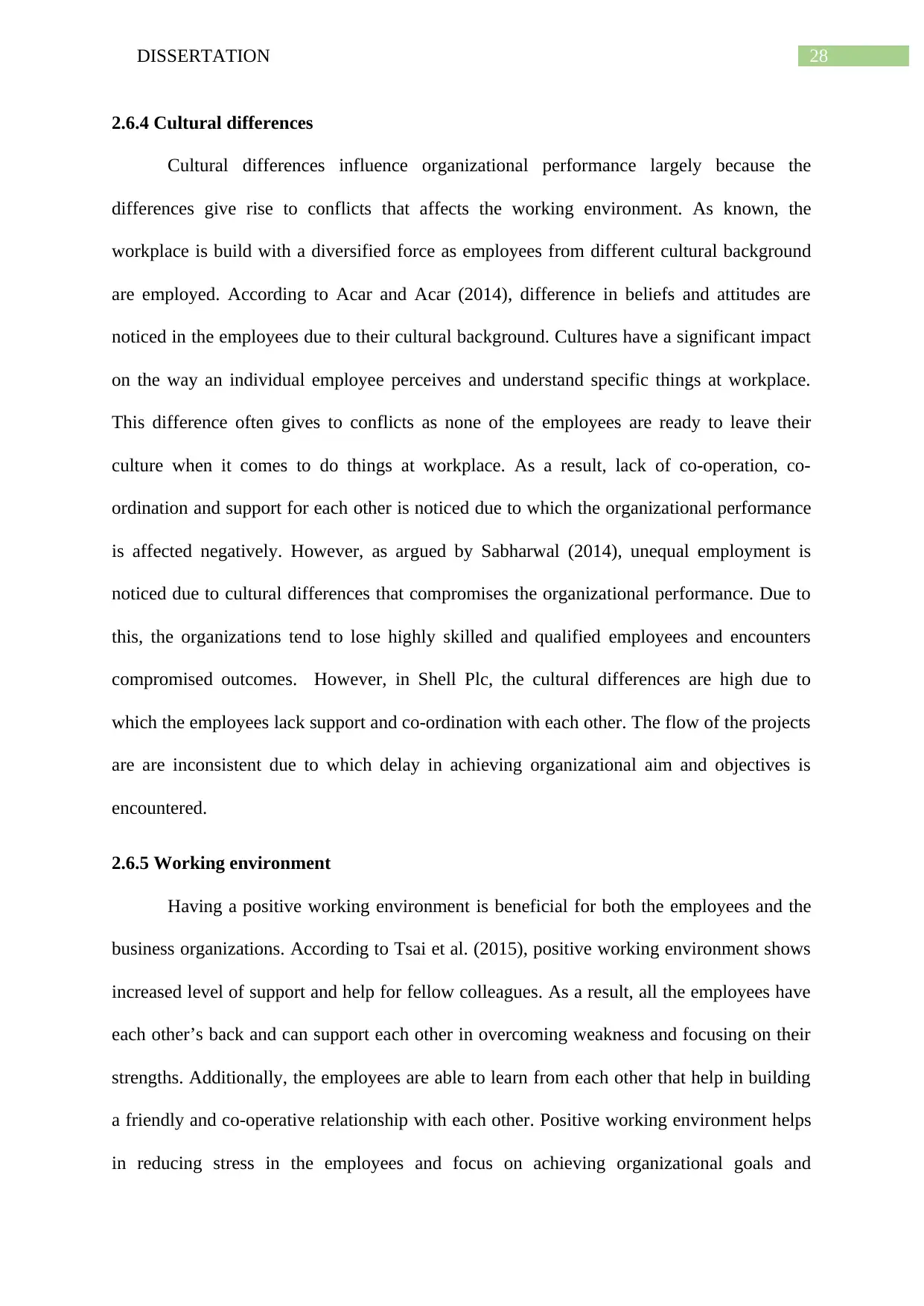
28DISSERTATION
2.6.4 Cultural differences
Cultural differences influence organizational performance largely because the
differences give rise to conflicts that affects the working environment. As known, the
workplace is build with a diversified force as employees from different cultural background
are employed. According to Acar and Acar (2014), difference in beliefs and attitudes are
noticed in the employees due to their cultural background. Cultures have a significant impact
on the way an individual employee perceives and understand specific things at workplace.
This difference often gives to conflicts as none of the employees are ready to leave their
culture when it comes to do things at workplace. As a result, lack of co-operation, co-
ordination and support for each other is noticed due to which the organizational performance
is affected negatively. However, as argued by Sabharwal (2014), unequal employment is
noticed due to cultural differences that compromises the organizational performance. Due to
this, the organizations tend to lose highly skilled and qualified employees and encounters
compromised outcomes. However, in Shell Plc, the cultural differences are high due to
which the employees lack support and co-ordination with each other. The flow of the projects
are are inconsistent due to which delay in achieving organizational aim and objectives is
encountered.
2.6.5 Working environment
Having a positive working environment is beneficial for both the employees and the
business organizations. According to Tsai et al. (2015), positive working environment shows
increased level of support and help for fellow colleagues. As a result, all the employees have
each other’s back and can support each other in overcoming weakness and focusing on their
strengths. Additionally, the employees are able to learn from each other that help in building
a friendly and co-operative relationship with each other. Positive working environment helps
in reducing stress in the employees and focus on achieving organizational goals and
2.6.4 Cultural differences
Cultural differences influence organizational performance largely because the
differences give rise to conflicts that affects the working environment. As known, the
workplace is build with a diversified force as employees from different cultural background
are employed. According to Acar and Acar (2014), difference in beliefs and attitudes are
noticed in the employees due to their cultural background. Cultures have a significant impact
on the way an individual employee perceives and understand specific things at workplace.
This difference often gives to conflicts as none of the employees are ready to leave their
culture when it comes to do things at workplace. As a result, lack of co-operation, co-
ordination and support for each other is noticed due to which the organizational performance
is affected negatively. However, as argued by Sabharwal (2014), unequal employment is
noticed due to cultural differences that compromises the organizational performance. Due to
this, the organizations tend to lose highly skilled and qualified employees and encounters
compromised outcomes. However, in Shell Plc, the cultural differences are high due to
which the employees lack support and co-ordination with each other. The flow of the projects
are are inconsistent due to which delay in achieving organizational aim and objectives is
encountered.
2.6.5 Working environment
Having a positive working environment is beneficial for both the employees and the
business organizations. According to Tsai et al. (2015), positive working environment shows
increased level of support and help for fellow colleagues. As a result, all the employees have
each other’s back and can support each other in overcoming weakness and focusing on their
strengths. Additionally, the employees are able to learn from each other that help in building
a friendly and co-operative relationship with each other. Positive working environment helps
in reducing stress in the employees and focus on achieving organizational goals and
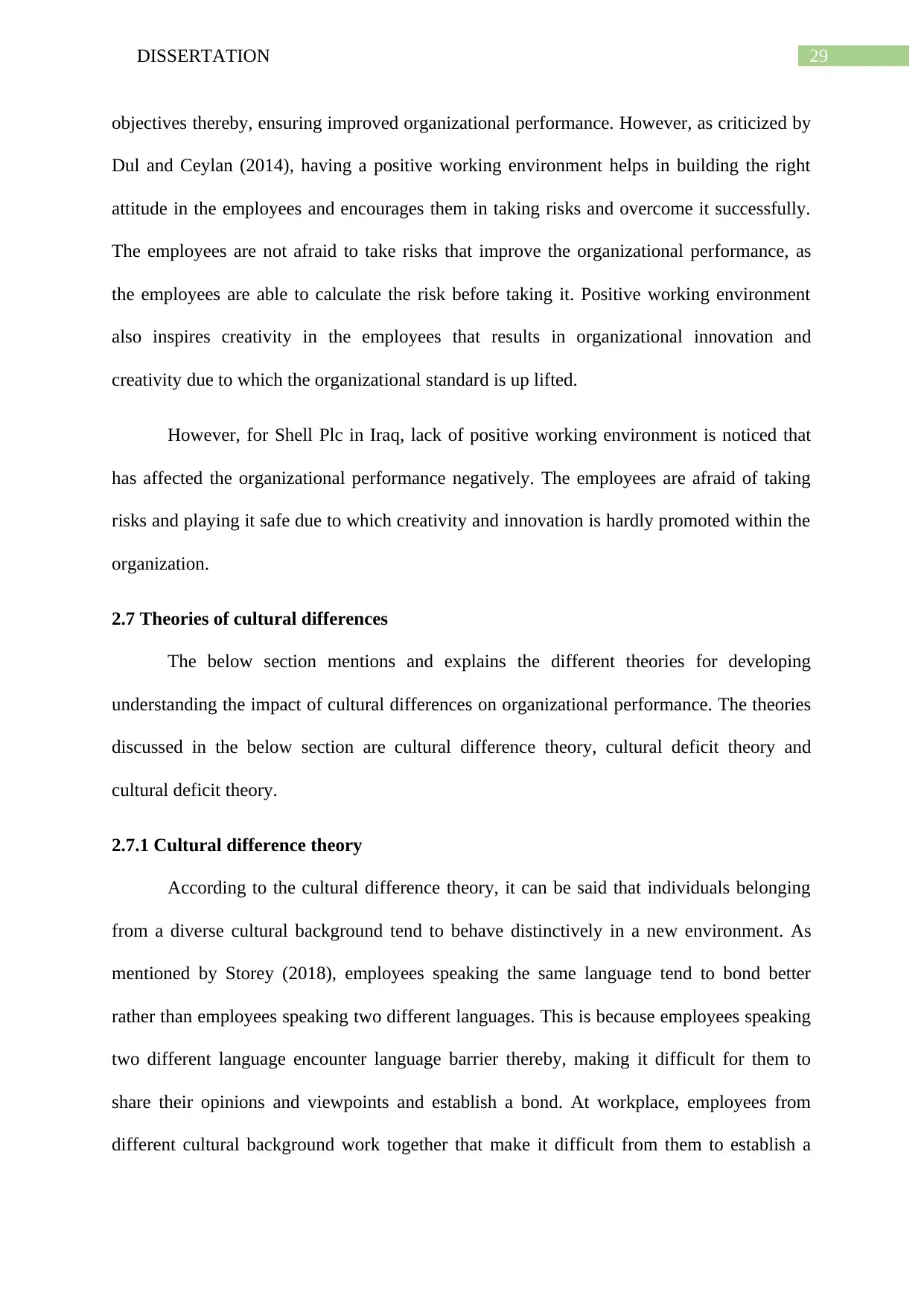
29DISSERTATION
objectives thereby, ensuring improved organizational performance. However, as criticized by
Dul and Ceylan (2014), having a positive working environment helps in building the right
attitude in the employees and encourages them in taking risks and overcome it successfully.
The employees are not afraid to take risks that improve the organizational performance, as
the employees are able to calculate the risk before taking it. Positive working environment
also inspires creativity in the employees that results in organizational innovation and
creativity due to which the organizational standard is up lifted.
However, for Shell Plc in Iraq, lack of positive working environment is noticed that
has affected the organizational performance negatively. The employees are afraid of taking
risks and playing it safe due to which creativity and innovation is hardly promoted within the
organization.
2.7 Theories of cultural differences
The below section mentions and explains the different theories for developing
understanding the impact of cultural differences on organizational performance. The theories
discussed in the below section are cultural difference theory, cultural deficit theory and
cultural deficit theory.
2.7.1 Cultural difference theory
According to the cultural difference theory, it can be said that individuals belonging
from a diverse cultural background tend to behave distinctively in a new environment. As
mentioned by Storey (2018), employees speaking the same language tend to bond better
rather than employees speaking two different languages. This is because employees speaking
two different language encounter language barrier thereby, making it difficult for them to
share their opinions and viewpoints and establish a bond. At workplace, employees from
different cultural background work together that make it difficult from them to establish a
objectives thereby, ensuring improved organizational performance. However, as criticized by
Dul and Ceylan (2014), having a positive working environment helps in building the right
attitude in the employees and encourages them in taking risks and overcome it successfully.
The employees are not afraid to take risks that improve the organizational performance, as
the employees are able to calculate the risk before taking it. Positive working environment
also inspires creativity in the employees that results in organizational innovation and
creativity due to which the organizational standard is up lifted.
However, for Shell Plc in Iraq, lack of positive working environment is noticed that
has affected the organizational performance negatively. The employees are afraid of taking
risks and playing it safe due to which creativity and innovation is hardly promoted within the
organization.
2.7 Theories of cultural differences
The below section mentions and explains the different theories for developing
understanding the impact of cultural differences on organizational performance. The theories
discussed in the below section are cultural difference theory, cultural deficit theory and
cultural deficit theory.
2.7.1 Cultural difference theory
According to the cultural difference theory, it can be said that individuals belonging
from a diverse cultural background tend to behave distinctively in a new environment. As
mentioned by Storey (2018), employees speaking the same language tend to bond better
rather than employees speaking two different languages. This is because employees speaking
two different language encounter language barrier thereby, making it difficult for them to
share their opinions and viewpoints and establish a bond. At workplace, employees from
different cultural background work together that make it difficult from them to establish a
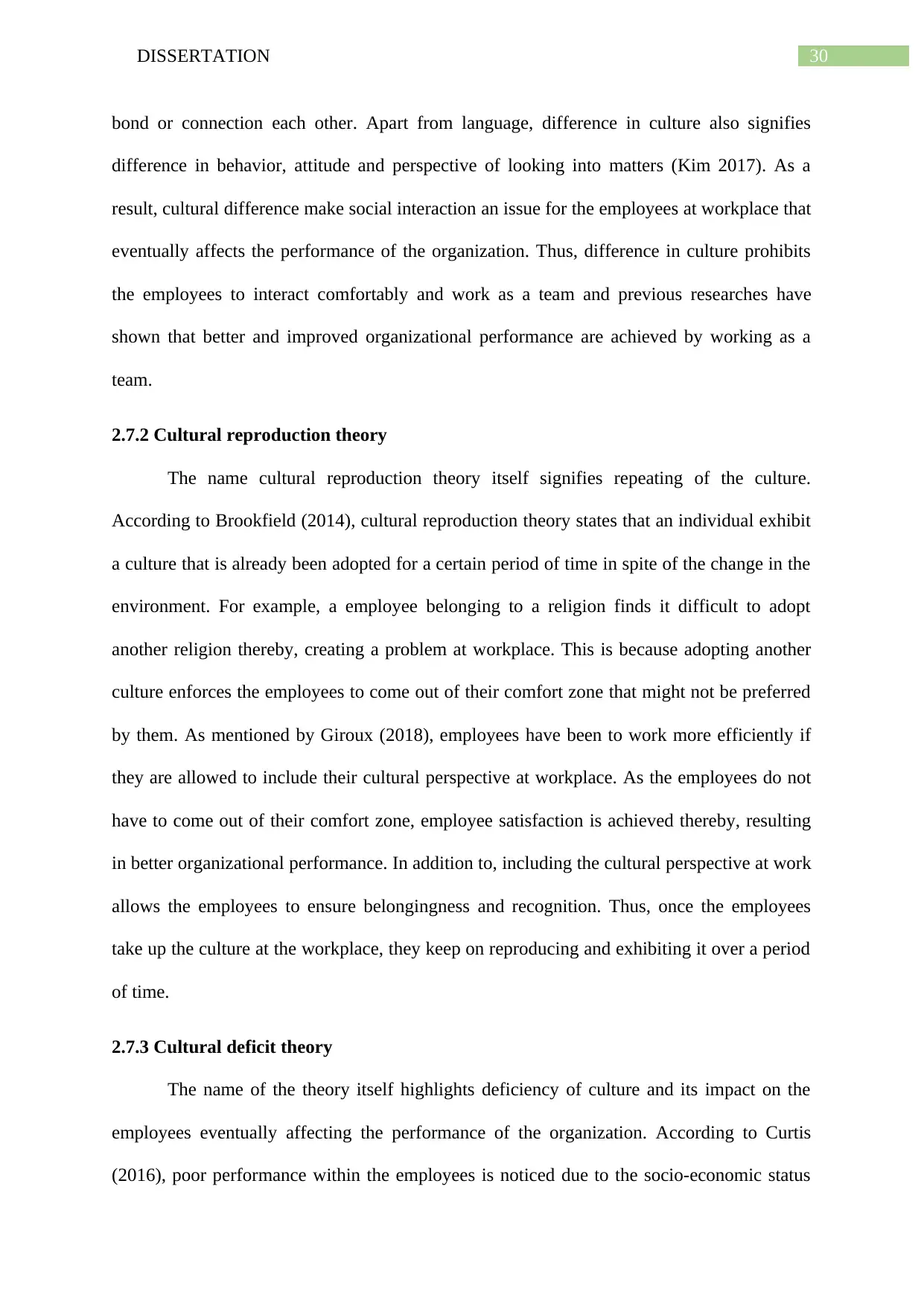
30DISSERTATION
bond or connection each other. Apart from language, difference in culture also signifies
difference in behavior, attitude and perspective of looking into matters (Kim 2017). As a
result, cultural difference make social interaction an issue for the employees at workplace that
eventually affects the performance of the organization. Thus, difference in culture prohibits
the employees to interact comfortably and work as a team and previous researches have
shown that better and improved organizational performance are achieved by working as a
team.
2.7.2 Cultural reproduction theory
The name cultural reproduction theory itself signifies repeating of the culture.
According to Brookfield (2014), cultural reproduction theory states that an individual exhibit
a culture that is already been adopted for a certain period of time in spite of the change in the
environment. For example, a employee belonging to a religion finds it difficult to adopt
another religion thereby, creating a problem at workplace. This is because adopting another
culture enforces the employees to come out of their comfort zone that might not be preferred
by them. As mentioned by Giroux (2018), employees have been to work more efficiently if
they are allowed to include their cultural perspective at workplace. As the employees do not
have to come out of their comfort zone, employee satisfaction is achieved thereby, resulting
in better organizational performance. In addition to, including the cultural perspective at work
allows the employees to ensure belongingness and recognition. Thus, once the employees
take up the culture at the workplace, they keep on reproducing and exhibiting it over a period
of time.
2.7.3 Cultural deficit theory
The name of the theory itself highlights deficiency of culture and its impact on the
employees eventually affecting the performance of the organization. According to Curtis
(2016), poor performance within the employees is noticed due to the socio-economic status
bond or connection each other. Apart from language, difference in culture also signifies
difference in behavior, attitude and perspective of looking into matters (Kim 2017). As a
result, cultural difference make social interaction an issue for the employees at workplace that
eventually affects the performance of the organization. Thus, difference in culture prohibits
the employees to interact comfortably and work as a team and previous researches have
shown that better and improved organizational performance are achieved by working as a
team.
2.7.2 Cultural reproduction theory
The name cultural reproduction theory itself signifies repeating of the culture.
According to Brookfield (2014), cultural reproduction theory states that an individual exhibit
a culture that is already been adopted for a certain period of time in spite of the change in the
environment. For example, a employee belonging to a religion finds it difficult to adopt
another religion thereby, creating a problem at workplace. This is because adopting another
culture enforces the employees to come out of their comfort zone that might not be preferred
by them. As mentioned by Giroux (2018), employees have been to work more efficiently if
they are allowed to include their cultural perspective at workplace. As the employees do not
have to come out of their comfort zone, employee satisfaction is achieved thereby, resulting
in better organizational performance. In addition to, including the cultural perspective at work
allows the employees to ensure belongingness and recognition. Thus, once the employees
take up the culture at the workplace, they keep on reproducing and exhibiting it over a period
of time.
2.7.3 Cultural deficit theory
The name of the theory itself highlights deficiency of culture and its impact on the
employees eventually affecting the performance of the organization. According to Curtis
(2016), poor performance within the employees is noticed due to the socio-economic status
Paraphrase This Document
Need a fresh take? Get an instant paraphrase of this document with our AI Paraphraser
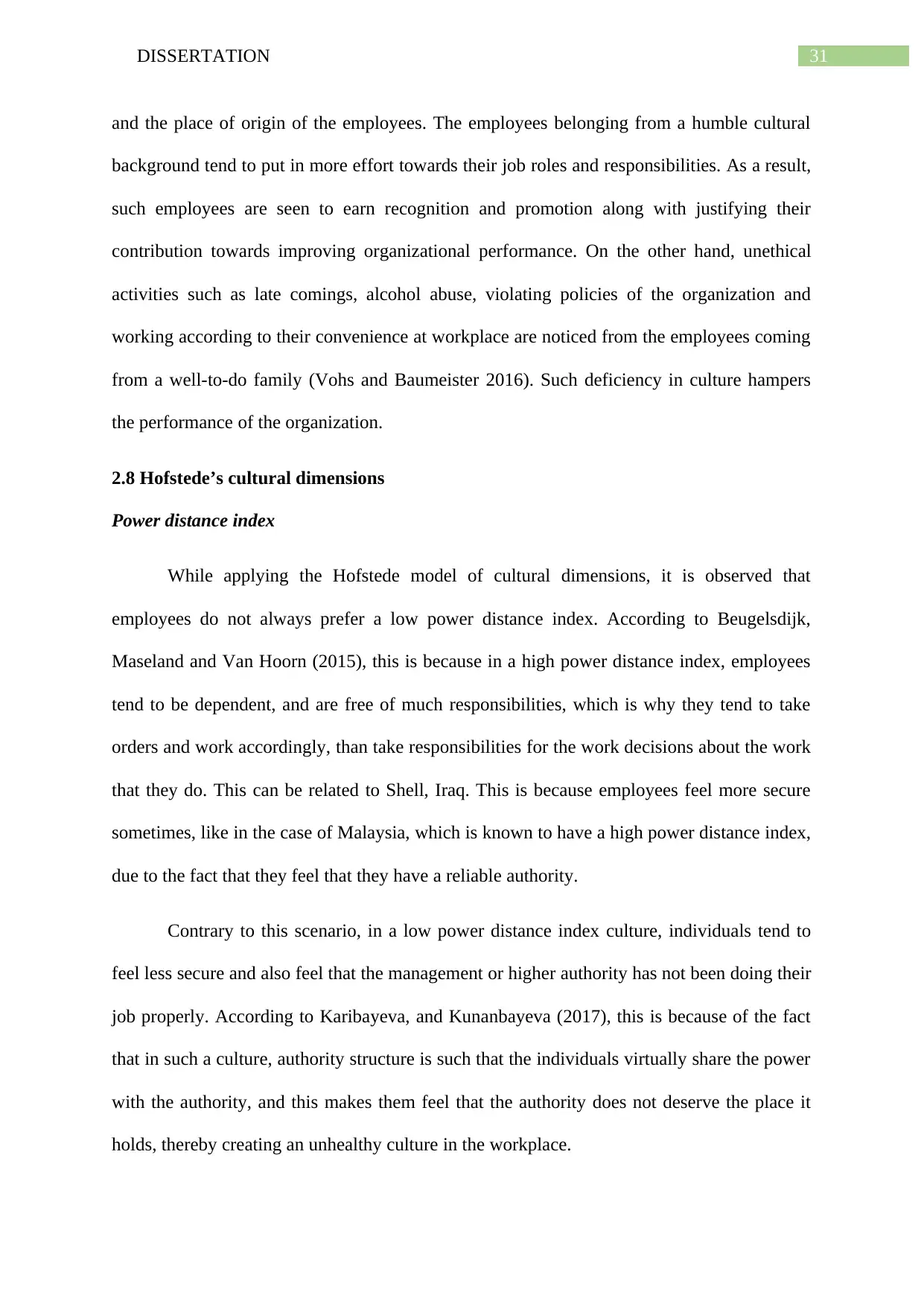
31DISSERTATION
and the place of origin of the employees. The employees belonging from a humble cultural
background tend to put in more effort towards their job roles and responsibilities. As a result,
such employees are seen to earn recognition and promotion along with justifying their
contribution towards improving organizational performance. On the other hand, unethical
activities such as late comings, alcohol abuse, violating policies of the organization and
working according to their convenience at workplace are noticed from the employees coming
from a well-to-do family (Vohs and Baumeister 2016). Such deficiency in culture hampers
the performance of the organization.
2.8 Hofstede’s cultural dimensions
Power distance index
While applying the Hofstede model of cultural dimensions, it is observed that
employees do not always prefer a low power distance index. According to Beugelsdijk,
Maseland and Van Hoorn (2015), this is because in a high power distance index, employees
tend to be dependent, and are free of much responsibilities, which is why they tend to take
orders and work accordingly, than take responsibilities for the work decisions about the work
that they do. This can be related to Shell, Iraq. This is because employees feel more secure
sometimes, like in the case of Malaysia, which is known to have a high power distance index,
due to the fact that they feel that they have a reliable authority.
Contrary to this scenario, in a low power distance index culture, individuals tend to
feel less secure and also feel that the management or higher authority has not been doing their
job properly. According to Karibayeva, and Kunanbayeva (2017), this is because of the fact
that in such a culture, authority structure is such that the individuals virtually share the power
with the authority, and this makes them feel that the authority does not deserve the place it
holds, thereby creating an unhealthy culture in the workplace.
and the place of origin of the employees. The employees belonging from a humble cultural
background tend to put in more effort towards their job roles and responsibilities. As a result,
such employees are seen to earn recognition and promotion along with justifying their
contribution towards improving organizational performance. On the other hand, unethical
activities such as late comings, alcohol abuse, violating policies of the organization and
working according to their convenience at workplace are noticed from the employees coming
from a well-to-do family (Vohs and Baumeister 2016). Such deficiency in culture hampers
the performance of the organization.
2.8 Hofstede’s cultural dimensions
Power distance index
While applying the Hofstede model of cultural dimensions, it is observed that
employees do not always prefer a low power distance index. According to Beugelsdijk,
Maseland and Van Hoorn (2015), this is because in a high power distance index, employees
tend to be dependent, and are free of much responsibilities, which is why they tend to take
orders and work accordingly, than take responsibilities for the work decisions about the work
that they do. This can be related to Shell, Iraq. This is because employees feel more secure
sometimes, like in the case of Malaysia, which is known to have a high power distance index,
due to the fact that they feel that they have a reliable authority.
Contrary to this scenario, in a low power distance index culture, individuals tend to
feel less secure and also feel that the management or higher authority has not been doing their
job properly. According to Karibayeva, and Kunanbayeva (2017), this is because of the fact
that in such a culture, authority structure is such that the individuals virtually share the power
with the authority, and this makes them feel that the authority does not deserve the place it
holds, thereby creating an unhealthy culture in the workplace.
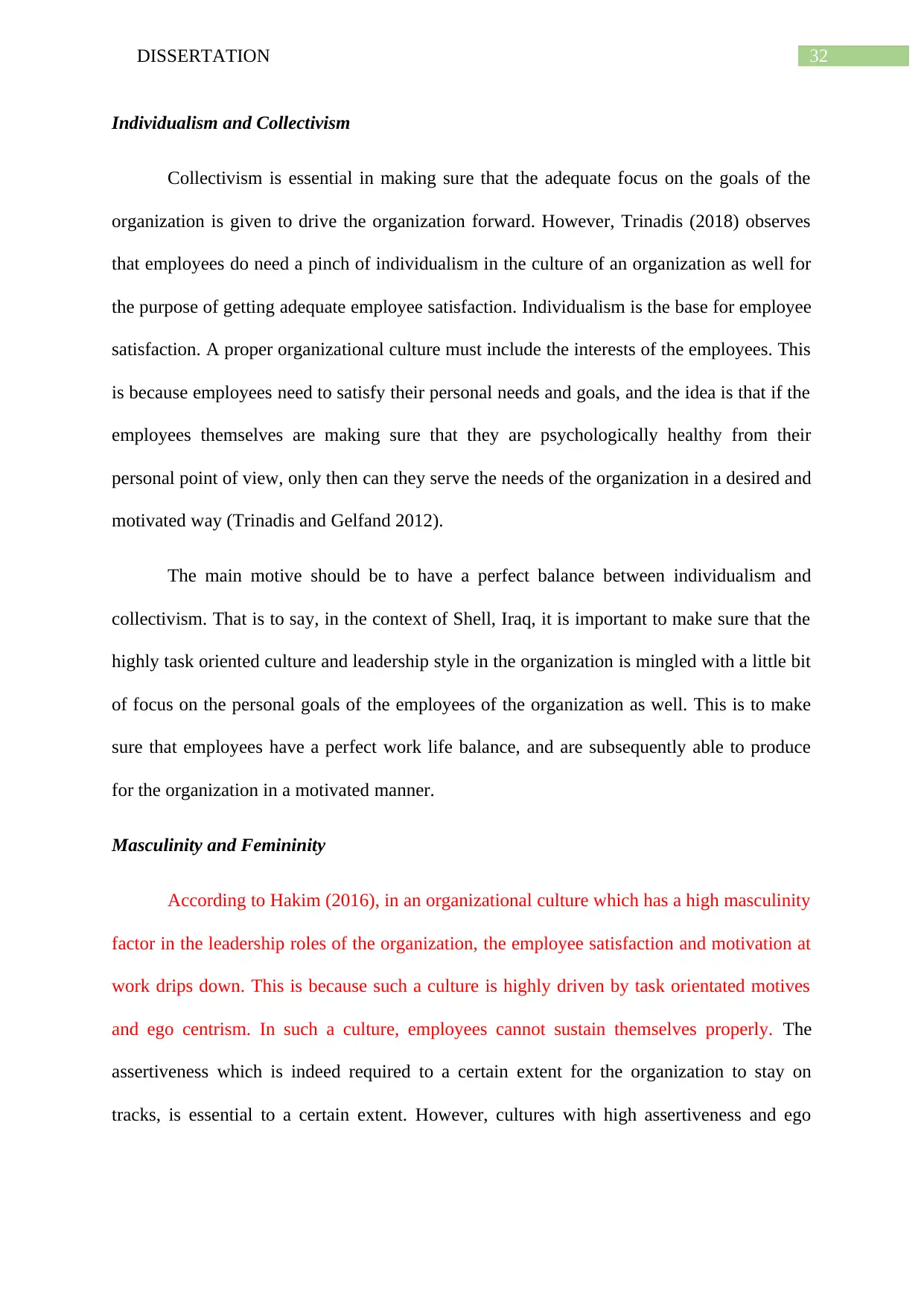
32DISSERTATION
Individualism and Collectivism
Collectivism is essential in making sure that the adequate focus on the goals of the
organization is given to drive the organization forward. However, Trinadis (2018) observes
that employees do need a pinch of individualism in the culture of an organization as well for
the purpose of getting adequate employee satisfaction. Individualism is the base for employee
satisfaction. A proper organizational culture must include the interests of the employees. This
is because employees need to satisfy their personal needs and goals, and the idea is that if the
employees themselves are making sure that they are psychologically healthy from their
personal point of view, only then can they serve the needs of the organization in a desired and
motivated way (Trinadis and Gelfand 2012).
The main motive should be to have a perfect balance between individualism and
collectivism. That is to say, in the context of Shell, Iraq, it is important to make sure that the
highly task oriented culture and leadership style in the organization is mingled with a little bit
of focus on the personal goals of the employees of the organization as well. This is to make
sure that employees have a perfect work life balance, and are subsequently able to produce
for the organization in a motivated manner.
Masculinity and Femininity
According to Hakim (2016), in an organizational culture which has a high masculinity
factor in the leadership roles of the organization, the employee satisfaction and motivation at
work drips down. This is because such a culture is highly driven by task orientated motives
and ego centrism. In such a culture, employees cannot sustain themselves properly. The
assertiveness which is indeed required to a certain extent for the organization to stay on
tracks, is essential to a certain extent. However, cultures with high assertiveness and ego
Individualism and Collectivism
Collectivism is essential in making sure that the adequate focus on the goals of the
organization is given to drive the organization forward. However, Trinadis (2018) observes
that employees do need a pinch of individualism in the culture of an organization as well for
the purpose of getting adequate employee satisfaction. Individualism is the base for employee
satisfaction. A proper organizational culture must include the interests of the employees. This
is because employees need to satisfy their personal needs and goals, and the idea is that if the
employees themselves are making sure that they are psychologically healthy from their
personal point of view, only then can they serve the needs of the organization in a desired and
motivated way (Trinadis and Gelfand 2012).
The main motive should be to have a perfect balance between individualism and
collectivism. That is to say, in the context of Shell, Iraq, it is important to make sure that the
highly task oriented culture and leadership style in the organization is mingled with a little bit
of focus on the personal goals of the employees of the organization as well. This is to make
sure that employees have a perfect work life balance, and are subsequently able to produce
for the organization in a motivated manner.
Masculinity and Femininity
According to Hakim (2016), in an organizational culture which has a high masculinity
factor in the leadership roles of the organization, the employee satisfaction and motivation at
work drips down. This is because such a culture is highly driven by task orientated motives
and ego centrism. In such a culture, employees cannot sustain themselves properly. The
assertiveness which is indeed required to a certain extent for the organization to stay on
tracks, is essential to a certain extent. However, cultures with high assertiveness and ego
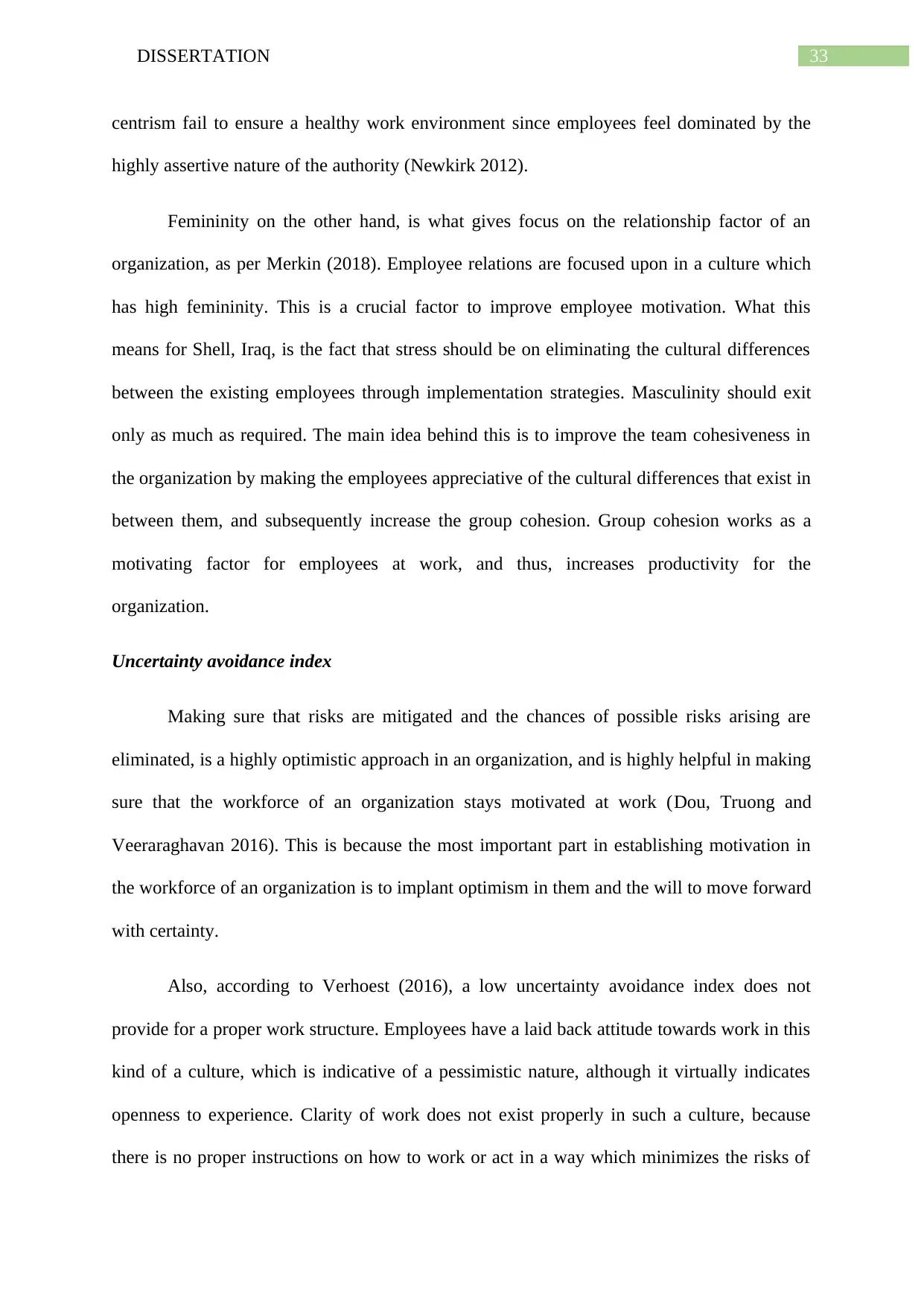
33DISSERTATION
centrism fail to ensure a healthy work environment since employees feel dominated by the
highly assertive nature of the authority (Newkirk 2012).
Femininity on the other hand, is what gives focus on the relationship factor of an
organization, as per Merkin (2018). Employee relations are focused upon in a culture which
has high femininity. This is a crucial factor to improve employee motivation. What this
means for Shell, Iraq, is the fact that stress should be on eliminating the cultural differences
between the existing employees through implementation strategies. Masculinity should exit
only as much as required. The main idea behind this is to improve the team cohesiveness in
the organization by making the employees appreciative of the cultural differences that exist in
between them, and subsequently increase the group cohesion. Group cohesion works as a
motivating factor for employees at work, and thus, increases productivity for the
organization.
Uncertainty avoidance index
Making sure that risks are mitigated and the chances of possible risks arising are
eliminated, is a highly optimistic approach in an organization, and is highly helpful in making
sure that the workforce of an organization stays motivated at work (Dou, Truong and
Veeraraghavan 2016). This is because the most important part in establishing motivation in
the workforce of an organization is to implant optimism in them and the will to move forward
with certainty.
Also, according to Verhoest (2016), a low uncertainty avoidance index does not
provide for a proper work structure. Employees have a laid back attitude towards work in this
kind of a culture, which is indicative of a pessimistic nature, although it virtually indicates
openness to experience. Clarity of work does not exist properly in such a culture, because
there is no proper instructions on how to work or act in a way which minimizes the risks of
centrism fail to ensure a healthy work environment since employees feel dominated by the
highly assertive nature of the authority (Newkirk 2012).
Femininity on the other hand, is what gives focus on the relationship factor of an
organization, as per Merkin (2018). Employee relations are focused upon in a culture which
has high femininity. This is a crucial factor to improve employee motivation. What this
means for Shell, Iraq, is the fact that stress should be on eliminating the cultural differences
between the existing employees through implementation strategies. Masculinity should exit
only as much as required. The main idea behind this is to improve the team cohesiveness in
the organization by making the employees appreciative of the cultural differences that exist in
between them, and subsequently increase the group cohesion. Group cohesion works as a
motivating factor for employees at work, and thus, increases productivity for the
organization.
Uncertainty avoidance index
Making sure that risks are mitigated and the chances of possible risks arising are
eliminated, is a highly optimistic approach in an organization, and is highly helpful in making
sure that the workforce of an organization stays motivated at work (Dou, Truong and
Veeraraghavan 2016). This is because the most important part in establishing motivation in
the workforce of an organization is to implant optimism in them and the will to move forward
with certainty.
Also, according to Verhoest (2016), a low uncertainty avoidance index does not
provide for a proper work structure. Employees have a laid back attitude towards work in this
kind of a culture, which is indicative of a pessimistic nature, although it virtually indicates
openness to experience. Clarity of work does not exist properly in such a culture, because
there is no proper instructions on how to work or act in a way which minimizes the risks of
Secure Best Marks with AI Grader
Need help grading? Try our AI Grader for instant feedback on your assignments.
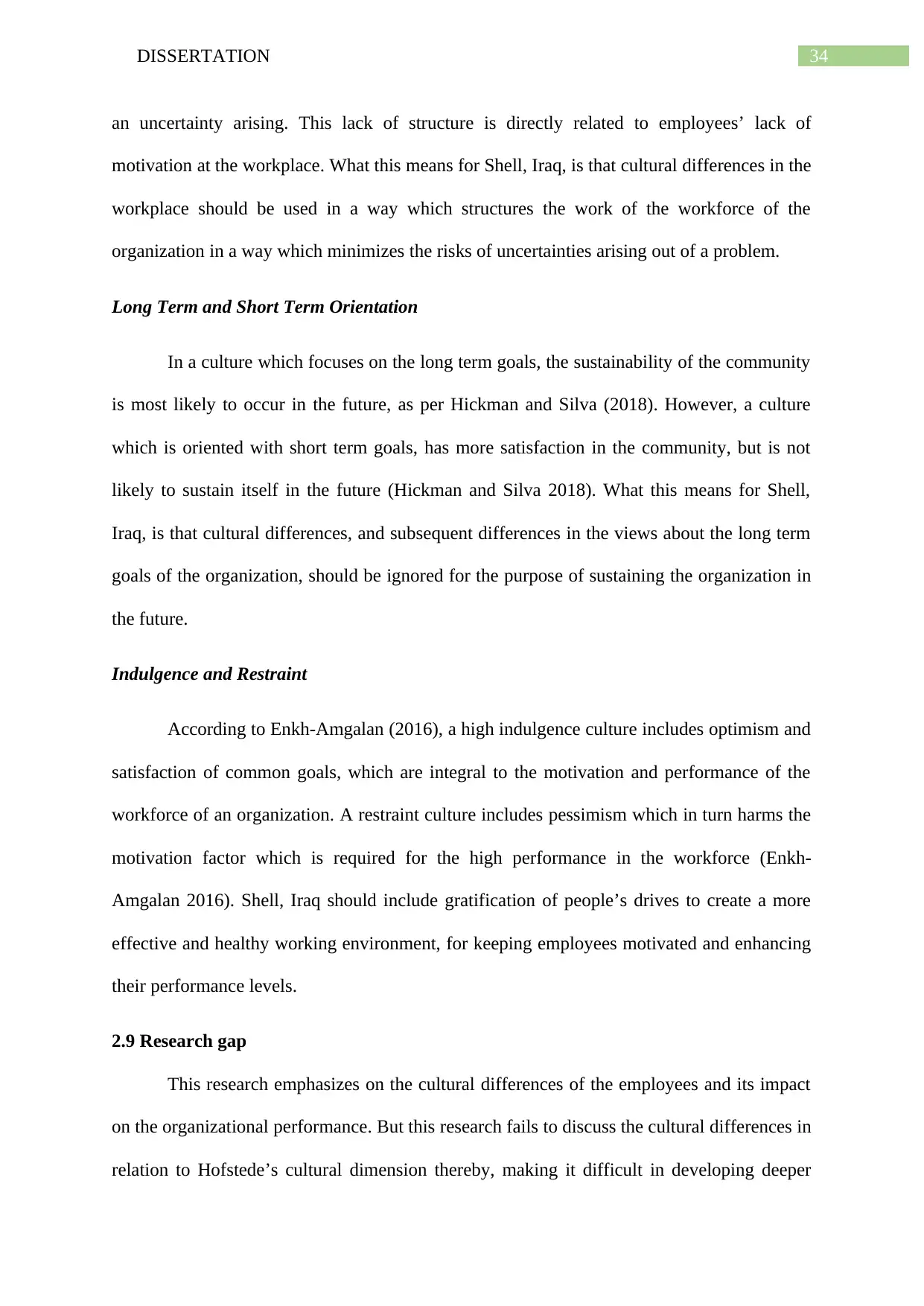
34DISSERTATION
an uncertainty arising. This lack of structure is directly related to employees’ lack of
motivation at the workplace. What this means for Shell, Iraq, is that cultural differences in the
workplace should be used in a way which structures the work of the workforce of the
organization in a way which minimizes the risks of uncertainties arising out of a problem.
Long Term and Short Term Orientation
In a culture which focuses on the long term goals, the sustainability of the community
is most likely to occur in the future, as per Hickman and Silva (2018). However, a culture
which is oriented with short term goals, has more satisfaction in the community, but is not
likely to sustain itself in the future (Hickman and Silva 2018). What this means for Shell,
Iraq, is that cultural differences, and subsequent differences in the views about the long term
goals of the organization, should be ignored for the purpose of sustaining the organization in
the future.
Indulgence and Restraint
According to Enkh-Amgalan (2016), a high indulgence culture includes optimism and
satisfaction of common goals, which are integral to the motivation and performance of the
workforce of an organization. A restraint culture includes pessimism which in turn harms the
motivation factor which is required for the high performance in the workforce (Enkh-
Amgalan 2016). Shell, Iraq should include gratification of people’s drives to create a more
effective and healthy working environment, for keeping employees motivated and enhancing
their performance levels.
2.9 Research gap
This research emphasizes on the cultural differences of the employees and its impact
on the organizational performance. But this research fails to discuss the cultural differences in
relation to Hofstede’s cultural dimension thereby, making it difficult in developing deeper
an uncertainty arising. This lack of structure is directly related to employees’ lack of
motivation at the workplace. What this means for Shell, Iraq, is that cultural differences in the
workplace should be used in a way which structures the work of the workforce of the
organization in a way which minimizes the risks of uncertainties arising out of a problem.
Long Term and Short Term Orientation
In a culture which focuses on the long term goals, the sustainability of the community
is most likely to occur in the future, as per Hickman and Silva (2018). However, a culture
which is oriented with short term goals, has more satisfaction in the community, but is not
likely to sustain itself in the future (Hickman and Silva 2018). What this means for Shell,
Iraq, is that cultural differences, and subsequent differences in the views about the long term
goals of the organization, should be ignored for the purpose of sustaining the organization in
the future.
Indulgence and Restraint
According to Enkh-Amgalan (2016), a high indulgence culture includes optimism and
satisfaction of common goals, which are integral to the motivation and performance of the
workforce of an organization. A restraint culture includes pessimism which in turn harms the
motivation factor which is required for the high performance in the workforce (Enkh-
Amgalan 2016). Shell, Iraq should include gratification of people’s drives to create a more
effective and healthy working environment, for keeping employees motivated and enhancing
their performance levels.
2.9 Research gap
This research emphasizes on the cultural differences of the employees and its impact
on the organizational performance. But this research fails to discuss the cultural differences in
relation to Hofstede’s cultural dimension thereby, making it difficult in developing deeper
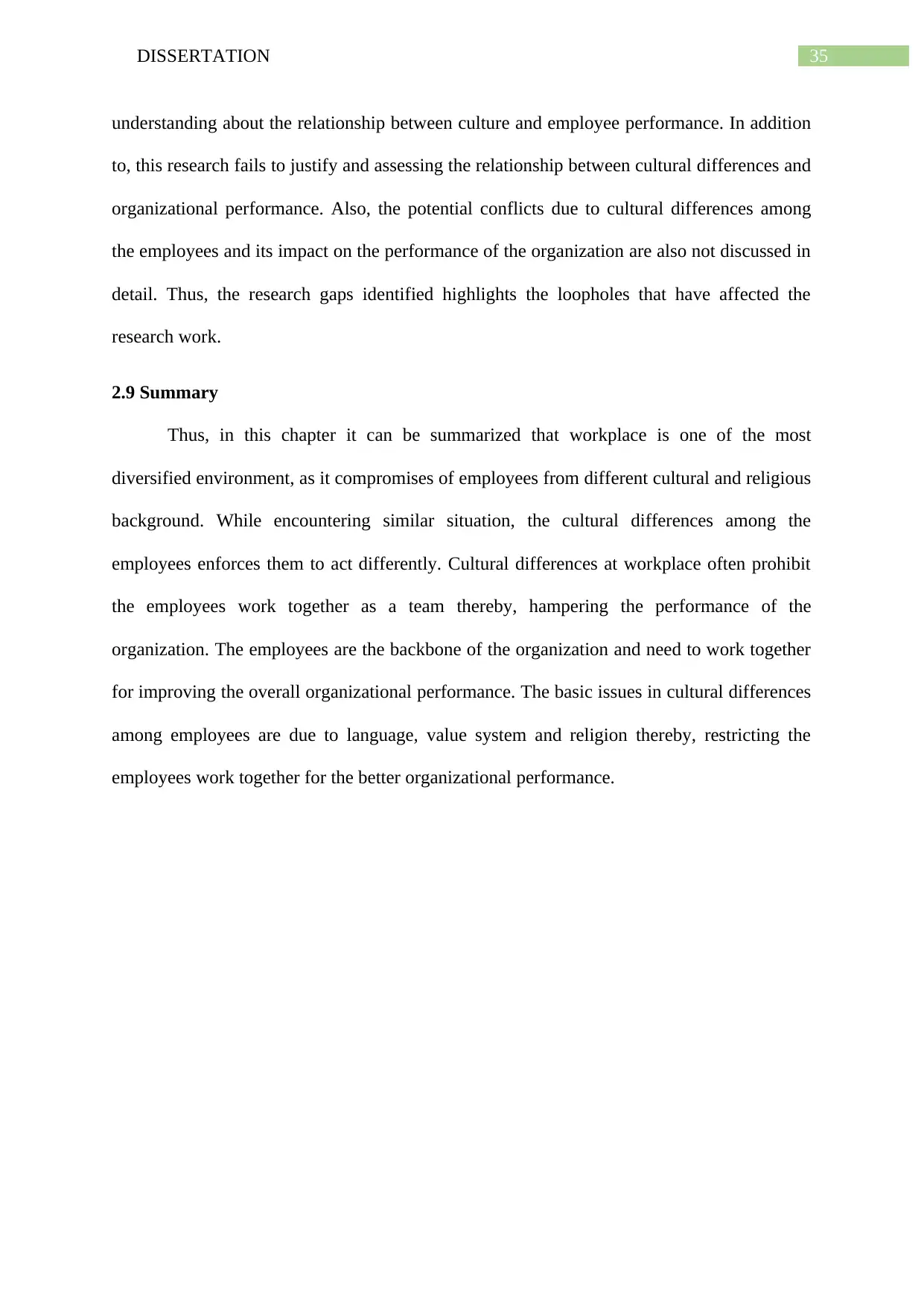
35DISSERTATION
understanding about the relationship between culture and employee performance. In addition
to, this research fails to justify and assessing the relationship between cultural differences and
organizational performance. Also, the potential conflicts due to cultural differences among
the employees and its impact on the performance of the organization are also not discussed in
detail. Thus, the research gaps identified highlights the loopholes that have affected the
research work.
2.9 Summary
Thus, in this chapter it can be summarized that workplace is one of the most
diversified environment, as it compromises of employees from different cultural and religious
background. While encountering similar situation, the cultural differences among the
employees enforces them to act differently. Cultural differences at workplace often prohibit
the employees work together as a team thereby, hampering the performance of the
organization. The employees are the backbone of the organization and need to work together
for improving the overall organizational performance. The basic issues in cultural differences
among employees are due to language, value system and religion thereby, restricting the
employees work together for the better organizational performance.
understanding about the relationship between culture and employee performance. In addition
to, this research fails to justify and assessing the relationship between cultural differences and
organizational performance. Also, the potential conflicts due to cultural differences among
the employees and its impact on the performance of the organization are also not discussed in
detail. Thus, the research gaps identified highlights the loopholes that have affected the
research work.
2.9 Summary
Thus, in this chapter it can be summarized that workplace is one of the most
diversified environment, as it compromises of employees from different cultural and religious
background. While encountering similar situation, the cultural differences among the
employees enforces them to act differently. Cultural differences at workplace often prohibit
the employees work together as a team thereby, hampering the performance of the
organization. The employees are the backbone of the organization and need to work together
for improving the overall organizational performance. The basic issues in cultural differences
among employees are due to language, value system and religion thereby, restricting the
employees work together for the better organizational performance.
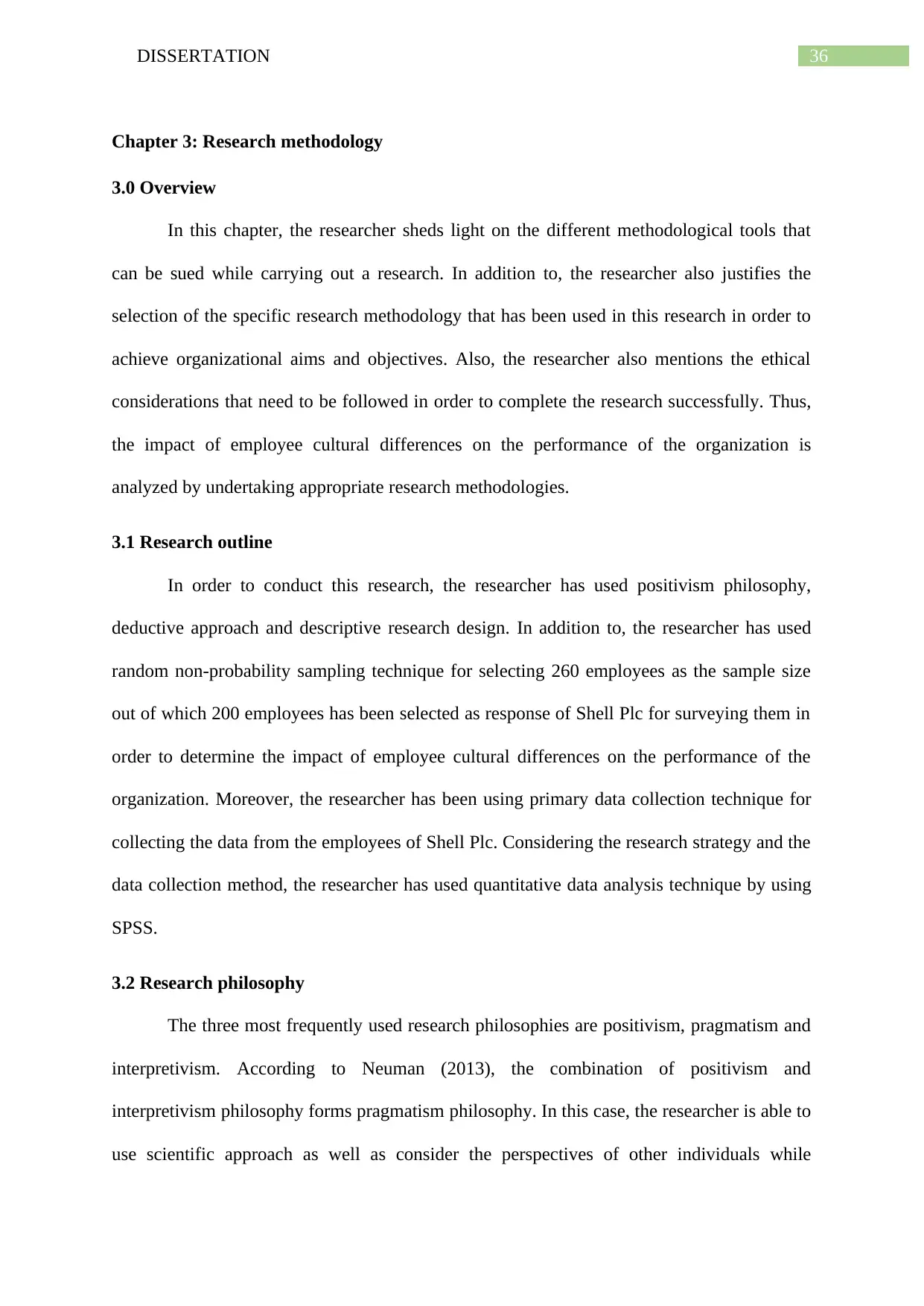
36DISSERTATION
Chapter 3: Research methodology
3.0 Overview
In this chapter, the researcher sheds light on the different methodological tools that
can be sued while carrying out a research. In addition to, the researcher also justifies the
selection of the specific research methodology that has been used in this research in order to
achieve organizational aims and objectives. Also, the researcher also mentions the ethical
considerations that need to be followed in order to complete the research successfully. Thus,
the impact of employee cultural differences on the performance of the organization is
analyzed by undertaking appropriate research methodologies.
3.1 Research outline
In order to conduct this research, the researcher has used positivism philosophy,
deductive approach and descriptive research design. In addition to, the researcher has used
random non-probability sampling technique for selecting 260 employees as the sample size
out of which 200 employees has been selected as response of Shell Plc for surveying them in
order to determine the impact of employee cultural differences on the performance of the
organization. Moreover, the researcher has been using primary data collection technique for
collecting the data from the employees of Shell Plc. Considering the research strategy and the
data collection method, the researcher has used quantitative data analysis technique by using
SPSS.
3.2 Research philosophy
The three most frequently used research philosophies are positivism, pragmatism and
interpretivism. According to Neuman (2013), the combination of positivism and
interpretivism philosophy forms pragmatism philosophy. In this case, the researcher is able to
use scientific approach as well as consider the perspectives of other individuals while
Chapter 3: Research methodology
3.0 Overview
In this chapter, the researcher sheds light on the different methodological tools that
can be sued while carrying out a research. In addition to, the researcher also justifies the
selection of the specific research methodology that has been used in this research in order to
achieve organizational aims and objectives. Also, the researcher also mentions the ethical
considerations that need to be followed in order to complete the research successfully. Thus,
the impact of employee cultural differences on the performance of the organization is
analyzed by undertaking appropriate research methodologies.
3.1 Research outline
In order to conduct this research, the researcher has used positivism philosophy,
deductive approach and descriptive research design. In addition to, the researcher has used
random non-probability sampling technique for selecting 260 employees as the sample size
out of which 200 employees has been selected as response of Shell Plc for surveying them in
order to determine the impact of employee cultural differences on the performance of the
organization. Moreover, the researcher has been using primary data collection technique for
collecting the data from the employees of Shell Plc. Considering the research strategy and the
data collection method, the researcher has used quantitative data analysis technique by using
SPSS.
3.2 Research philosophy
The three most frequently used research philosophies are positivism, pragmatism and
interpretivism. According to Neuman (2013), the combination of positivism and
interpretivism philosophy forms pragmatism philosophy. In this case, the researcher is able to
use scientific approach as well as consider the perspectives of other individuals while
Paraphrase This Document
Need a fresh take? Get an instant paraphrase of this document with our AI Paraphraser
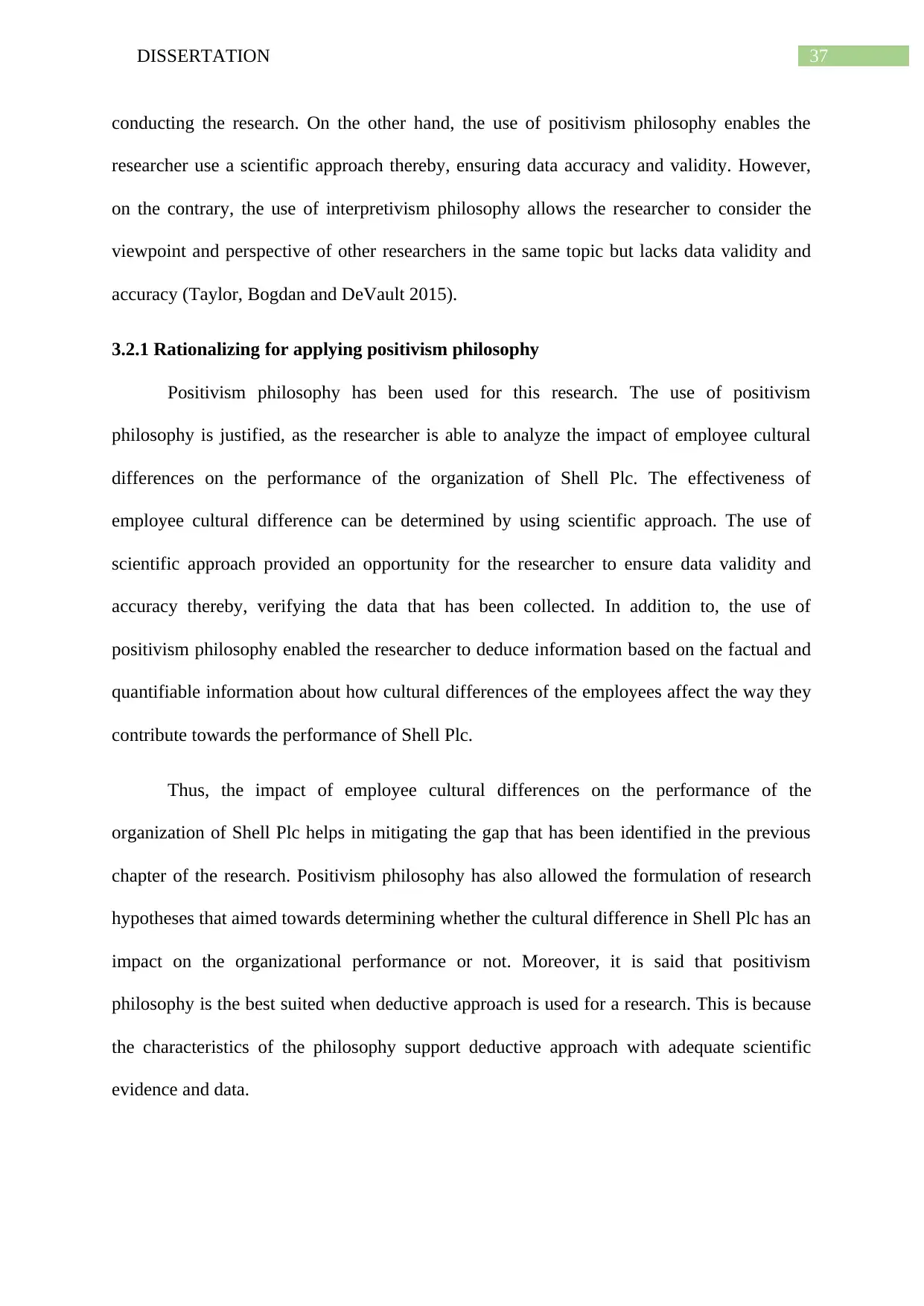
37DISSERTATION
conducting the research. On the other hand, the use of positivism philosophy enables the
researcher use a scientific approach thereby, ensuring data accuracy and validity. However,
on the contrary, the use of interpretivism philosophy allows the researcher to consider the
viewpoint and perspective of other researchers in the same topic but lacks data validity and
accuracy (Taylor, Bogdan and DeVault 2015).
3.2.1 Rationalizing for applying positivism philosophy
Positivism philosophy has been used for this research. The use of positivism
philosophy is justified, as the researcher is able to analyze the impact of employee cultural
differences on the performance of the organization of Shell Plc. The effectiveness of
employee cultural difference can be determined by using scientific approach. The use of
scientific approach provided an opportunity for the researcher to ensure data validity and
accuracy thereby, verifying the data that has been collected. In addition to, the use of
positivism philosophy enabled the researcher to deduce information based on the factual and
quantifiable information about how cultural differences of the employees affect the way they
contribute towards the performance of Shell Plc.
Thus, the impact of employee cultural differences on the performance of the
organization of Shell Plc helps in mitigating the gap that has been identified in the previous
chapter of the research. Positivism philosophy has also allowed the formulation of research
hypotheses that aimed towards determining whether the cultural difference in Shell Plc has an
impact on the organizational performance or not. Moreover, it is said that positivism
philosophy is the best suited when deductive approach is used for a research. This is because
the characteristics of the philosophy support deductive approach with adequate scientific
evidence and data.
conducting the research. On the other hand, the use of positivism philosophy enables the
researcher use a scientific approach thereby, ensuring data accuracy and validity. However,
on the contrary, the use of interpretivism philosophy allows the researcher to consider the
viewpoint and perspective of other researchers in the same topic but lacks data validity and
accuracy (Taylor, Bogdan and DeVault 2015).
3.2.1 Rationalizing for applying positivism philosophy
Positivism philosophy has been used for this research. The use of positivism
philosophy is justified, as the researcher is able to analyze the impact of employee cultural
differences on the performance of the organization of Shell Plc. The effectiveness of
employee cultural difference can be determined by using scientific approach. The use of
scientific approach provided an opportunity for the researcher to ensure data validity and
accuracy thereby, verifying the data that has been collected. In addition to, the use of
positivism philosophy enabled the researcher to deduce information based on the factual and
quantifiable information about how cultural differences of the employees affect the way they
contribute towards the performance of Shell Plc.
Thus, the impact of employee cultural differences on the performance of the
organization of Shell Plc helps in mitigating the gap that has been identified in the previous
chapter of the research. Positivism philosophy has also allowed the formulation of research
hypotheses that aimed towards determining whether the cultural difference in Shell Plc has an
impact on the organizational performance or not. Moreover, it is said that positivism
philosophy is the best suited when deductive approach is used for a research. This is because
the characteristics of the philosophy support deductive approach with adequate scientific
evidence and data.
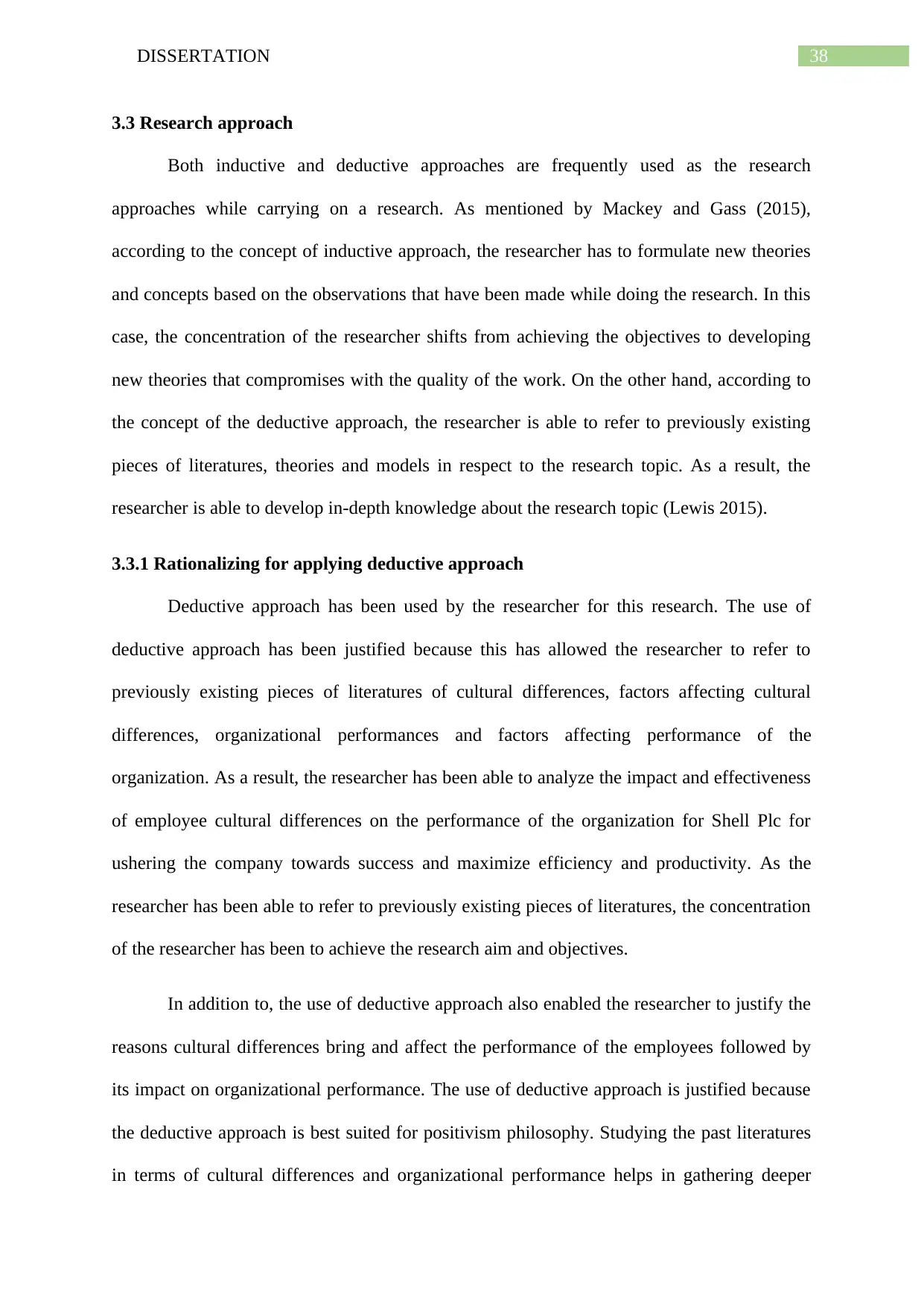
38DISSERTATION
3.3 Research approach
Both inductive and deductive approaches are frequently used as the research
approaches while carrying on a research. As mentioned by Mackey and Gass (2015),
according to the concept of inductive approach, the researcher has to formulate new theories
and concepts based on the observations that have been made while doing the research. In this
case, the concentration of the researcher shifts from achieving the objectives to developing
new theories that compromises with the quality of the work. On the other hand, according to
the concept of the deductive approach, the researcher is able to refer to previously existing
pieces of literatures, theories and models in respect to the research topic. As a result, the
researcher is able to develop in-depth knowledge about the research topic (Lewis 2015).
3.3.1 Rationalizing for applying deductive approach
Deductive approach has been used by the researcher for this research. The use of
deductive approach has been justified because this has allowed the researcher to refer to
previously existing pieces of literatures of cultural differences, factors affecting cultural
differences, organizational performances and factors affecting performance of the
organization. As a result, the researcher has been able to analyze the impact and effectiveness
of employee cultural differences on the performance of the organization for Shell Plc for
ushering the company towards success and maximize efficiency and productivity. As the
researcher has been able to refer to previously existing pieces of literatures, the concentration
of the researcher has been to achieve the research aim and objectives.
In addition to, the use of deductive approach also enabled the researcher to justify the
reasons cultural differences bring and affect the performance of the employees followed by
its impact on organizational performance. The use of deductive approach is justified because
the deductive approach is best suited for positivism philosophy. Studying the past literatures
in terms of cultural differences and organizational performance helps in gathering deeper
3.3 Research approach
Both inductive and deductive approaches are frequently used as the research
approaches while carrying on a research. As mentioned by Mackey and Gass (2015),
according to the concept of inductive approach, the researcher has to formulate new theories
and concepts based on the observations that have been made while doing the research. In this
case, the concentration of the researcher shifts from achieving the objectives to developing
new theories that compromises with the quality of the work. On the other hand, according to
the concept of the deductive approach, the researcher is able to refer to previously existing
pieces of literatures, theories and models in respect to the research topic. As a result, the
researcher is able to develop in-depth knowledge about the research topic (Lewis 2015).
3.3.1 Rationalizing for applying deductive approach
Deductive approach has been used by the researcher for this research. The use of
deductive approach has been justified because this has allowed the researcher to refer to
previously existing pieces of literatures of cultural differences, factors affecting cultural
differences, organizational performances and factors affecting performance of the
organization. As a result, the researcher has been able to analyze the impact and effectiveness
of employee cultural differences on the performance of the organization for Shell Plc for
ushering the company towards success and maximize efficiency and productivity. As the
researcher has been able to refer to previously existing pieces of literatures, the concentration
of the researcher has been to achieve the research aim and objectives.
In addition to, the use of deductive approach also enabled the researcher to justify the
reasons cultural differences bring and affect the performance of the employees followed by
its impact on organizational performance. The use of deductive approach is justified because
the deductive approach is best suited for positivism philosophy. Studying the past literatures
in terms of cultural differences and organizational performance helps in gathering deeper

39DISSERTATION
understanding of the impact of cultural difference in determining organizational performance
of Shell Plc in Iraq. This also provides an opportunity to critically evaluate the information
obtained thereby, comparing and contrasting own findings.
3.4 Research design
Descriptive, exploratory and explanatory are the three most preferred research designs
that have been used while commencing with research. According to the concept of the
explanatory research design, the researcher is able to explain the occurrences of the each of
the phenomenon that has been mentioned in the research thereby, stating their significance
and justifying their presence in the research (Silverman 2016). On the other hand, the concept
of exploratory research strategy allows the researcher to explore the potential issues in the
research and find ways of mitigating the issues. The descriptive research strategy highlights
the combined characteristics of explanatory and exploratory research designs (Vaioleti 2016).
3.4.1 Rationalizing for applying descriptive design
Descriptive research design has been used for this research. The use of descriptive
research design is justified because this allowed the researcher to explain and justify the
presence of the various factors that affect cultural differences and organizational
performance. In addition to, mentioning and justifying the presence of the each of the
phenomenon in the research work, the use of descriptive design also helps in identifying the
potential gap in terms of cultural differences in Shell Plc that is affecting the performance of
the organization. As a result, the use of descriptive research design also helps in predicting
the future occurrences of the potential cultural differences and impact on the performance of
the organization for Shell Plc in Iraq.
understanding of the impact of cultural difference in determining organizational performance
of Shell Plc in Iraq. This also provides an opportunity to critically evaluate the information
obtained thereby, comparing and contrasting own findings.
3.4 Research design
Descriptive, exploratory and explanatory are the three most preferred research designs
that have been used while commencing with research. According to the concept of the
explanatory research design, the researcher is able to explain the occurrences of the each of
the phenomenon that has been mentioned in the research thereby, stating their significance
and justifying their presence in the research (Silverman 2016). On the other hand, the concept
of exploratory research strategy allows the researcher to explore the potential issues in the
research and find ways of mitigating the issues. The descriptive research strategy highlights
the combined characteristics of explanatory and exploratory research designs (Vaioleti 2016).
3.4.1 Rationalizing for applying descriptive design
Descriptive research design has been used for this research. The use of descriptive
research design is justified because this allowed the researcher to explain and justify the
presence of the various factors that affect cultural differences and organizational
performance. In addition to, mentioning and justifying the presence of the each of the
phenomenon in the research work, the use of descriptive design also helps in identifying the
potential gap in terms of cultural differences in Shell Plc that is affecting the performance of
the organization. As a result, the use of descriptive research design also helps in predicting
the future occurrences of the potential cultural differences and impact on the performance of
the organization for Shell Plc in Iraq.
Secure Best Marks with AI Grader
Need help grading? Try our AI Grader for instant feedback on your assignments.
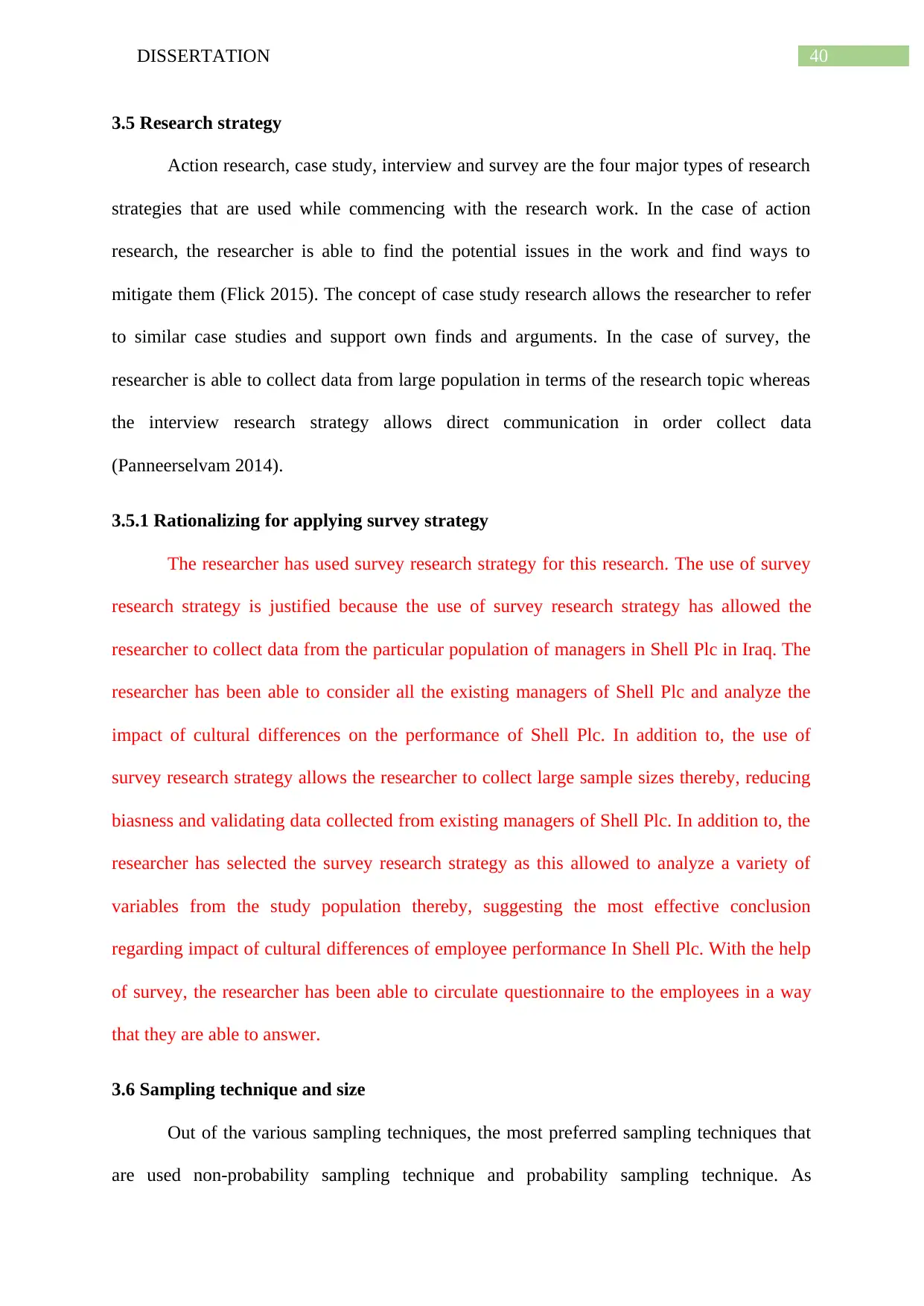
40DISSERTATION
3.5 Research strategy
Action research, case study, interview and survey are the four major types of research
strategies that are used while commencing with the research work. In the case of action
research, the researcher is able to find the potential issues in the work and find ways to
mitigate them (Flick 2015). The concept of case study research allows the researcher to refer
to similar case studies and support own finds and arguments. In the case of survey, the
researcher is able to collect data from large population in terms of the research topic whereas
the interview research strategy allows direct communication in order collect data
(Panneerselvam 2014).
3.5.1 Rationalizing for applying survey strategy
The researcher has used survey research strategy for this research. The use of survey
research strategy is justified because the use of survey research strategy has allowed the
researcher to collect data from the particular population of managers in Shell Plc in Iraq. The
researcher has been able to consider all the existing managers of Shell Plc and analyze the
impact of cultural differences on the performance of Shell Plc. In addition to, the use of
survey research strategy allows the researcher to collect large sample sizes thereby, reducing
biasness and validating data collected from existing managers of Shell Plc. In addition to, the
researcher has selected the survey research strategy as this allowed to analyze a variety of
variables from the study population thereby, suggesting the most effective conclusion
regarding impact of cultural differences of employee performance In Shell Plc. With the help
of survey, the researcher has been able to circulate questionnaire to the employees in a way
that they are able to answer.
3.6 Sampling technique and size
Out of the various sampling techniques, the most preferred sampling techniques that
are used non-probability sampling technique and probability sampling technique. As
3.5 Research strategy
Action research, case study, interview and survey are the four major types of research
strategies that are used while commencing with the research work. In the case of action
research, the researcher is able to find the potential issues in the work and find ways to
mitigate them (Flick 2015). The concept of case study research allows the researcher to refer
to similar case studies and support own finds and arguments. In the case of survey, the
researcher is able to collect data from large population in terms of the research topic whereas
the interview research strategy allows direct communication in order collect data
(Panneerselvam 2014).
3.5.1 Rationalizing for applying survey strategy
The researcher has used survey research strategy for this research. The use of survey
research strategy is justified because the use of survey research strategy has allowed the
researcher to collect data from the particular population of managers in Shell Plc in Iraq. The
researcher has been able to consider all the existing managers of Shell Plc and analyze the
impact of cultural differences on the performance of Shell Plc. In addition to, the use of
survey research strategy allows the researcher to collect large sample sizes thereby, reducing
biasness and validating data collected from existing managers of Shell Plc. In addition to, the
researcher has selected the survey research strategy as this allowed to analyze a variety of
variables from the study population thereby, suggesting the most effective conclusion
regarding impact of cultural differences of employee performance In Shell Plc. With the help
of survey, the researcher has been able to circulate questionnaire to the employees in a way
that they are able to answer.
3.6 Sampling technique and size
Out of the various sampling techniques, the most preferred sampling techniques that
are used non-probability sampling technique and probability sampling technique. As
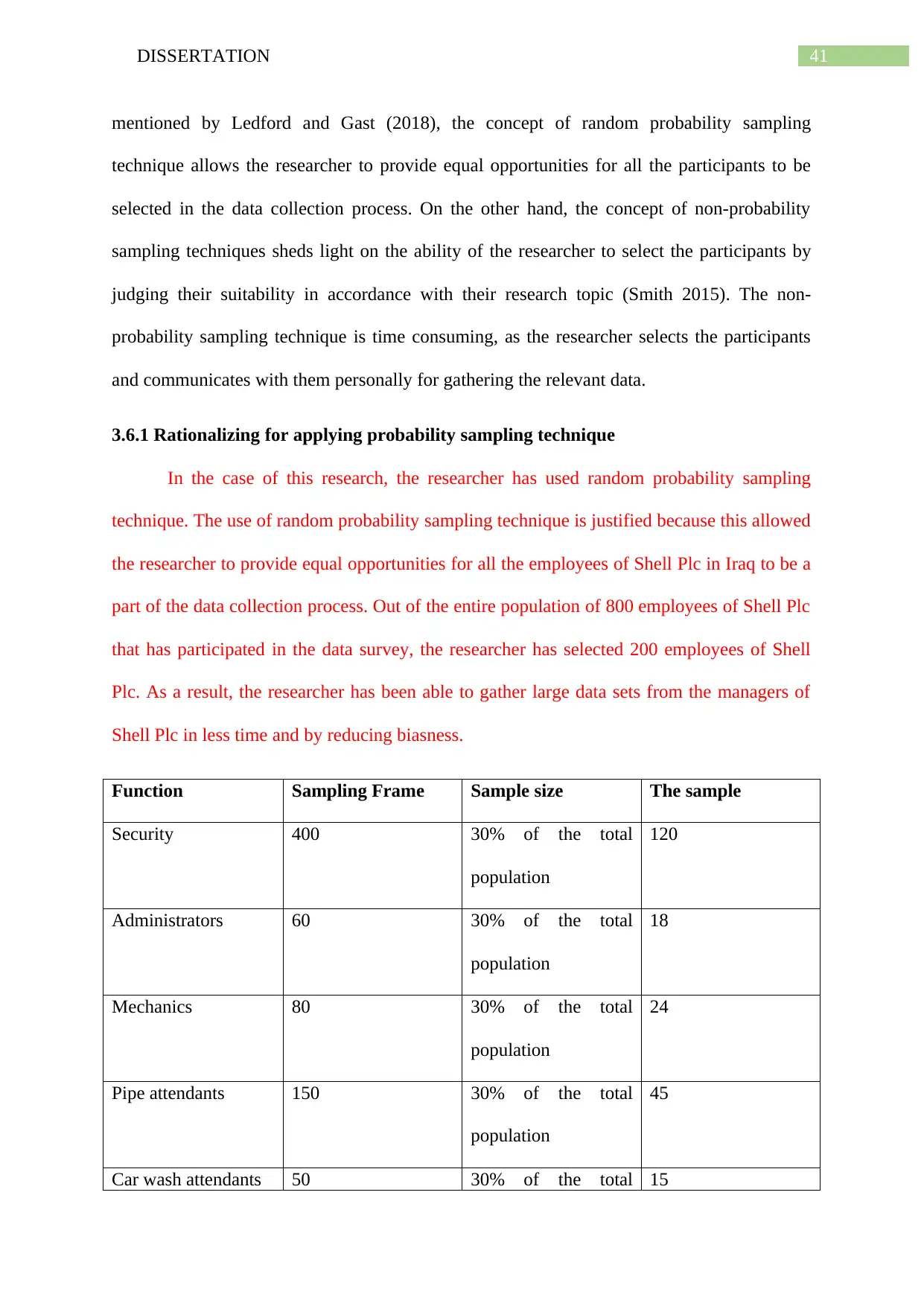
41DISSERTATION
mentioned by Ledford and Gast (2018), the concept of random probability sampling
technique allows the researcher to provide equal opportunities for all the participants to be
selected in the data collection process. On the other hand, the concept of non-probability
sampling techniques sheds light on the ability of the researcher to select the participants by
judging their suitability in accordance with their research topic (Smith 2015). The non-
probability sampling technique is time consuming, as the researcher selects the participants
and communicates with them personally for gathering the relevant data.
3.6.1 Rationalizing for applying probability sampling technique
In the case of this research, the researcher has used random probability sampling
technique. The use of random probability sampling technique is justified because this allowed
the researcher to provide equal opportunities for all the employees of Shell Plc in Iraq to be a
part of the data collection process. Out of the entire population of 800 employees of Shell Plc
that has participated in the data survey, the researcher has selected 200 employees of Shell
Plc. As a result, the researcher has been able to gather large data sets from the managers of
Shell Plc in less time and by reducing biasness.
Function Sampling Frame Sample size The sample
Security 400 30% of the total
population
120
Administrators 60 30% of the total
population
18
Mechanics 80 30% of the total
population
24
Pipe attendants 150 30% of the total
population
45
Car wash attendants 50 30% of the total 15
mentioned by Ledford and Gast (2018), the concept of random probability sampling
technique allows the researcher to provide equal opportunities for all the participants to be
selected in the data collection process. On the other hand, the concept of non-probability
sampling techniques sheds light on the ability of the researcher to select the participants by
judging their suitability in accordance with their research topic (Smith 2015). The non-
probability sampling technique is time consuming, as the researcher selects the participants
and communicates with them personally for gathering the relevant data.
3.6.1 Rationalizing for applying probability sampling technique
In the case of this research, the researcher has used random probability sampling
technique. The use of random probability sampling technique is justified because this allowed
the researcher to provide equal opportunities for all the employees of Shell Plc in Iraq to be a
part of the data collection process. Out of the entire population of 800 employees of Shell Plc
that has participated in the data survey, the researcher has selected 200 employees of Shell
Plc. As a result, the researcher has been able to gather large data sets from the managers of
Shell Plc in less time and by reducing biasness.
Function Sampling Frame Sample size The sample
Security 400 30% of the total
population
120
Administrators 60 30% of the total
population
18
Mechanics 80 30% of the total
population
24
Pipe attendants 150 30% of the total
population
45
Car wash attendants 50 30% of the total 15
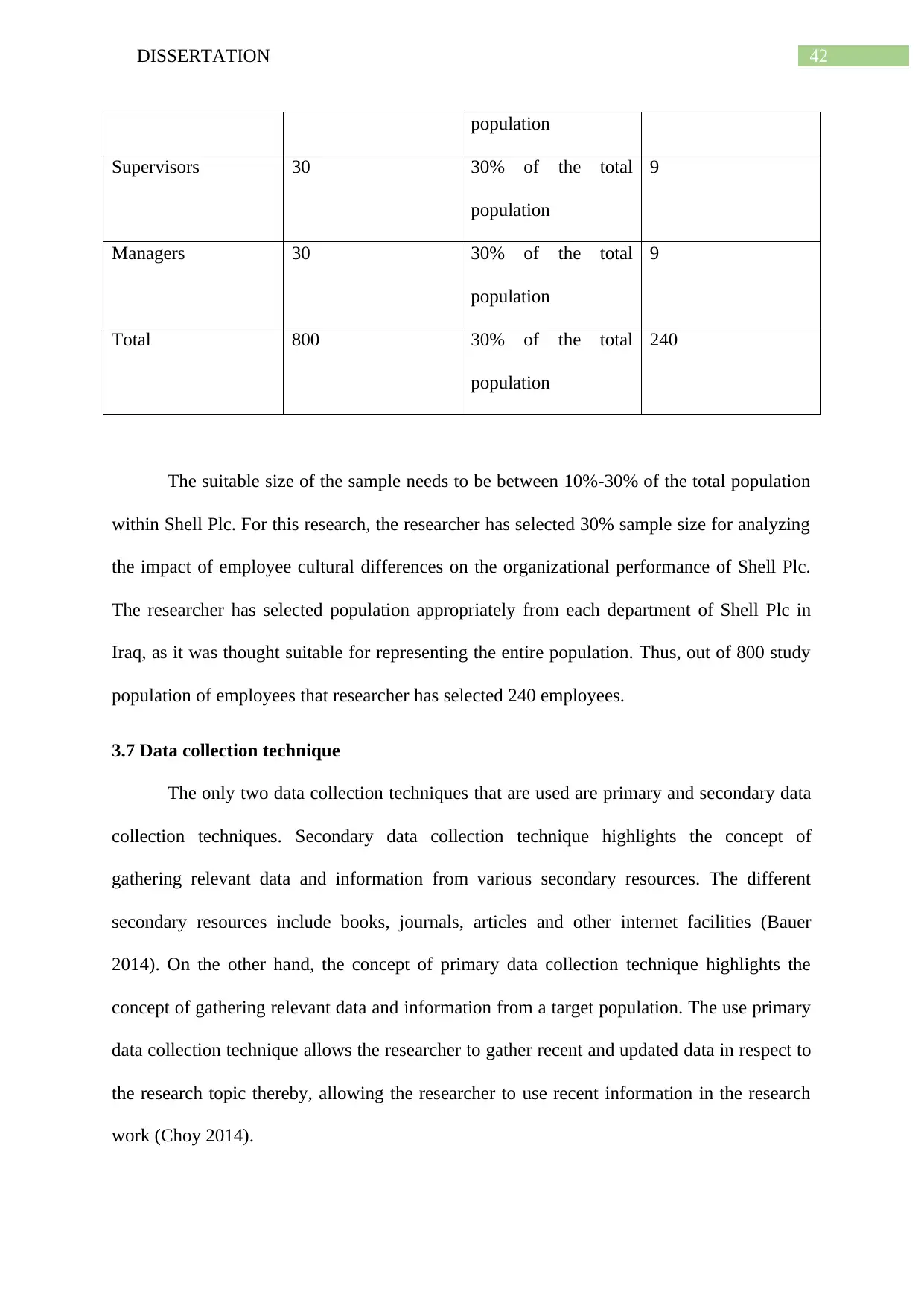
42DISSERTATION
population
Supervisors 30 30% of the total
population
9
Managers 30 30% of the total
population
9
Total 800 30% of the total
population
240
The suitable size of the sample needs to be between 10%-30% of the total population
within Shell Plc. For this research, the researcher has selected 30% sample size for analyzing
the impact of employee cultural differences on the organizational performance of Shell Plc.
The researcher has selected population appropriately from each department of Shell Plc in
Iraq, as it was thought suitable for representing the entire population. Thus, out of 800 study
population of employees that researcher has selected 240 employees.
3.7 Data collection technique
The only two data collection techniques that are used are primary and secondary data
collection techniques. Secondary data collection technique highlights the concept of
gathering relevant data and information from various secondary resources. The different
secondary resources include books, journals, articles and other internet facilities (Bauer
2014). On the other hand, the concept of primary data collection technique highlights the
concept of gathering relevant data and information from a target population. The use primary
data collection technique allows the researcher to gather recent and updated data in respect to
the research topic thereby, allowing the researcher to use recent information in the research
work (Choy 2014).
population
Supervisors 30 30% of the total
population
9
Managers 30 30% of the total
population
9
Total 800 30% of the total
population
240
The suitable size of the sample needs to be between 10%-30% of the total population
within Shell Plc. For this research, the researcher has selected 30% sample size for analyzing
the impact of employee cultural differences on the organizational performance of Shell Plc.
The researcher has selected population appropriately from each department of Shell Plc in
Iraq, as it was thought suitable for representing the entire population. Thus, out of 800 study
population of employees that researcher has selected 240 employees.
3.7 Data collection technique
The only two data collection techniques that are used are primary and secondary data
collection techniques. Secondary data collection technique highlights the concept of
gathering relevant data and information from various secondary resources. The different
secondary resources include books, journals, articles and other internet facilities (Bauer
2014). On the other hand, the concept of primary data collection technique highlights the
concept of gathering relevant data and information from a target population. The use primary
data collection technique allows the researcher to gather recent and updated data in respect to
the research topic thereby, allowing the researcher to use recent information in the research
work (Choy 2014).
Paraphrase This Document
Need a fresh take? Get an instant paraphrase of this document with our AI Paraphraser
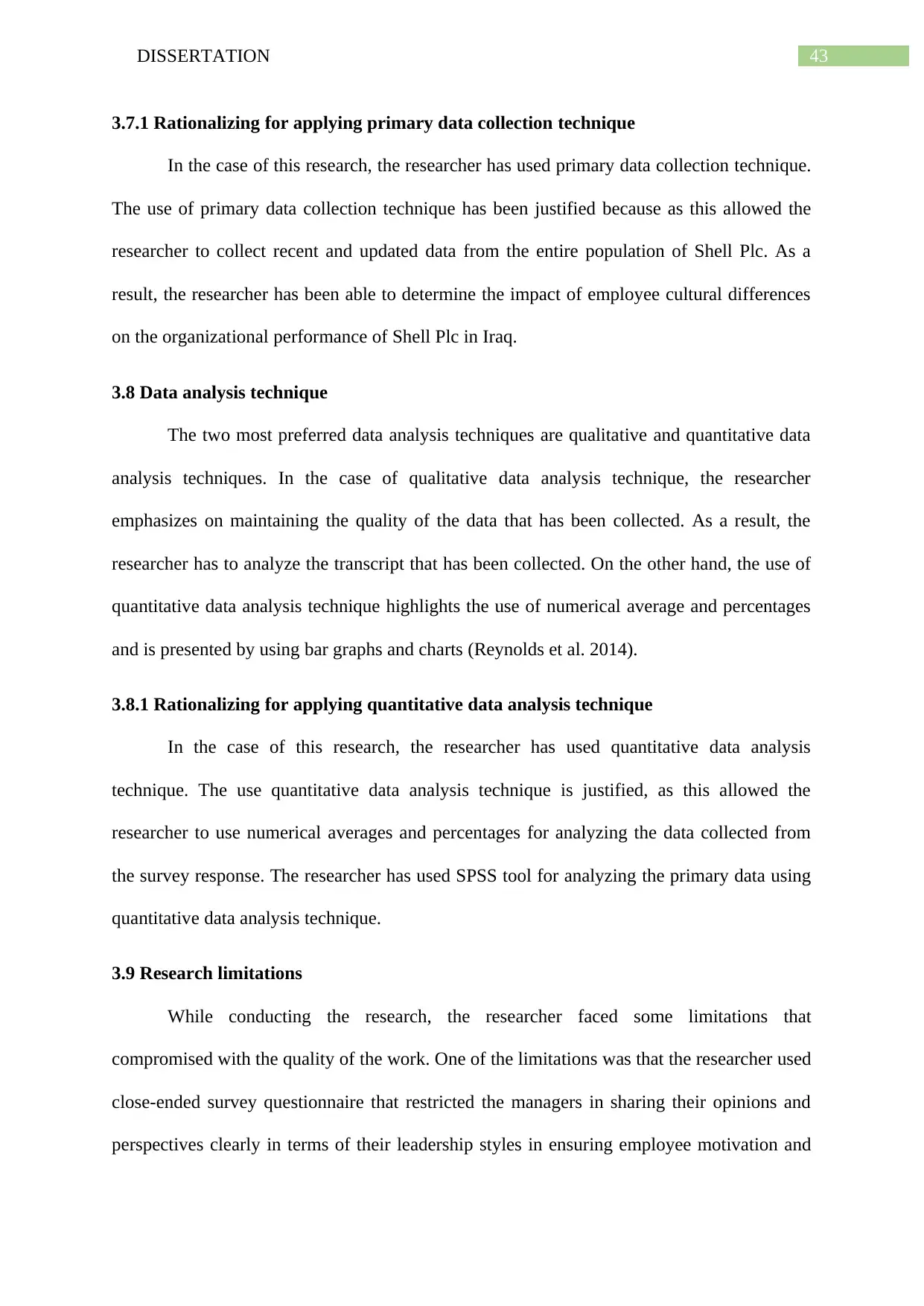
43DISSERTATION
3.7.1 Rationalizing for applying primary data collection technique
In the case of this research, the researcher has used primary data collection technique.
The use of primary data collection technique has been justified because as this allowed the
researcher to collect recent and updated data from the entire population of Shell Plc. As a
result, the researcher has been able to determine the impact of employee cultural differences
on the organizational performance of Shell Plc in Iraq.
3.8 Data analysis technique
The two most preferred data analysis techniques are qualitative and quantitative data
analysis techniques. In the case of qualitative data analysis technique, the researcher
emphasizes on maintaining the quality of the data that has been collected. As a result, the
researcher has to analyze the transcript that has been collected. On the other hand, the use of
quantitative data analysis technique highlights the use of numerical average and percentages
and is presented by using bar graphs and charts (Reynolds et al. 2014).
3.8.1 Rationalizing for applying quantitative data analysis technique
In the case of this research, the researcher has used quantitative data analysis
technique. The use quantitative data analysis technique is justified, as this allowed the
researcher to use numerical averages and percentages for analyzing the data collected from
the survey response. The researcher has used SPSS tool for analyzing the primary data using
quantitative data analysis technique.
3.9 Research limitations
While conducting the research, the researcher faced some limitations that
compromised with the quality of the work. One of the limitations was that the researcher used
close-ended survey questionnaire that restricted the managers in sharing their opinions and
perspectives clearly in terms of their leadership styles in ensuring employee motivation and
3.7.1 Rationalizing for applying primary data collection technique
In the case of this research, the researcher has used primary data collection technique.
The use of primary data collection technique has been justified because as this allowed the
researcher to collect recent and updated data from the entire population of Shell Plc. As a
result, the researcher has been able to determine the impact of employee cultural differences
on the organizational performance of Shell Plc in Iraq.
3.8 Data analysis technique
The two most preferred data analysis techniques are qualitative and quantitative data
analysis techniques. In the case of qualitative data analysis technique, the researcher
emphasizes on maintaining the quality of the data that has been collected. As a result, the
researcher has to analyze the transcript that has been collected. On the other hand, the use of
quantitative data analysis technique highlights the use of numerical average and percentages
and is presented by using bar graphs and charts (Reynolds et al. 2014).
3.8.1 Rationalizing for applying quantitative data analysis technique
In the case of this research, the researcher has used quantitative data analysis
technique. The use quantitative data analysis technique is justified, as this allowed the
researcher to use numerical averages and percentages for analyzing the data collected from
the survey response. The researcher has used SPSS tool for analyzing the primary data using
quantitative data analysis technique.
3.9 Research limitations
While conducting the research, the researcher faced some limitations that
compromised with the quality of the work. One of the limitations was that the researcher used
close-ended survey questionnaire that restricted the managers in sharing their opinions and
perspectives clearly in terms of their leadership styles in ensuring employee motivation and
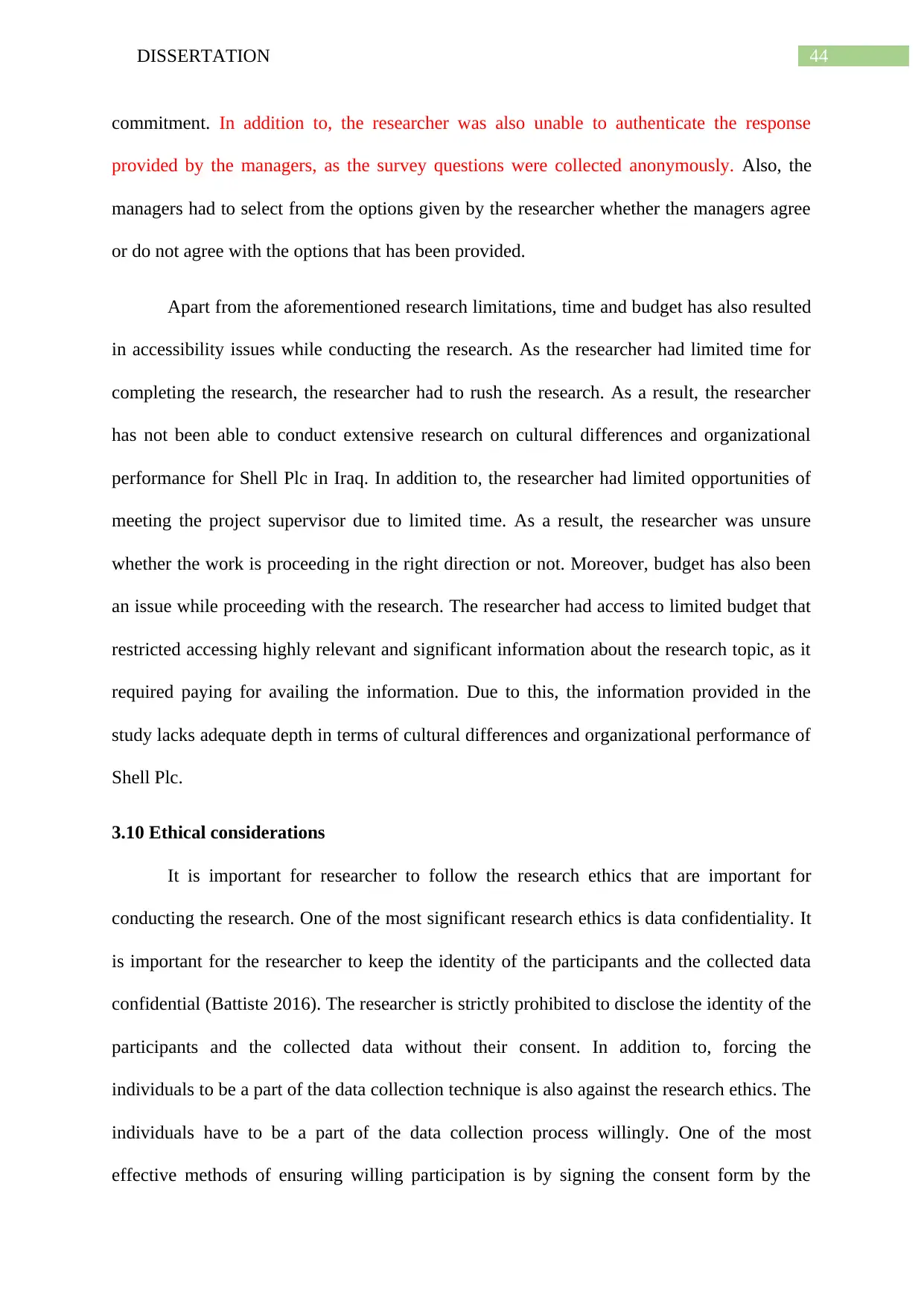
44DISSERTATION
commitment. In addition to, the researcher was also unable to authenticate the response
provided by the managers, as the survey questions were collected anonymously. Also, the
managers had to select from the options given by the researcher whether the managers agree
or do not agree with the options that has been provided.
Apart from the aforementioned research limitations, time and budget has also resulted
in accessibility issues while conducting the research. As the researcher had limited time for
completing the research, the researcher had to rush the research. As a result, the researcher
has not been able to conduct extensive research on cultural differences and organizational
performance for Shell Plc in Iraq. In addition to, the researcher had limited opportunities of
meeting the project supervisor due to limited time. As a result, the researcher was unsure
whether the work is proceeding in the right direction or not. Moreover, budget has also been
an issue while proceeding with the research. The researcher had access to limited budget that
restricted accessing highly relevant and significant information about the research topic, as it
required paying for availing the information. Due to this, the information provided in the
study lacks adequate depth in terms of cultural differences and organizational performance of
Shell Plc.
3.10 Ethical considerations
It is important for researcher to follow the research ethics that are important for
conducting the research. One of the most significant research ethics is data confidentiality. It
is important for the researcher to keep the identity of the participants and the collected data
confidential (Battiste 2016). The researcher is strictly prohibited to disclose the identity of the
participants and the collected data without their consent. In addition to, forcing the
individuals to be a part of the data collection technique is also against the research ethics. The
individuals have to be a part of the data collection process willingly. One of the most
effective methods of ensuring willing participation is by signing the consent form by the
commitment. In addition to, the researcher was also unable to authenticate the response
provided by the managers, as the survey questions were collected anonymously. Also, the
managers had to select from the options given by the researcher whether the managers agree
or do not agree with the options that has been provided.
Apart from the aforementioned research limitations, time and budget has also resulted
in accessibility issues while conducting the research. As the researcher had limited time for
completing the research, the researcher had to rush the research. As a result, the researcher
has not been able to conduct extensive research on cultural differences and organizational
performance for Shell Plc in Iraq. In addition to, the researcher had limited opportunities of
meeting the project supervisor due to limited time. As a result, the researcher was unsure
whether the work is proceeding in the right direction or not. Moreover, budget has also been
an issue while proceeding with the research. The researcher had access to limited budget that
restricted accessing highly relevant and significant information about the research topic, as it
required paying for availing the information. Due to this, the information provided in the
study lacks adequate depth in terms of cultural differences and organizational performance of
Shell Plc.
3.10 Ethical considerations
It is important for researcher to follow the research ethics that are important for
conducting the research. One of the most significant research ethics is data confidentiality. It
is important for the researcher to keep the identity of the participants and the collected data
confidential (Battiste 2016). The researcher is strictly prohibited to disclose the identity of the
participants and the collected data without their consent. In addition to, forcing the
individuals to be a part of the data collection technique is also against the research ethics. The
individuals have to be a part of the data collection process willingly. One of the most
effective methods of ensuring willing participation is by signing the consent form by the

45DISSERTATION
individuals. Another important ethical considerations that is crucial is completing the
research successfully is collecting data from authentic resources. Also, the researcher has to
present authentic data in the research wok. Modifying the data and the information is against
the research ethics. Lastly, the data and information collected by the researcher has to be used
for academic purpose only (Faden 2013).
Apart from the aforementioned ethical consideration, the researcher also made sure
that the participants were not subjected to any sort of danger. The researcher ensured that the
dignity of the participants was maintained, as those are considered as vital sources of
information. Another significant ethical consideration that the researcher ensured that there is
no intruder while the researcher was interviewing the participants. The researcher also made
it a point that the work of other researchers was acknowledged simultaneous to this work.
3.11 Summary
In this chapter, it can be summarized that the aforementioned research methodologies
selected by the researcher has been appropriate for achieving the research aim and objectives.
The use of appropriate research methodologies has allowed the researcher to analyze the
impact of employee cultural differences on the organizational performance of Shell Plc. In
addition to, this section also states the significant research ethics that has been followed by
the researcher that has helped in maintaining the quality of the research work.
individuals. Another important ethical considerations that is crucial is completing the
research successfully is collecting data from authentic resources. Also, the researcher has to
present authentic data in the research wok. Modifying the data and the information is against
the research ethics. Lastly, the data and information collected by the researcher has to be used
for academic purpose only (Faden 2013).
Apart from the aforementioned ethical consideration, the researcher also made sure
that the participants were not subjected to any sort of danger. The researcher ensured that the
dignity of the participants was maintained, as those are considered as vital sources of
information. Another significant ethical consideration that the researcher ensured that there is
no intruder while the researcher was interviewing the participants. The researcher also made
it a point that the work of other researchers was acknowledged simultaneous to this work.
3.11 Summary
In this chapter, it can be summarized that the aforementioned research methodologies
selected by the researcher has been appropriate for achieving the research aim and objectives.
The use of appropriate research methodologies has allowed the researcher to analyze the
impact of employee cultural differences on the organizational performance of Shell Plc. In
addition to, this section also states the significant research ethics that has been followed by
the researcher that has helped in maintaining the quality of the research work.
Secure Best Marks with AI Grader
Need help grading? Try our AI Grader for instant feedback on your assignments.

46DISSERTATION
Chapter 4: Data analysis
4.0 Overview
In this data analysis chapter, the survey responses collected by using the
methodological tools mentioned in the previous chapter is analyzed for determining whether
the cultural differences among the employees in Shell in Iraq affect the organizational
performance. The results of the analyses are presented by using graphs and charts that helps
in understanding the survey responses. In this chapter, both descriptive and inferential
analysis are used that allowed the researcher to undertake an in-depth analysis on
investigating the impact of employee cultural differences on the performance of the
organization, in this case, Shell Plc in Iraq. As a result, the researcher is able to determine the
impact thereby, accepting or rejecting the null hypothesis with suitable justifications.
Chapter 4: Data analysis
4.0 Overview
In this data analysis chapter, the survey responses collected by using the
methodological tools mentioned in the previous chapter is analyzed for determining whether
the cultural differences among the employees in Shell in Iraq affect the organizational
performance. The results of the analyses are presented by using graphs and charts that helps
in understanding the survey responses. In this chapter, both descriptive and inferential
analysis are used that allowed the researcher to undertake an in-depth analysis on
investigating the impact of employee cultural differences on the performance of the
organization, in this case, Shell Plc in Iraq. As a result, the researcher is able to determine the
impact thereby, accepting or rejecting the null hypothesis with suitable justifications.

47DISSERTATION
4.1 Descriptive analysis
4.1.1 Demographic analysis
Figure 2: Demographic analysis
From the above conducted descriptive analysis, it can be inferred that the majority of
the employees of Shell Plc in Iraq who took part in the survey are female aged 18-29 years
followed by aged 30-39 years with an educational qualification of masters or doctorate
degree working in Shell Plc for less than three years and 3-6 years.
Taking into consideration the mindset of Iraq in terms of male and female inequality,
it can be said inferred that the female employees are supposed to face cultural differences at
workplace. As Shell Plc is a multi-national company that operates in major continents such as
Africa, Asia, Europe, Australia and North America, sending employees for on-site projects is
a common thing. Similarly, Shell Plc has employees posted on on-site projects in Iraq that
4.1 Descriptive analysis
4.1.1 Demographic analysis
Figure 2: Demographic analysis
From the above conducted descriptive analysis, it can be inferred that the majority of
the employees of Shell Plc in Iraq who took part in the survey are female aged 18-29 years
followed by aged 30-39 years with an educational qualification of masters or doctorate
degree working in Shell Plc for less than three years and 3-6 years.
Taking into consideration the mindset of Iraq in terms of male and female inequality,
it can be said inferred that the female employees are supposed to face cultural differences at
workplace. As Shell Plc is a multi-national company that operates in major continents such as
Africa, Asia, Europe, Australia and North America, sending employees for on-site projects is
a common thing. Similarly, Shell Plc has employees posted on on-site projects in Iraq that
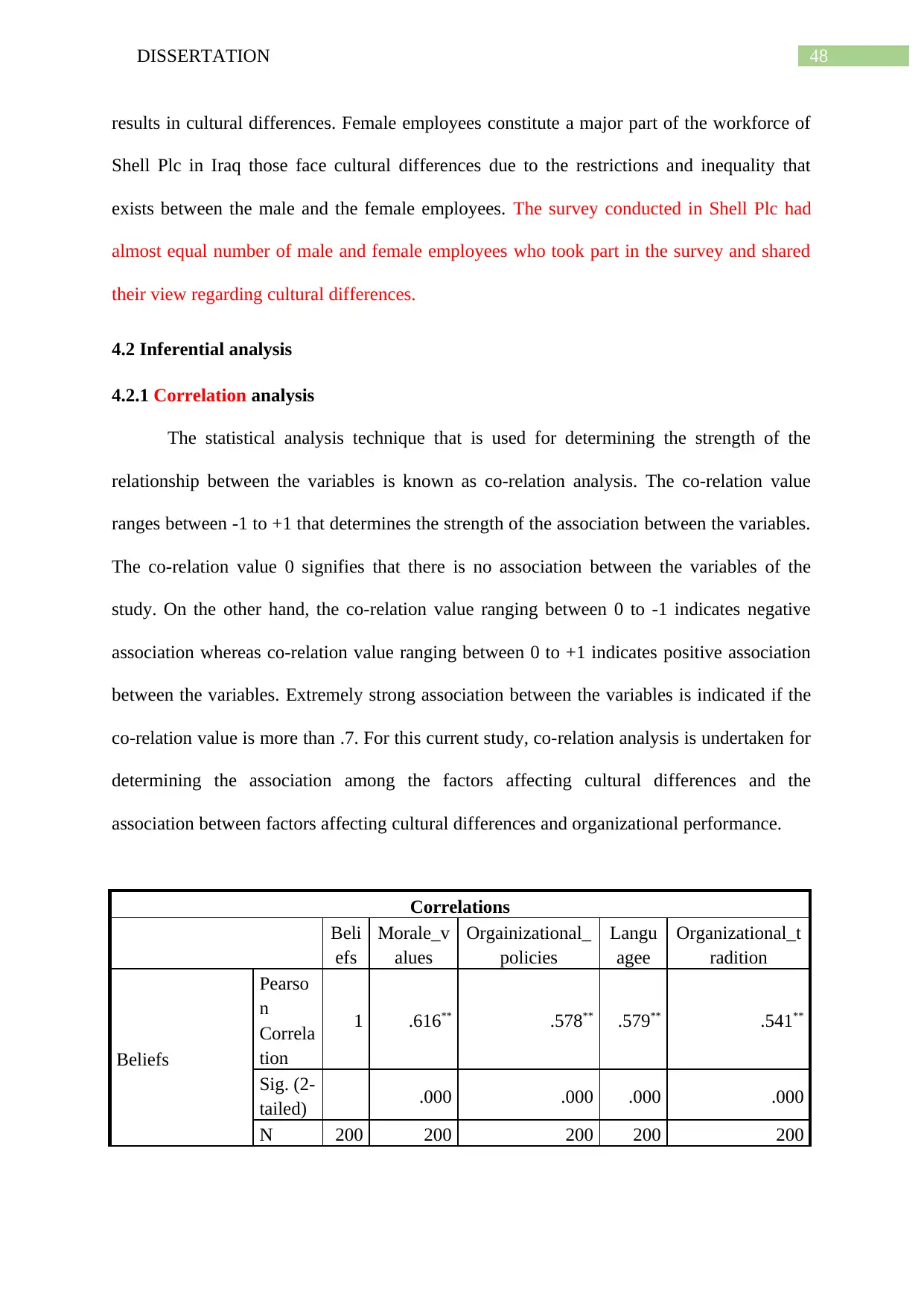
48DISSERTATION
results in cultural differences. Female employees constitute a major part of the workforce of
Shell Plc in Iraq those face cultural differences due to the restrictions and inequality that
exists between the male and the female employees. The survey conducted in Shell Plc had
almost equal number of male and female employees who took part in the survey and shared
their view regarding cultural differences.
4.2 Inferential analysis
4.2.1 Correlation analysis
The statistical analysis technique that is used for determining the strength of the
relationship between the variables is known as co-relation analysis. The co-relation value
ranges between -1 to +1 that determines the strength of the association between the variables.
The co-relation value 0 signifies that there is no association between the variables of the
study. On the other hand, the co-relation value ranging between 0 to -1 indicates negative
association whereas co-relation value ranging between 0 to +1 indicates positive association
between the variables. Extremely strong association between the variables is indicated if the
co-relation value is more than .7. For this current study, co-relation analysis is undertaken for
determining the association among the factors affecting cultural differences and the
association between factors affecting cultural differences and organizational performance.
Correlations
Beli
efs
Morale_v
alues
Orgainizational_
policies
Langu
agee
Organizational_t
radition
Beliefs
Pearso
n
Correla
tion
1 .616** .578** .579** .541**
Sig. (2-
tailed) .000 .000 .000 .000
N 200 200 200 200 200
results in cultural differences. Female employees constitute a major part of the workforce of
Shell Plc in Iraq those face cultural differences due to the restrictions and inequality that
exists between the male and the female employees. The survey conducted in Shell Plc had
almost equal number of male and female employees who took part in the survey and shared
their view regarding cultural differences.
4.2 Inferential analysis
4.2.1 Correlation analysis
The statistical analysis technique that is used for determining the strength of the
relationship between the variables is known as co-relation analysis. The co-relation value
ranges between -1 to +1 that determines the strength of the association between the variables.
The co-relation value 0 signifies that there is no association between the variables of the
study. On the other hand, the co-relation value ranging between 0 to -1 indicates negative
association whereas co-relation value ranging between 0 to +1 indicates positive association
between the variables. Extremely strong association between the variables is indicated if the
co-relation value is more than .7. For this current study, co-relation analysis is undertaken for
determining the association among the factors affecting cultural differences and the
association between factors affecting cultural differences and organizational performance.
Correlations
Beli
efs
Morale_v
alues
Orgainizational_
policies
Langu
agee
Organizational_t
radition
Beliefs
Pearso
n
Correla
tion
1 .616** .578** .579** .541**
Sig. (2-
tailed) .000 .000 .000 .000
N 200 200 200 200 200
Paraphrase This Document
Need a fresh take? Get an instant paraphrase of this document with our AI Paraphraser
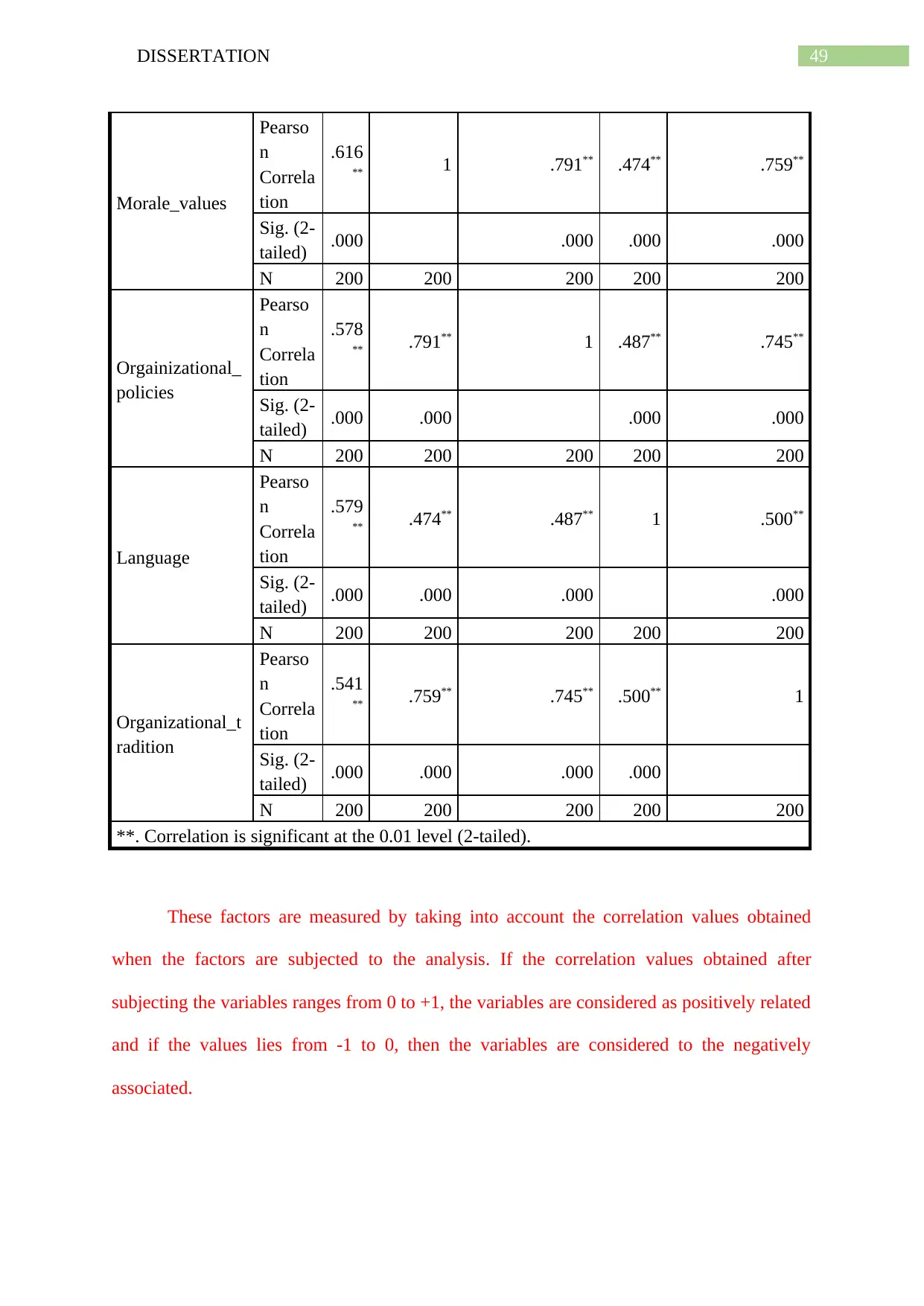
49DISSERTATION
Morale_values
Pearso
n
Correla
tion
.616
** 1 .791** .474** .759**
Sig. (2-
tailed) .000 .000 .000 .000
N 200 200 200 200 200
Orgainizational_
policies
Pearso
n
Correla
tion
.578
** .791** 1 .487** .745**
Sig. (2-
tailed) .000 .000 .000 .000
N 200 200 200 200 200
Language
Pearso
n
Correla
tion
.579
** .474** .487** 1 .500**
Sig. (2-
tailed) .000 .000 .000 .000
N 200 200 200 200 200
Organizational_t
radition
Pearso
n
Correla
tion
.541
** .759** .745** .500** 1
Sig. (2-
tailed) .000 .000 .000 .000
N 200 200 200 200 200
**. Correlation is significant at the 0.01 level (2-tailed).
These factors are measured by taking into account the correlation values obtained
when the factors are subjected to the analysis. If the correlation values obtained after
subjecting the variables ranges from 0 to +1, the variables are considered as positively related
and if the values lies from -1 to 0, then the variables are considered to the negatively
associated.
Morale_values
Pearso
n
Correla
tion
.616
** 1 .791** .474** .759**
Sig. (2-
tailed) .000 .000 .000 .000
N 200 200 200 200 200
Orgainizational_
policies
Pearso
n
Correla
tion
.578
** .791** 1 .487** .745**
Sig. (2-
tailed) .000 .000 .000 .000
N 200 200 200 200 200
Language
Pearso
n
Correla
tion
.579
** .474** .487** 1 .500**
Sig. (2-
tailed) .000 .000 .000 .000
N 200 200 200 200 200
Organizational_t
radition
Pearso
n
Correla
tion
.541
** .759** .745** .500** 1
Sig. (2-
tailed) .000 .000 .000 .000
N 200 200 200 200 200
**. Correlation is significant at the 0.01 level (2-tailed).
These factors are measured by taking into account the correlation values obtained
when the factors are subjected to the analysis. If the correlation values obtained after
subjecting the variables ranges from 0 to +1, the variables are considered as positively related
and if the values lies from -1 to 0, then the variables are considered to the negatively
associated.

50DISSERTATION
From the above presented co-relation table, it can be inferred that the organizational
policies and organizational tradition are strongly associated with the beliefs of the employees,
as the co-relation values obtained are .791 and .759 those are more than .7. The above-
correlation table highlights that all the factors affecting cultural dimensions among the
employees are positively co-related with each other. Starting from the first factor, it can be
seen that belief is positively co-related with morale values, organizational policies, language
and organizational tradition as the values obtained are .616, .578, .579 and .541 respectively.
Similarly, the correlation values between morale values and beliefs, organizational policies,
language and organizational tradition are .616, .791, .474 and .759 respectively. In this set of
value, the co-relation values between morale and organizational policies and organizational
tradition is said to be strongly associated, as the values obtained are more than 0.7. The co-
relation value between organizational policies and beliefs, morale values, language and
organizational tradition are .578, .791, .487 and .745 respectively. In this set of value, the co-
relation values between morale and organizational policies and organizational tradition is said
to be strongly associated, as the values obtained are more than 0.7. The correlation values
between language and beliefs, morale values, organizational policies and organizational
tradition are .579, .474, .487 and .500 respectively. The values signify that the factors are
positively related to each other.
Correlations
Organization
al_performan
ce
Cultural_diff
erences_orga
nizational_pe
rformance
Independent
_Variable
Organizational_perfor
mance
Pearson
Correlation 1 .651** .830**
Sig. (2-tailed) .000 .000
N 200 200 200
Cultural_differences_o
rganizational_performa
Pearson
Correlation
.651** 1 .704**
From the above presented co-relation table, it can be inferred that the organizational
policies and organizational tradition are strongly associated with the beliefs of the employees,
as the co-relation values obtained are .791 and .759 those are more than .7. The above-
correlation table highlights that all the factors affecting cultural dimensions among the
employees are positively co-related with each other. Starting from the first factor, it can be
seen that belief is positively co-related with morale values, organizational policies, language
and organizational tradition as the values obtained are .616, .578, .579 and .541 respectively.
Similarly, the correlation values between morale values and beliefs, organizational policies,
language and organizational tradition are .616, .791, .474 and .759 respectively. In this set of
value, the co-relation values between morale and organizational policies and organizational
tradition is said to be strongly associated, as the values obtained are more than 0.7. The co-
relation value between organizational policies and beliefs, morale values, language and
organizational tradition are .578, .791, .487 and .745 respectively. In this set of value, the co-
relation values between morale and organizational policies and organizational tradition is said
to be strongly associated, as the values obtained are more than 0.7. The correlation values
between language and beliefs, morale values, organizational policies and organizational
tradition are .579, .474, .487 and .500 respectively. The values signify that the factors are
positively related to each other.
Correlations
Organization
al_performan
ce
Cultural_diff
erences_orga
nizational_pe
rformance
Independent
_Variable
Organizational_perfor
mance
Pearson
Correlation 1 .651** .830**
Sig. (2-tailed) .000 .000
N 200 200 200
Cultural_differences_o
rganizational_performa
Pearson
Correlation
.651** 1 .704**

51DISSERTATION
nce Sig. (2-tailed) .000 .000
N 200 200 200
Independent_Variable
Pearson
Correlation .830** .704** 1
Sig. (2-tailed) .000 .000
N 200 200 200
**. Correlation is significant at the 0.01 level (2-tailed).
In the above correlation table, the independent variable is the factors affecting cultural
differences those are beliefs, morale values, organizational policies, language and
organizational traditions. For the above analysis, the sub-factors affecting the factors are
clubbed under it those in turn are clubbed together under the variable name independent
variable.
From the above-mentioned co-relation table, it can be inferred that the independent
variables such as beliefs, language, morale values, organizational policies and tradition is
strongly associated with organizational performance, as the value obtained is .830 that is
more than 0.7. The variables are measured by subjecting them into the correlation analysis
and interpreting the values obtained accordingly. From the above conducted co-relation
analysis, it can be seen that the co-relation values between cultural differences and
organizational performance is .830. As the value obtained is more than 0.7, it signifies strong
association between the two variables. Therefore, it can be inferred that the factors affecting
cultural dimensions are positively related with the performance of the organizations.
4.2.2 Regression analysis
For this study, regression analysis is conducted for investigating whether cultural
differences have an impact on organizational performance or not. Two hypotheses related to
the topic has been formulated those are categorized as null and alternate hypothesis. The
acceptance and rejection of the formulated hypotheses for the ongoing research is based on
the p-value derived. If the p-value obtained is less than 0.05 then the null hypothesis is
nce Sig. (2-tailed) .000 .000
N 200 200 200
Independent_Variable
Pearson
Correlation .830** .704** 1
Sig. (2-tailed) .000 .000
N 200 200 200
**. Correlation is significant at the 0.01 level (2-tailed).
In the above correlation table, the independent variable is the factors affecting cultural
differences those are beliefs, morale values, organizational policies, language and
organizational traditions. For the above analysis, the sub-factors affecting the factors are
clubbed under it those in turn are clubbed together under the variable name independent
variable.
From the above-mentioned co-relation table, it can be inferred that the independent
variables such as beliefs, language, morale values, organizational policies and tradition is
strongly associated with organizational performance, as the value obtained is .830 that is
more than 0.7. The variables are measured by subjecting them into the correlation analysis
and interpreting the values obtained accordingly. From the above conducted co-relation
analysis, it can be seen that the co-relation values between cultural differences and
organizational performance is .830. As the value obtained is more than 0.7, it signifies strong
association between the two variables. Therefore, it can be inferred that the factors affecting
cultural dimensions are positively related with the performance of the organizations.
4.2.2 Regression analysis
For this study, regression analysis is conducted for investigating whether cultural
differences have an impact on organizational performance or not. Two hypotheses related to
the topic has been formulated those are categorized as null and alternate hypothesis. The
acceptance and rejection of the formulated hypotheses for the ongoing research is based on
the p-value derived. If the p-value obtained is less than 0.05 then the null hypothesis is
Secure Best Marks with AI Grader
Need help grading? Try our AI Grader for instant feedback on your assignments.

52DISSERTATION
rejected thereby, indicating cultural differences have a significant impact on the
organizational performance. However, if the p-value is more than 0.05 then it indicates that
cultural differences among the employees have no impact on the organizational
performances.
Model Summary
Mode
l
R R Square Adjusted R
Square
Std. Error of
the Estimate
1 .871a .758 .752 .60240
a. Predictors: (Constant), Organizational_tradition,
Languagee, Beliefs, Orgainizational_policies,
Morale_values
ANOVAa
Model Sum of
Squares
df Mean
Square
F Sig.
1
Regression 220.680 5 44.136 121.625 .000b
Residual 70.400 194 .363
Total 291.080 199
a. Dependent Variable: Organizational_performance
b. Predictors: (Constant), Organizational_tradition, Languagee, Beliefs,
Orgainizational_policies, Morale_values
Coefficientsa
Model Unstandardized
Coefficients
Standardize
d
Coefficients
t Sig. 95.0%
Confidence
Interval for B
B Std.
Error
Beta Lower
Bound
Upper
Bound
1
(Constant) .176 .146 1.20
6
.22
9 -.112 .463
Beliefs -.091 .052 -.087
-
1.75
7
.08
0 -.194 .011
Morale_values .319 .065 .322 4.89
5
.00
0 .190 .447
Orgainizational_policie
s .329 .063 .328 5.22
6
.00
0 .205 .453
rejected thereby, indicating cultural differences have a significant impact on the
organizational performance. However, if the p-value is more than 0.05 then it indicates that
cultural differences among the employees have no impact on the organizational
performances.
Model Summary
Mode
l
R R Square Adjusted R
Square
Std. Error of
the Estimate
1 .871a .758 .752 .60240
a. Predictors: (Constant), Organizational_tradition,
Languagee, Beliefs, Orgainizational_policies,
Morale_values
ANOVAa
Model Sum of
Squares
df Mean
Square
F Sig.
1
Regression 220.680 5 44.136 121.625 .000b
Residual 70.400 194 .363
Total 291.080 199
a. Dependent Variable: Organizational_performance
b. Predictors: (Constant), Organizational_tradition, Languagee, Beliefs,
Orgainizational_policies, Morale_values
Coefficientsa
Model Unstandardized
Coefficients
Standardize
d
Coefficients
t Sig. 95.0%
Confidence
Interval for B
B Std.
Error
Beta Lower
Bound
Upper
Bound
1
(Constant) .176 .146 1.20
6
.22
9 -.112 .463
Beliefs -.091 .052 -.087
-
1.75
7
.08
0 -.194 .011
Morale_values .319 .065 .322 4.89
5
.00
0 .190 .447
Orgainizational_policie
s .329 .063 .328 5.22
6
.00
0 .205 .453

53DISSERTATION
Languagee .109 .049 .100 2.22
1
.02
7 .012 .206
Organizational_traditio
n .296 .060 .295 4.97
3
.00
0 .179 .414
a. Dependent Variable: Organizational_performance
From the above table, the results obtained from the regression analysis highlights the
p-value to be .000 that is less than .05. From the description, it can be known that p-value less
than .05 suggests the rejection of null hypothesis. Hence, it can be said that the alternate
hypothesis is accepted thereby, inferring that cultural differences has an impact on the
organizational performance.
4.3 Summary
Thus, in this chapter, it can be summarized that employee cultural differences affect
the organizational performance. From the co-relation analysis, it can be inferred that the
organizational policies and organizational tradition are strongly associated with the beliefs of
the employees, as the co-relation values obtained are .791 and .759 those are more than .7.
Moreover, the co-relation value also indicates strong association between morale values of
the employees and organizational tradition, as the value obtained is .745 that is more than .7.
The second co-relation analysis indicates that the independent variables such as beliefs,
language, morale values, organizational policies and tradition is strongly associated with
organizational performance, as the value obtained is .830 that is more than .7.
Moreover, the result obtained from the regression analysis indicates that the p-value is
.000 that is less than .05. Hence, it can be said that the null hypothesis has been rejected and
the alternative hypothesis has been accepted. The result of the regression analysis is
supported by the results obtained from the second co-relation analysis that indicates strong
Languagee .109 .049 .100 2.22
1
.02
7 .012 .206
Organizational_traditio
n .296 .060 .295 4.97
3
.00
0 .179 .414
a. Dependent Variable: Organizational_performance
From the above table, the results obtained from the regression analysis highlights the
p-value to be .000 that is less than .05. From the description, it can be known that p-value less
than .05 suggests the rejection of null hypothesis. Hence, it can be said that the alternate
hypothesis is accepted thereby, inferring that cultural differences has an impact on the
organizational performance.
4.3 Summary
Thus, in this chapter, it can be summarized that employee cultural differences affect
the organizational performance. From the co-relation analysis, it can be inferred that the
organizational policies and organizational tradition are strongly associated with the beliefs of
the employees, as the co-relation values obtained are .791 and .759 those are more than .7.
Moreover, the co-relation value also indicates strong association between morale values of
the employees and organizational tradition, as the value obtained is .745 that is more than .7.
The second co-relation analysis indicates that the independent variables such as beliefs,
language, morale values, organizational policies and tradition is strongly associated with
organizational performance, as the value obtained is .830 that is more than .7.
Moreover, the result obtained from the regression analysis indicates that the p-value is
.000 that is less than .05. Hence, it can be said that the null hypothesis has been rejected and
the alternative hypothesis has been accepted. The result of the regression analysis is
supported by the results obtained from the second co-relation analysis that indicates strong
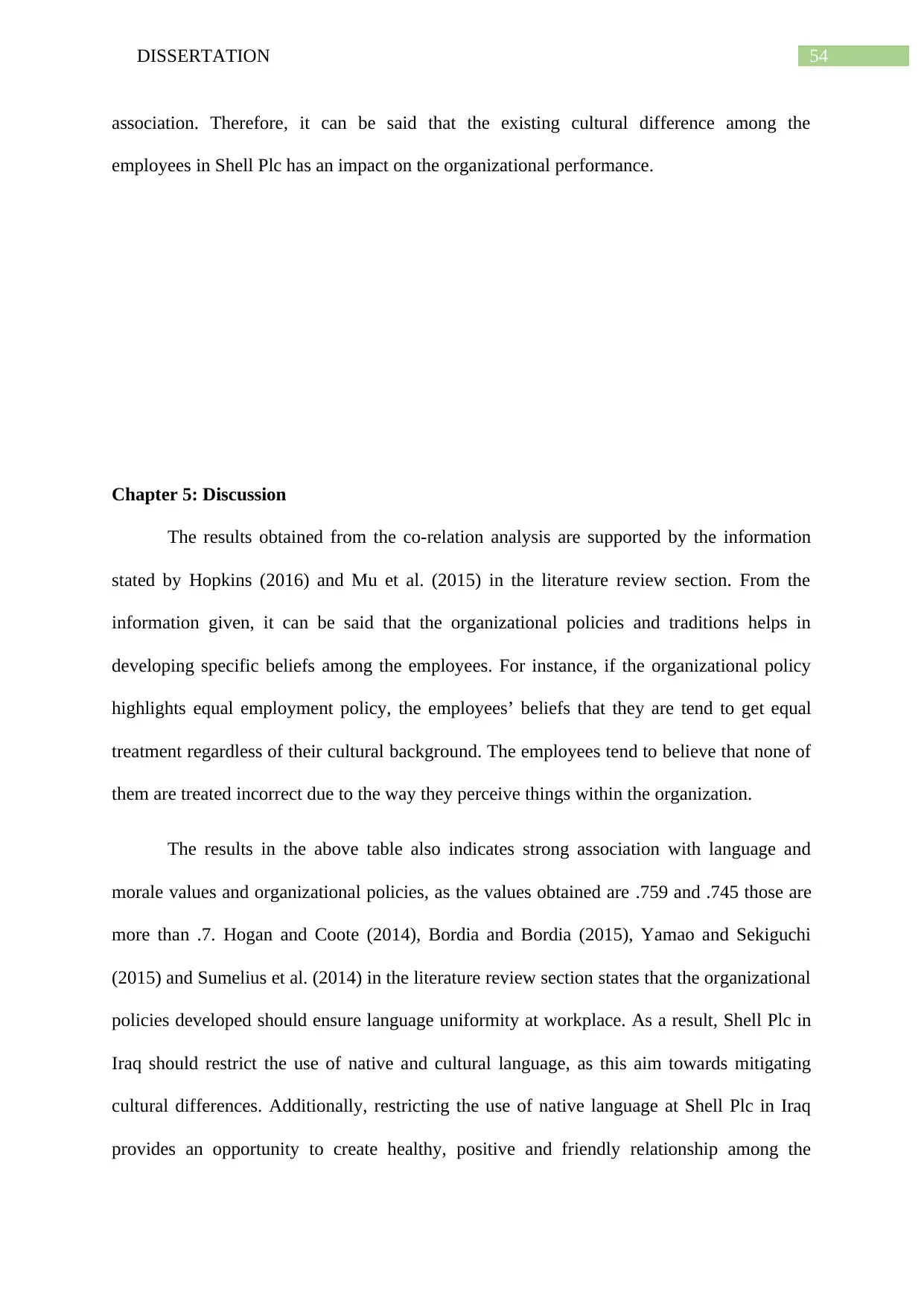
54DISSERTATION
association. Therefore, it can be said that the existing cultural difference among the
employees in Shell Plc has an impact on the organizational performance.
Chapter 5: Discussion
The results obtained from the co-relation analysis are supported by the information
stated by Hopkins (2016) and Mu et al. (2015) in the literature review section. From the
information given, it can be said that the organizational policies and traditions helps in
developing specific beliefs among the employees. For instance, if the organizational policy
highlights equal employment policy, the employees’ beliefs that they are tend to get equal
treatment regardless of their cultural background. The employees tend to believe that none of
them are treated incorrect due to the way they perceive things within the organization.
The results in the above table also indicates strong association with language and
morale values and organizational policies, as the values obtained are .759 and .745 those are
more than .7. Hogan and Coote (2014), Bordia and Bordia (2015), Yamao and Sekiguchi
(2015) and Sumelius et al. (2014) in the literature review section states that the organizational
policies developed should ensure language uniformity at workplace. As a result, Shell Plc in
Iraq should restrict the use of native and cultural language, as this aim towards mitigating
cultural differences. Additionally, restricting the use of native language at Shell Plc in Iraq
provides an opportunity to create healthy, positive and friendly relationship among the
association. Therefore, it can be said that the existing cultural difference among the
employees in Shell Plc has an impact on the organizational performance.
Chapter 5: Discussion
The results obtained from the co-relation analysis are supported by the information
stated by Hopkins (2016) and Mu et al. (2015) in the literature review section. From the
information given, it can be said that the organizational policies and traditions helps in
developing specific beliefs among the employees. For instance, if the organizational policy
highlights equal employment policy, the employees’ beliefs that they are tend to get equal
treatment regardless of their cultural background. The employees tend to believe that none of
them are treated incorrect due to the way they perceive things within the organization.
The results in the above table also indicates strong association with language and
morale values and organizational policies, as the values obtained are .759 and .745 those are
more than .7. Hogan and Coote (2014), Bordia and Bordia (2015), Yamao and Sekiguchi
(2015) and Sumelius et al. (2014) in the literature review section states that the organizational
policies developed should ensure language uniformity at workplace. As a result, Shell Plc in
Iraq should restrict the use of native and cultural language, as this aim towards mitigating
cultural differences. Additionally, restricting the use of native language at Shell Plc in Iraq
provides an opportunity to create healthy, positive and friendly relationship among the
Paraphrase This Document
Need a fresh take? Get an instant paraphrase of this document with our AI Paraphraser
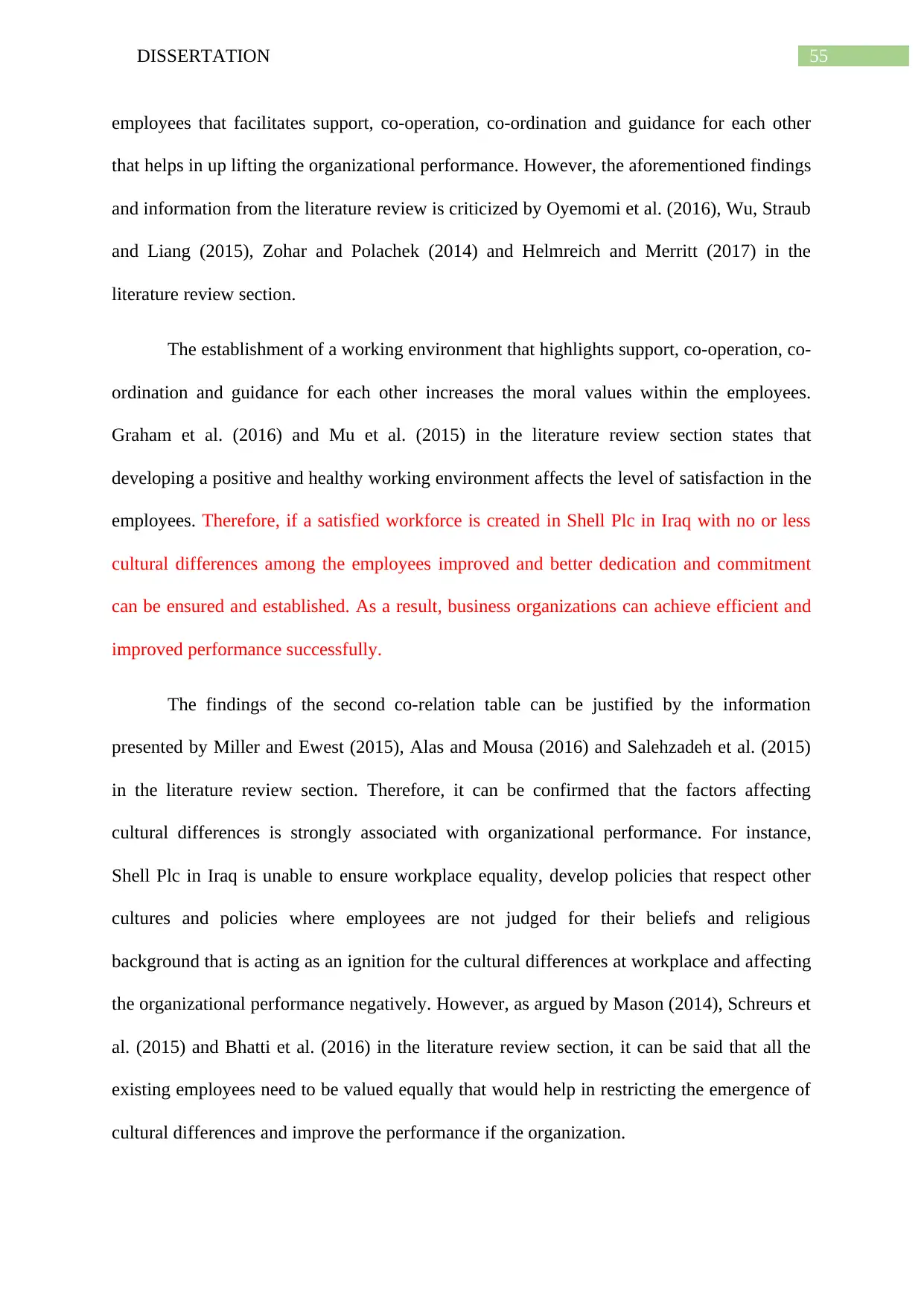
55DISSERTATION
employees that facilitates support, co-operation, co-ordination and guidance for each other
that helps in up lifting the organizational performance. However, the aforementioned findings
and information from the literature review is criticized by Oyemomi et al. (2016), Wu, Straub
and Liang (2015), Zohar and Polachek (2014) and Helmreich and Merritt (2017) in the
literature review section.
The establishment of a working environment that highlights support, co-operation, co-
ordination and guidance for each other increases the moral values within the employees.
Graham et al. (2016) and Mu et al. (2015) in the literature review section states that
developing a positive and healthy working environment affects the level of satisfaction in the
employees. Therefore, if a satisfied workforce is created in Shell Plc in Iraq with no or less
cultural differences among the employees improved and better dedication and commitment
can be ensured and established. As a result, business organizations can achieve efficient and
improved performance successfully.
The findings of the second co-relation table can be justified by the information
presented by Miller and Ewest (2015), Alas and Mousa (2016) and Salehzadeh et al. (2015)
in the literature review section. Therefore, it can be confirmed that the factors affecting
cultural differences is strongly associated with organizational performance. For instance,
Shell Plc in Iraq is unable to ensure workplace equality, develop policies that respect other
cultures and policies where employees are not judged for their beliefs and religious
background that is acting as an ignition for the cultural differences at workplace and affecting
the organizational performance negatively. However, as argued by Mason (2014), Schreurs et
al. (2015) and Bhatti et al. (2016) in the literature review section, it can be said that all the
existing employees need to be valued equally that would help in restricting the emergence of
cultural differences and improve the performance if the organization.
employees that facilitates support, co-operation, co-ordination and guidance for each other
that helps in up lifting the organizational performance. However, the aforementioned findings
and information from the literature review is criticized by Oyemomi et al. (2016), Wu, Straub
and Liang (2015), Zohar and Polachek (2014) and Helmreich and Merritt (2017) in the
literature review section.
The establishment of a working environment that highlights support, co-operation, co-
ordination and guidance for each other increases the moral values within the employees.
Graham et al. (2016) and Mu et al. (2015) in the literature review section states that
developing a positive and healthy working environment affects the level of satisfaction in the
employees. Therefore, if a satisfied workforce is created in Shell Plc in Iraq with no or less
cultural differences among the employees improved and better dedication and commitment
can be ensured and established. As a result, business organizations can achieve efficient and
improved performance successfully.
The findings of the second co-relation table can be justified by the information
presented by Miller and Ewest (2015), Alas and Mousa (2016) and Salehzadeh et al. (2015)
in the literature review section. Therefore, it can be confirmed that the factors affecting
cultural differences is strongly associated with organizational performance. For instance,
Shell Plc in Iraq is unable to ensure workplace equality, develop policies that respect other
cultures and policies where employees are not judged for their beliefs and religious
background that is acting as an ignition for the cultural differences at workplace and affecting
the organizational performance negatively. However, as argued by Mason (2014), Schreurs et
al. (2015) and Bhatti et al. (2016) in the literature review section, it can be said that all the
existing employees need to be valued equally that would help in restricting the emergence of
cultural differences and improve the performance if the organization.
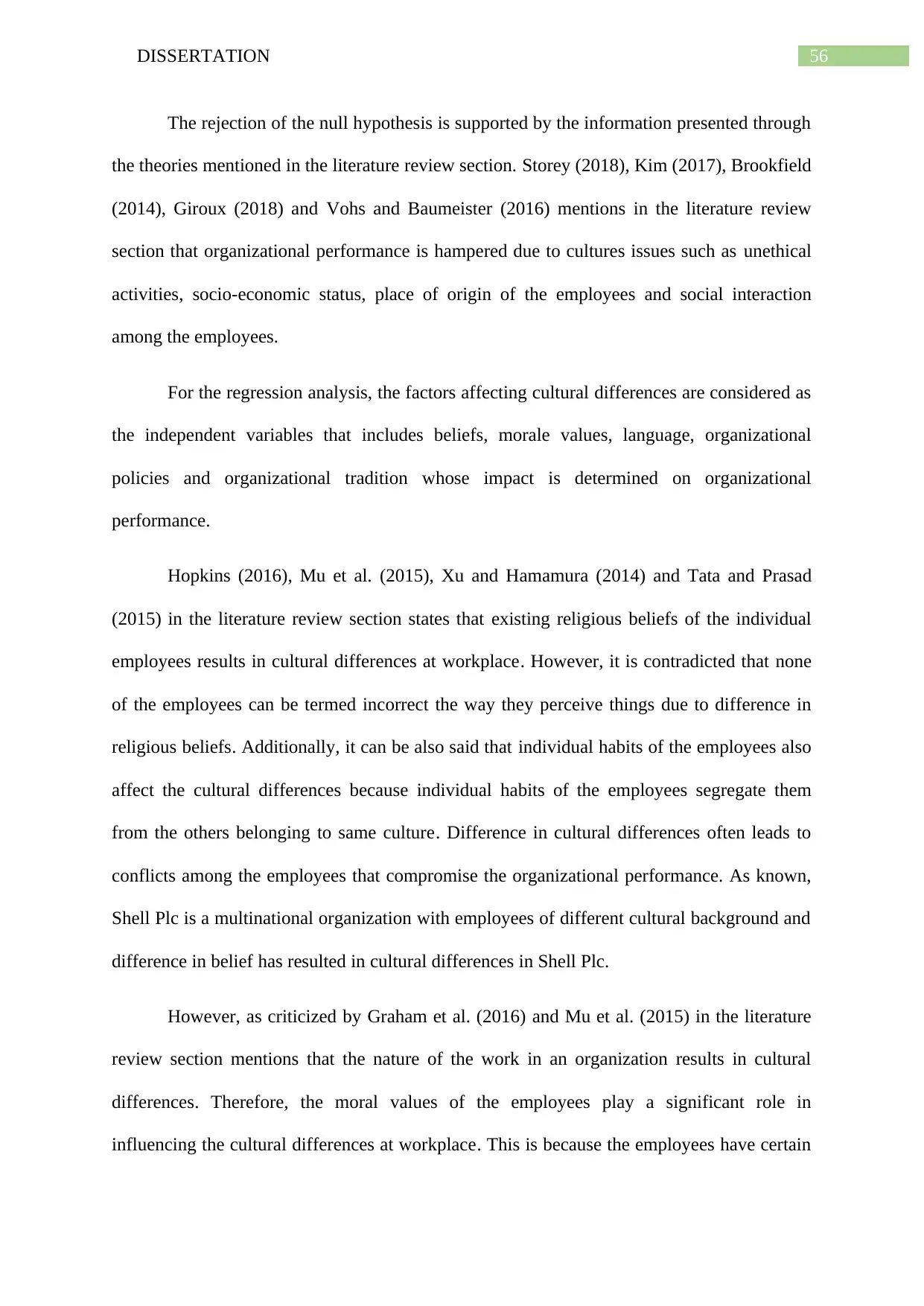
56DISSERTATION
The rejection of the null hypothesis is supported by the information presented through
the theories mentioned in the literature review section. Storey (2018), Kim (2017), Brookfield
(2014), Giroux (2018) and Vohs and Baumeister (2016) mentions in the literature review
section that organizational performance is hampered due to cultures issues such as unethical
activities, socio-economic status, place of origin of the employees and social interaction
among the employees.
For the regression analysis, the factors affecting cultural differences are considered as
the independent variables that includes beliefs, morale values, language, organizational
policies and organizational tradition whose impact is determined on organizational
performance.
Hopkins (2016), Mu et al. (2015), Xu and Hamamura (2014) and Tata and Prasad
(2015) in the literature review section states that existing religious beliefs of the individual
employees results in cultural differences at workplace. However, it is contradicted that none
of the employees can be termed incorrect the way they perceive things due to difference in
religious beliefs. Additionally, it can be also said that individual habits of the employees also
affect the cultural differences because individual habits of the employees segregate them
from the others belonging to same culture. Difference in cultural differences often leads to
conflicts among the employees that compromise the organizational performance. As known,
Shell Plc is a multinational organization with employees of different cultural background and
difference in belief has resulted in cultural differences in Shell Plc.
However, as criticized by Graham et al. (2016) and Mu et al. (2015) in the literature
review section mentions that the nature of the work in an organization results in cultural
differences. Therefore, the moral values of the employees play a significant role in
influencing the cultural differences at workplace. This is because the employees have certain
The rejection of the null hypothesis is supported by the information presented through
the theories mentioned in the literature review section. Storey (2018), Kim (2017), Brookfield
(2014), Giroux (2018) and Vohs and Baumeister (2016) mentions in the literature review
section that organizational performance is hampered due to cultures issues such as unethical
activities, socio-economic status, place of origin of the employees and social interaction
among the employees.
For the regression analysis, the factors affecting cultural differences are considered as
the independent variables that includes beliefs, morale values, language, organizational
policies and organizational tradition whose impact is determined on organizational
performance.
Hopkins (2016), Mu et al. (2015), Xu and Hamamura (2014) and Tata and Prasad
(2015) in the literature review section states that existing religious beliefs of the individual
employees results in cultural differences at workplace. However, it is contradicted that none
of the employees can be termed incorrect the way they perceive things due to difference in
religious beliefs. Additionally, it can be also said that individual habits of the employees also
affect the cultural differences because individual habits of the employees segregate them
from the others belonging to same culture. Difference in cultural differences often leads to
conflicts among the employees that compromise the organizational performance. As known,
Shell Plc is a multinational organization with employees of different cultural background and
difference in belief has resulted in cultural differences in Shell Plc.
However, as criticized by Graham et al. (2016) and Mu et al. (2015) in the literature
review section mentions that the nature of the work in an organization results in cultural
differences. Therefore, the moral values of the employees play a significant role in
influencing the cultural differences at workplace. This is because the employees have certain
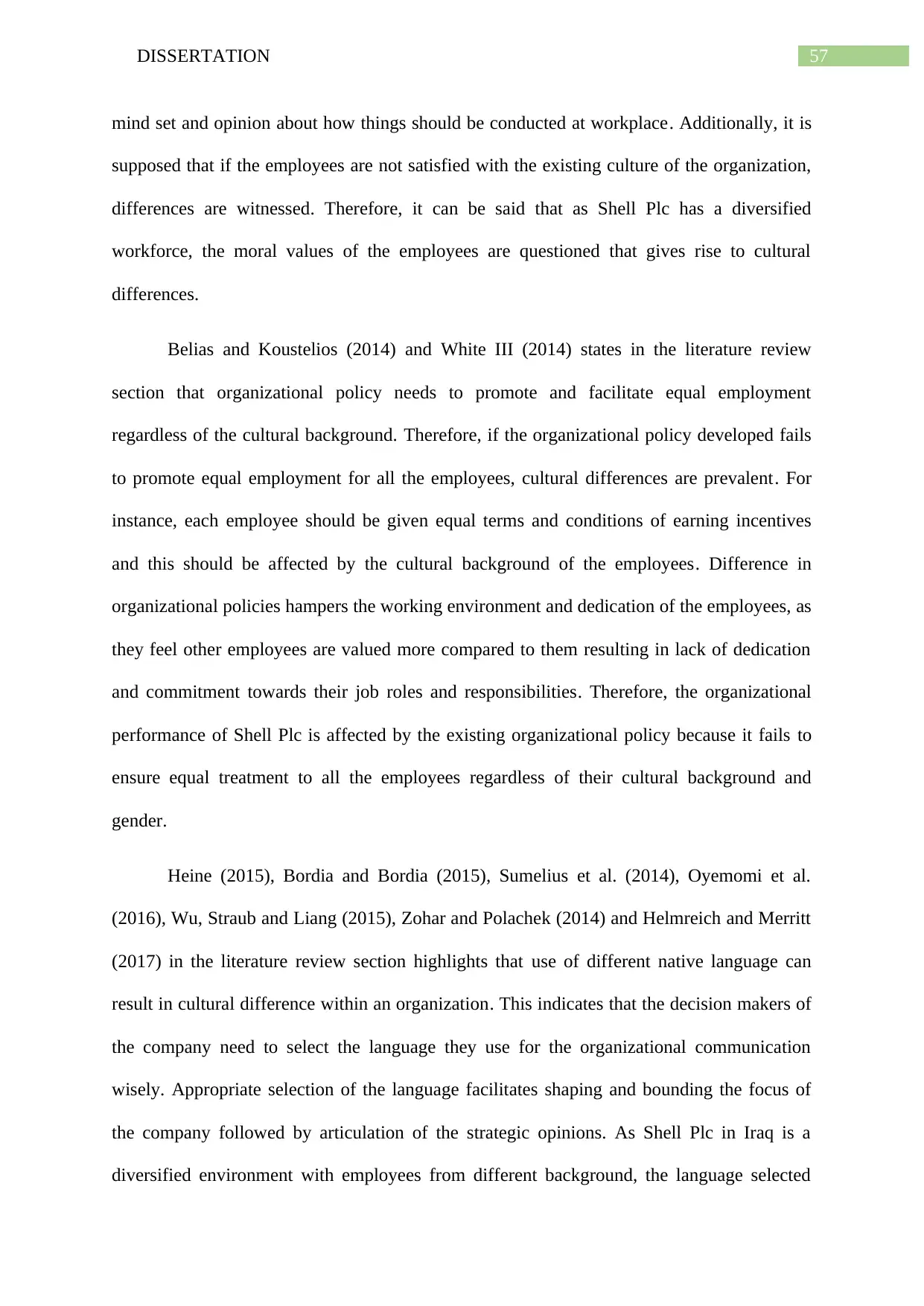
57DISSERTATION
mind set and opinion about how things should be conducted at workplace. Additionally, it is
supposed that if the employees are not satisfied with the existing culture of the organization,
differences are witnessed. Therefore, it can be said that as Shell Plc has a diversified
workforce, the moral values of the employees are questioned that gives rise to cultural
differences.
Belias and Koustelios (2014) and White III (2014) states in the literature review
section that organizational policy needs to promote and facilitate equal employment
regardless of the cultural background. Therefore, if the organizational policy developed fails
to promote equal employment for all the employees, cultural differences are prevalent. For
instance, each employee should be given equal terms and conditions of earning incentives
and this should be affected by the cultural background of the employees. Difference in
organizational policies hampers the working environment and dedication of the employees, as
they feel other employees are valued more compared to them resulting in lack of dedication
and commitment towards their job roles and responsibilities. Therefore, the organizational
performance of Shell Plc is affected by the existing organizational policy because it fails to
ensure equal treatment to all the employees regardless of their cultural background and
gender.
Heine (2015), Bordia and Bordia (2015), Sumelius et al. (2014), Oyemomi et al.
(2016), Wu, Straub and Liang (2015), Zohar and Polachek (2014) and Helmreich and Merritt
(2017) in the literature review section highlights that use of different native language can
result in cultural difference within an organization. This indicates that the decision makers of
the company need to select the language they use for the organizational communication
wisely. Appropriate selection of the language facilitates shaping and bounding the focus of
the company followed by articulation of the strategic opinions. As Shell Plc in Iraq is a
diversified environment with employees from different background, the language selected
mind set and opinion about how things should be conducted at workplace. Additionally, it is
supposed that if the employees are not satisfied with the existing culture of the organization,
differences are witnessed. Therefore, it can be said that as Shell Plc has a diversified
workforce, the moral values of the employees are questioned that gives rise to cultural
differences.
Belias and Koustelios (2014) and White III (2014) states in the literature review
section that organizational policy needs to promote and facilitate equal employment
regardless of the cultural background. Therefore, if the organizational policy developed fails
to promote equal employment for all the employees, cultural differences are prevalent. For
instance, each employee should be given equal terms and conditions of earning incentives
and this should be affected by the cultural background of the employees. Difference in
organizational policies hampers the working environment and dedication of the employees, as
they feel other employees are valued more compared to them resulting in lack of dedication
and commitment towards their job roles and responsibilities. Therefore, the organizational
performance of Shell Plc is affected by the existing organizational policy because it fails to
ensure equal treatment to all the employees regardless of their cultural background and
gender.
Heine (2015), Bordia and Bordia (2015), Sumelius et al. (2014), Oyemomi et al.
(2016), Wu, Straub and Liang (2015), Zohar and Polachek (2014) and Helmreich and Merritt
(2017) in the literature review section highlights that use of different native language can
result in cultural difference within an organization. This indicates that the decision makers of
the company need to select the language they use for the organizational communication
wisely. Appropriate selection of the language facilitates shaping and bounding the focus of
the company followed by articulation of the strategic opinions. As Shell Plc in Iraq is a
diversified environment with employees from different background, the language selected
Secure Best Marks with AI Grader
Need help grading? Try our AI Grader for instant feedback on your assignments.
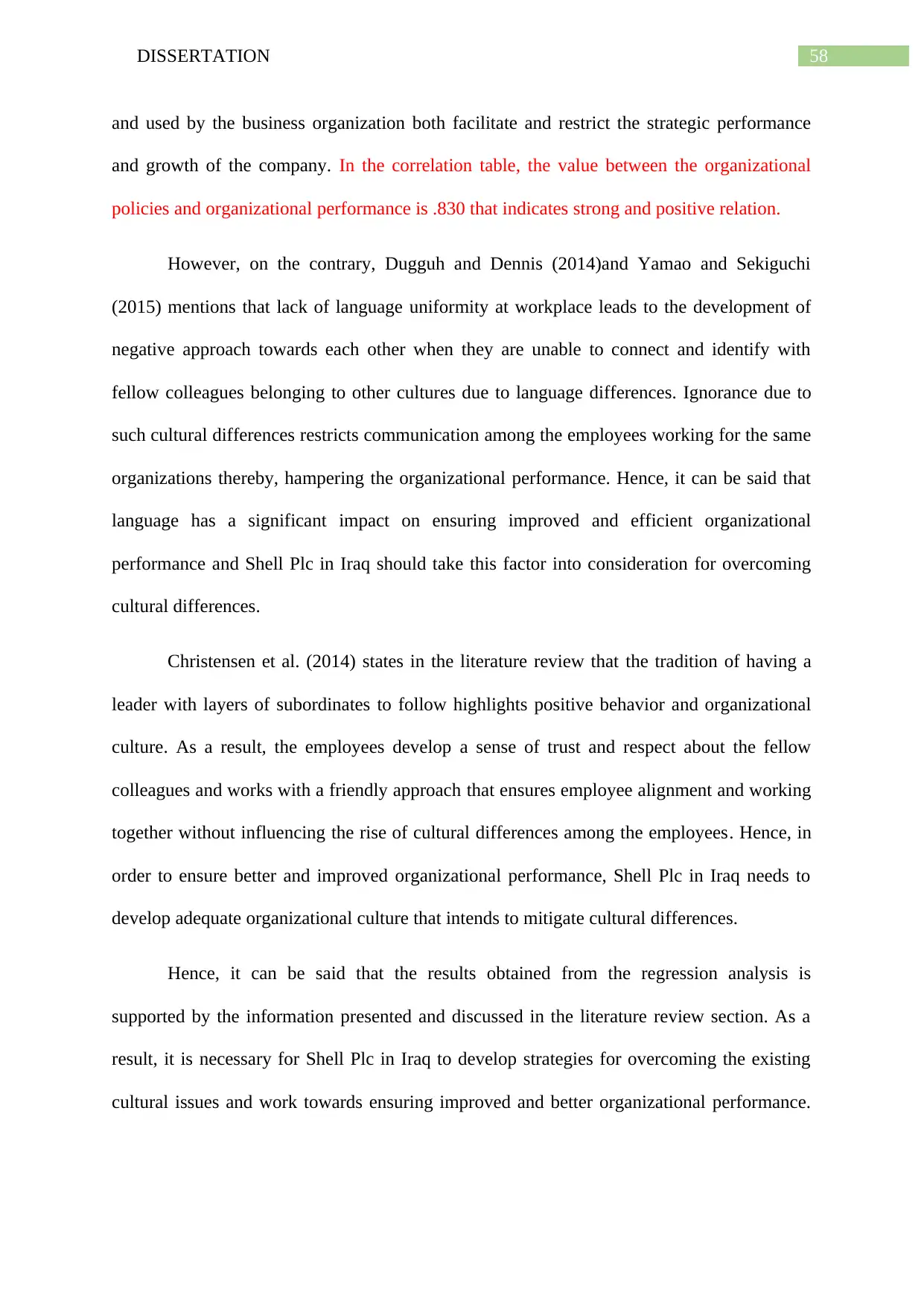
58DISSERTATION
and used by the business organization both facilitate and restrict the strategic performance
and growth of the company. In the correlation table, the value between the organizational
policies and organizational performance is .830 that indicates strong and positive relation.
However, on the contrary, Dugguh and Dennis (2014)and Yamao and Sekiguchi
(2015) mentions that lack of language uniformity at workplace leads to the development of
negative approach towards each other when they are unable to connect and identify with
fellow colleagues belonging to other cultures due to language differences. Ignorance due to
such cultural differences restricts communication among the employees working for the same
organizations thereby, hampering the organizational performance. Hence, it can be said that
language has a significant impact on ensuring improved and efficient organizational
performance and Shell Plc in Iraq should take this factor into consideration for overcoming
cultural differences.
Christensen et al. (2014) states in the literature review that the tradition of having a
leader with layers of subordinates to follow highlights positive behavior and organizational
culture. As a result, the employees develop a sense of trust and respect about the fellow
colleagues and works with a friendly approach that ensures employee alignment and working
together without influencing the rise of cultural differences among the employees. Hence, in
order to ensure better and improved organizational performance, Shell Plc in Iraq needs to
develop adequate organizational culture that intends to mitigate cultural differences.
Hence, it can be said that the results obtained from the regression analysis is
supported by the information presented and discussed in the literature review section. As a
result, it is necessary for Shell Plc in Iraq to develop strategies for overcoming the existing
cultural issues and work towards ensuring improved and better organizational performance.
and used by the business organization both facilitate and restrict the strategic performance
and growth of the company. In the correlation table, the value between the organizational
policies and organizational performance is .830 that indicates strong and positive relation.
However, on the contrary, Dugguh and Dennis (2014)and Yamao and Sekiguchi
(2015) mentions that lack of language uniformity at workplace leads to the development of
negative approach towards each other when they are unable to connect and identify with
fellow colleagues belonging to other cultures due to language differences. Ignorance due to
such cultural differences restricts communication among the employees working for the same
organizations thereby, hampering the organizational performance. Hence, it can be said that
language has a significant impact on ensuring improved and efficient organizational
performance and Shell Plc in Iraq should take this factor into consideration for overcoming
cultural differences.
Christensen et al. (2014) states in the literature review that the tradition of having a
leader with layers of subordinates to follow highlights positive behavior and organizational
culture. As a result, the employees develop a sense of trust and respect about the fellow
colleagues and works with a friendly approach that ensures employee alignment and working
together without influencing the rise of cultural differences among the employees. Hence, in
order to ensure better and improved organizational performance, Shell Plc in Iraq needs to
develop adequate organizational culture that intends to mitigate cultural differences.
Hence, it can be said that the results obtained from the regression analysis is
supported by the information presented and discussed in the literature review section. As a
result, it is necessary for Shell Plc in Iraq to develop strategies for overcoming the existing
cultural issues and work towards ensuring improved and better organizational performance.
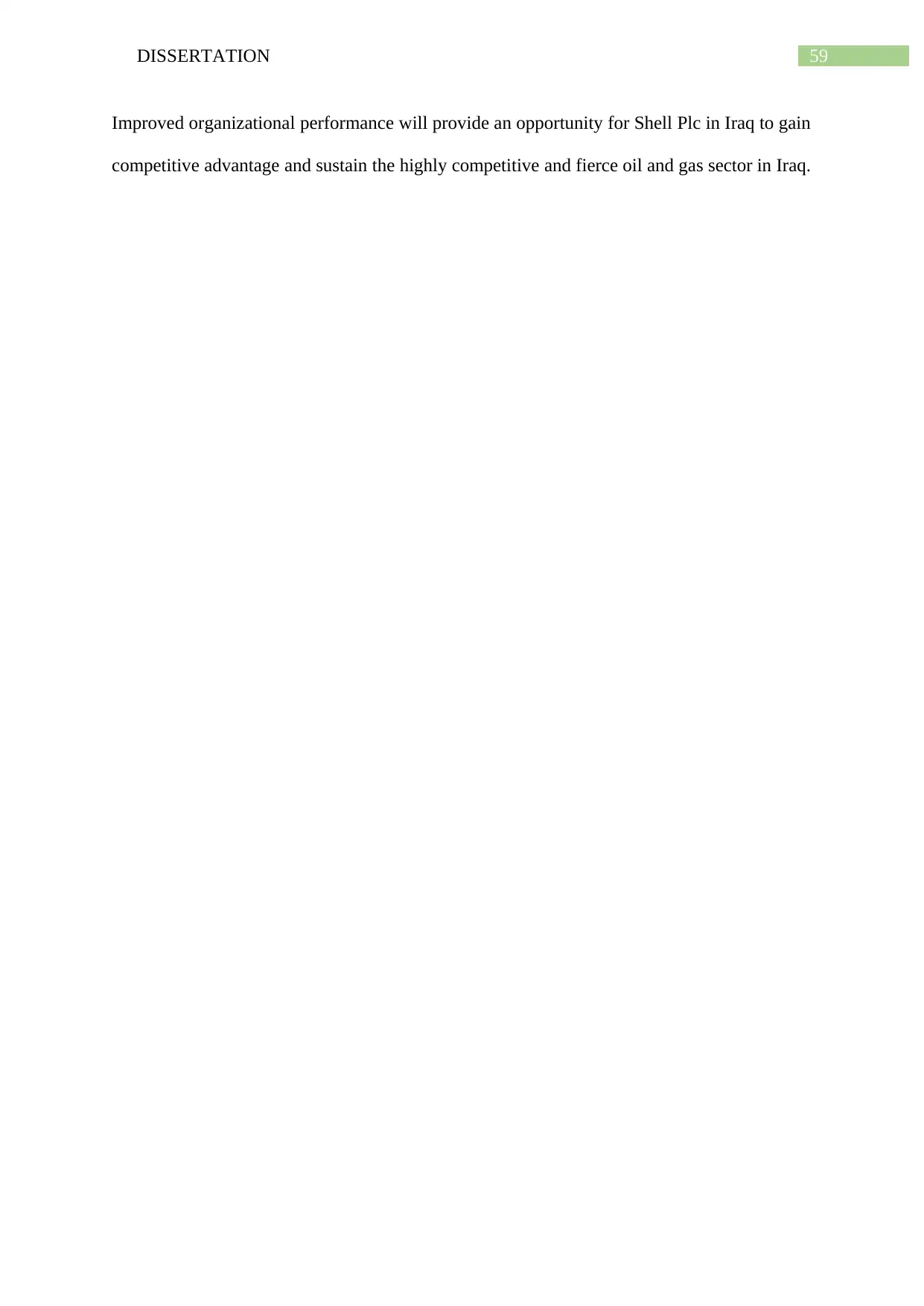
59DISSERTATION
Improved organizational performance will provide an opportunity for Shell Plc in Iraq to gain
competitive advantage and sustain the highly competitive and fierce oil and gas sector in Iraq.
Improved organizational performance will provide an opportunity for Shell Plc in Iraq to gain
competitive advantage and sustain the highly competitive and fierce oil and gas sector in Iraq.
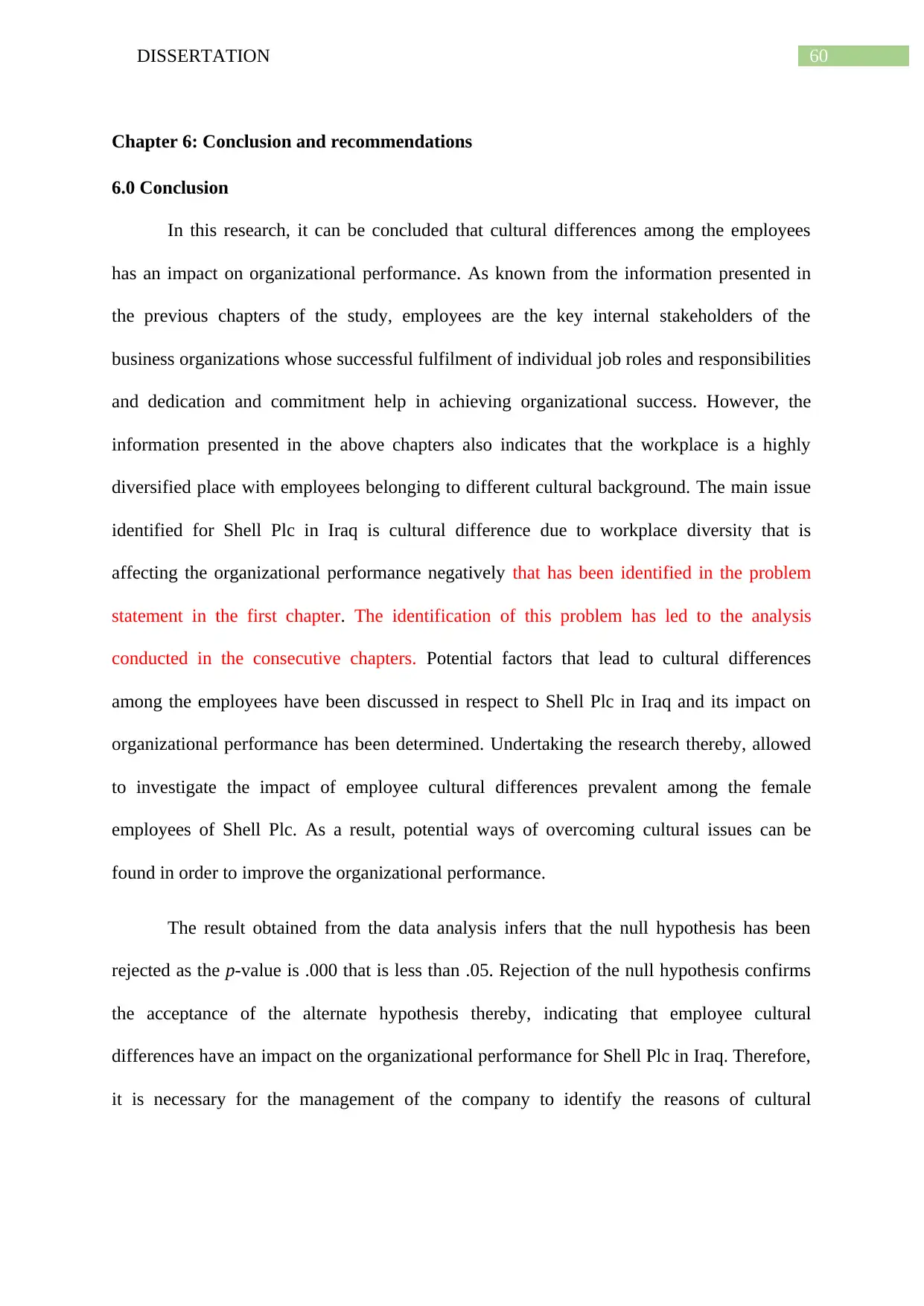
60DISSERTATION
Chapter 6: Conclusion and recommendations
6.0 Conclusion
In this research, it can be concluded that cultural differences among the employees
has an impact on organizational performance. As known from the information presented in
the previous chapters of the study, employees are the key internal stakeholders of the
business organizations whose successful fulfilment of individual job roles and responsibilities
and dedication and commitment help in achieving organizational success. However, the
information presented in the above chapters also indicates that the workplace is a highly
diversified place with employees belonging to different cultural background. The main issue
identified for Shell Plc in Iraq is cultural difference due to workplace diversity that is
affecting the organizational performance negatively that has been identified in the problem
statement in the first chapter. The identification of this problem has led to the analysis
conducted in the consecutive chapters. Potential factors that lead to cultural differences
among the employees have been discussed in respect to Shell Plc in Iraq and its impact on
organizational performance has been determined. Undertaking the research thereby, allowed
to investigate the impact of employee cultural differences prevalent among the female
employees of Shell Plc. As a result, potential ways of overcoming cultural issues can be
found in order to improve the organizational performance.
The result obtained from the data analysis infers that the null hypothesis has been
rejected as the p-value is .000 that is less than .05. Rejection of the null hypothesis confirms
the acceptance of the alternate hypothesis thereby, indicating that employee cultural
differences have an impact on the organizational performance for Shell Plc in Iraq. Therefore,
it is necessary for the management of the company to identify the reasons of cultural
Chapter 6: Conclusion and recommendations
6.0 Conclusion
In this research, it can be concluded that cultural differences among the employees
has an impact on organizational performance. As known from the information presented in
the previous chapters of the study, employees are the key internal stakeholders of the
business organizations whose successful fulfilment of individual job roles and responsibilities
and dedication and commitment help in achieving organizational success. However, the
information presented in the above chapters also indicates that the workplace is a highly
diversified place with employees belonging to different cultural background. The main issue
identified for Shell Plc in Iraq is cultural difference due to workplace diversity that is
affecting the organizational performance negatively that has been identified in the problem
statement in the first chapter. The identification of this problem has led to the analysis
conducted in the consecutive chapters. Potential factors that lead to cultural differences
among the employees have been discussed in respect to Shell Plc in Iraq and its impact on
organizational performance has been determined. Undertaking the research thereby, allowed
to investigate the impact of employee cultural differences prevalent among the female
employees of Shell Plc. As a result, potential ways of overcoming cultural issues can be
found in order to improve the organizational performance.
The result obtained from the data analysis infers that the null hypothesis has been
rejected as the p-value is .000 that is less than .05. Rejection of the null hypothesis confirms
the acceptance of the alternate hypothesis thereby, indicating that employee cultural
differences have an impact on the organizational performance for Shell Plc in Iraq. Therefore,
it is necessary for the management of the company to identify the reasons of cultural
Paraphrase This Document
Need a fresh take? Get an instant paraphrase of this document with our AI Paraphraser
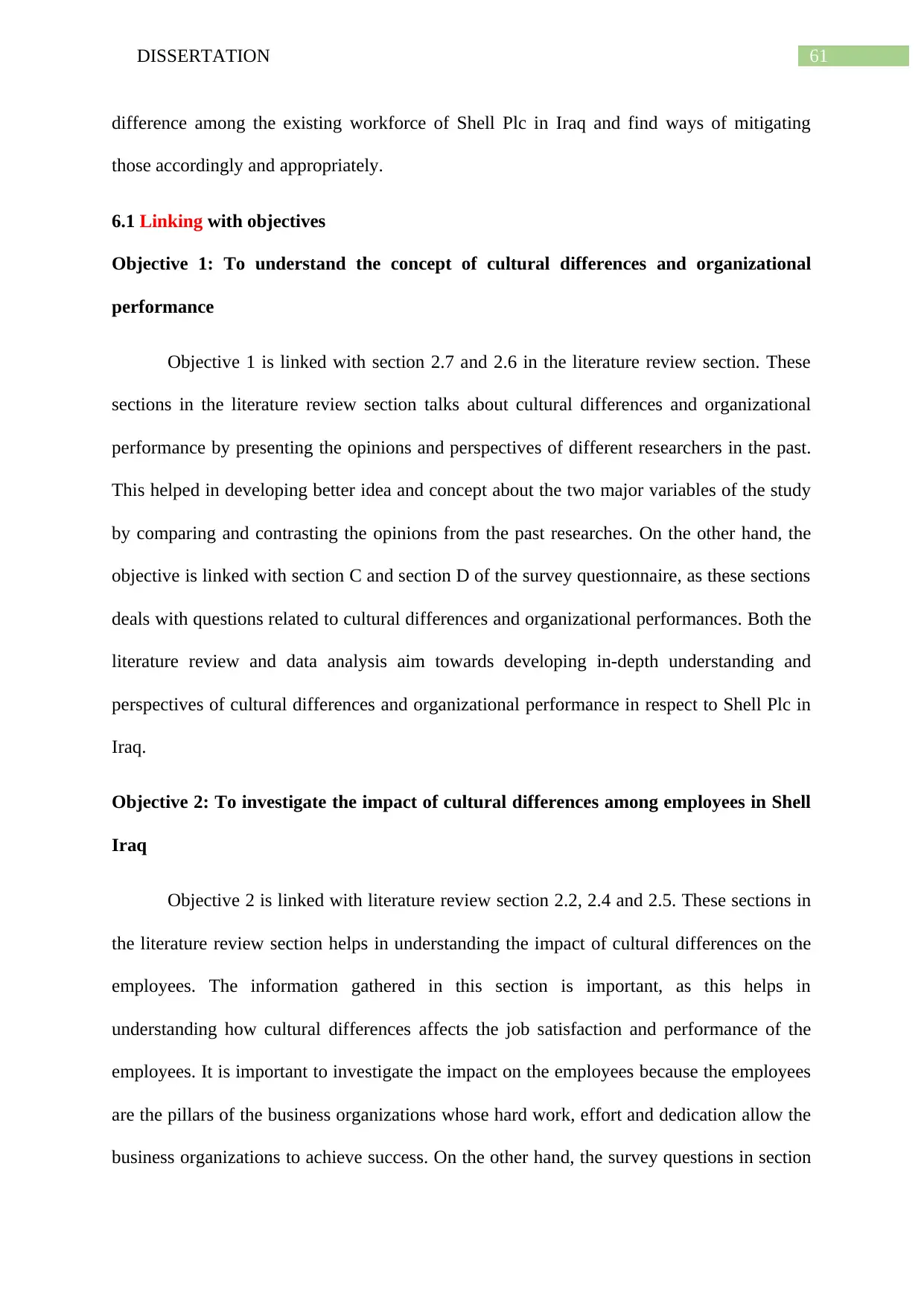
61DISSERTATION
difference among the existing workforce of Shell Plc in Iraq and find ways of mitigating
those accordingly and appropriately.
6.1 Linking with objectives
Objective 1: To understand the concept of cultural differences and organizational
performance
Objective 1 is linked with section 2.7 and 2.6 in the literature review section. These
sections in the literature review section talks about cultural differences and organizational
performance by presenting the opinions and perspectives of different researchers in the past.
This helped in developing better idea and concept about the two major variables of the study
by comparing and contrasting the opinions from the past researches. On the other hand, the
objective is linked with section C and section D of the survey questionnaire, as these sections
deals with questions related to cultural differences and organizational performances. Both the
literature review and data analysis aim towards developing in-depth understanding and
perspectives of cultural differences and organizational performance in respect to Shell Plc in
Iraq.
Objective 2: To investigate the impact of cultural differences among employees in Shell
Iraq
Objective 2 is linked with literature review section 2.2, 2.4 and 2.5. These sections in
the literature review section helps in understanding the impact of cultural differences on the
employees. The information gathered in this section is important, as this helps in
understanding how cultural differences affects the job satisfaction and performance of the
employees. It is important to investigate the impact on the employees because the employees
are the pillars of the business organizations whose hard work, effort and dedication allow the
business organizations to achieve success. On the other hand, the survey questions in section
difference among the existing workforce of Shell Plc in Iraq and find ways of mitigating
those accordingly and appropriately.
6.1 Linking with objectives
Objective 1: To understand the concept of cultural differences and organizational
performance
Objective 1 is linked with section 2.7 and 2.6 in the literature review section. These
sections in the literature review section talks about cultural differences and organizational
performance by presenting the opinions and perspectives of different researchers in the past.
This helped in developing better idea and concept about the two major variables of the study
by comparing and contrasting the opinions from the past researches. On the other hand, the
objective is linked with section C and section D of the survey questionnaire, as these sections
deals with questions related to cultural differences and organizational performances. Both the
literature review and data analysis aim towards developing in-depth understanding and
perspectives of cultural differences and organizational performance in respect to Shell Plc in
Iraq.
Objective 2: To investigate the impact of cultural differences among employees in Shell
Iraq
Objective 2 is linked with literature review section 2.2, 2.4 and 2.5. These sections in
the literature review section helps in understanding the impact of cultural differences on the
employees. The information gathered in this section is important, as this helps in
understanding how cultural differences affects the job satisfaction and performance of the
employees. It is important to investigate the impact on the employees because the employees
are the pillars of the business organizations whose hard work, effort and dedication allow the
business organizations to achieve success. On the other hand, the survey questions in section

62DISSERTATION
D is developed with the aim of investigating the impact of cultural differences on the
employees of Shell Plc in Iraq. The questions formulated in this section targets the employees
of Shell Plc in Iraq so that the impact of cultural differences on organizational performance
can be investigated.
Objective 3: To analyze critically the cultural issues among the employees and its
impact on organizational performance at Shell Iraq
Objective 3 is linked with literature review section 2.3. This section sheds light on the
different factors that affect cultural differences at workplace. From the information provided
in this section, it can be inferred that the workplace is a diversified place with employees
belonging to different cultural background. The difference in beliefs, attitudes, behaviors and
habits among the employees results in cultural differences that tend to affect the
organizational performance. Difference in the opinions results in conflicts that hampers the
relationship among the employees due to which the employees focus on individuality. On the
other hand, survey questions developed in section B aim towards investigating the cultural
differences among the employees of Shell Plc in Iraq that is predicted to have an impact on
the performance of the organization.
Objective 4: To provide suitable recommendations for mitigating the employee cultural
differences in Shell Iraq
Objective 4 is linked with literature review section 2.4, 2.5 and 2.7. These sections
highlights the how different factors in terms of culture affects the employees that in turn
affects the performance of the organization. The section also talks bout the different cultural
theories that justifies the emergence and existence of cultural difference among the
employees at workplace and how it affects the organizational performance negatively. On the
other hand, the entire survey questionnaire is developed with the aim of identifying the
D is developed with the aim of investigating the impact of cultural differences on the
employees of Shell Plc in Iraq. The questions formulated in this section targets the employees
of Shell Plc in Iraq so that the impact of cultural differences on organizational performance
can be investigated.
Objective 3: To analyze critically the cultural issues among the employees and its
impact on organizational performance at Shell Iraq
Objective 3 is linked with literature review section 2.3. This section sheds light on the
different factors that affect cultural differences at workplace. From the information provided
in this section, it can be inferred that the workplace is a diversified place with employees
belonging to different cultural background. The difference in beliefs, attitudes, behaviors and
habits among the employees results in cultural differences that tend to affect the
organizational performance. Difference in the opinions results in conflicts that hampers the
relationship among the employees due to which the employees focus on individuality. On the
other hand, survey questions developed in section B aim towards investigating the cultural
differences among the employees of Shell Plc in Iraq that is predicted to have an impact on
the performance of the organization.
Objective 4: To provide suitable recommendations for mitigating the employee cultural
differences in Shell Iraq
Objective 4 is linked with literature review section 2.4, 2.5 and 2.7. These sections
highlights the how different factors in terms of culture affects the employees that in turn
affects the performance of the organization. The section also talks bout the different cultural
theories that justifies the emergence and existence of cultural difference among the
employees at workplace and how it affects the organizational performance negatively. On the
other hand, the entire survey questionnaire is developed with the aim of identifying the
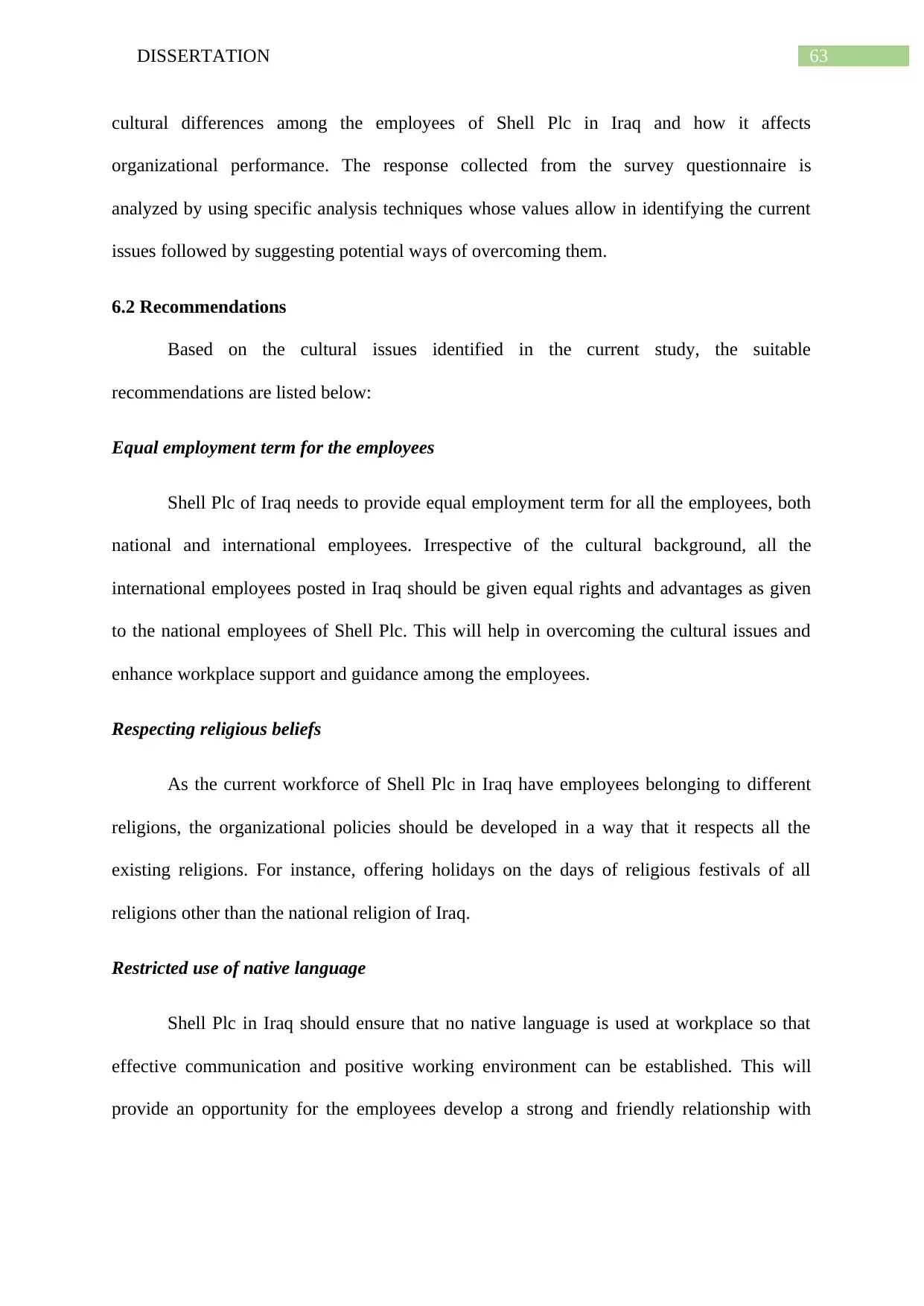
63DISSERTATION
cultural differences among the employees of Shell Plc in Iraq and how it affects
organizational performance. The response collected from the survey questionnaire is
analyzed by using specific analysis techniques whose values allow in identifying the current
issues followed by suggesting potential ways of overcoming them.
6.2 Recommendations
Based on the cultural issues identified in the current study, the suitable
recommendations are listed below:
Equal employment term for the employees
Shell Plc of Iraq needs to provide equal employment term for all the employees, both
national and international employees. Irrespective of the cultural background, all the
international employees posted in Iraq should be given equal rights and advantages as given
to the national employees of Shell Plc. This will help in overcoming the cultural issues and
enhance workplace support and guidance among the employees.
Respecting religious beliefs
As the current workforce of Shell Plc in Iraq have employees belonging to different
religions, the organizational policies should be developed in a way that it respects all the
existing religions. For instance, offering holidays on the days of religious festivals of all
religions other than the national religion of Iraq.
Restricted use of native language
Shell Plc in Iraq should ensure that no native language is used at workplace so that
effective communication and positive working environment can be established. This will
provide an opportunity for the employees develop a strong and friendly relationship with
cultural differences among the employees of Shell Plc in Iraq and how it affects
organizational performance. The response collected from the survey questionnaire is
analyzed by using specific analysis techniques whose values allow in identifying the current
issues followed by suggesting potential ways of overcoming them.
6.2 Recommendations
Based on the cultural issues identified in the current study, the suitable
recommendations are listed below:
Equal employment term for the employees
Shell Plc of Iraq needs to provide equal employment term for all the employees, both
national and international employees. Irrespective of the cultural background, all the
international employees posted in Iraq should be given equal rights and advantages as given
to the national employees of Shell Plc. This will help in overcoming the cultural issues and
enhance workplace support and guidance among the employees.
Respecting religious beliefs
As the current workforce of Shell Plc in Iraq have employees belonging to different
religions, the organizational policies should be developed in a way that it respects all the
existing religions. For instance, offering holidays on the days of religious festivals of all
religions other than the national religion of Iraq.
Restricted use of native language
Shell Plc in Iraq should ensure that no native language is used at workplace so that
effective communication and positive working environment can be established. This will
provide an opportunity for the employees develop a strong and friendly relationship with
Secure Best Marks with AI Grader
Need help grading? Try our AI Grader for instant feedback on your assignments.
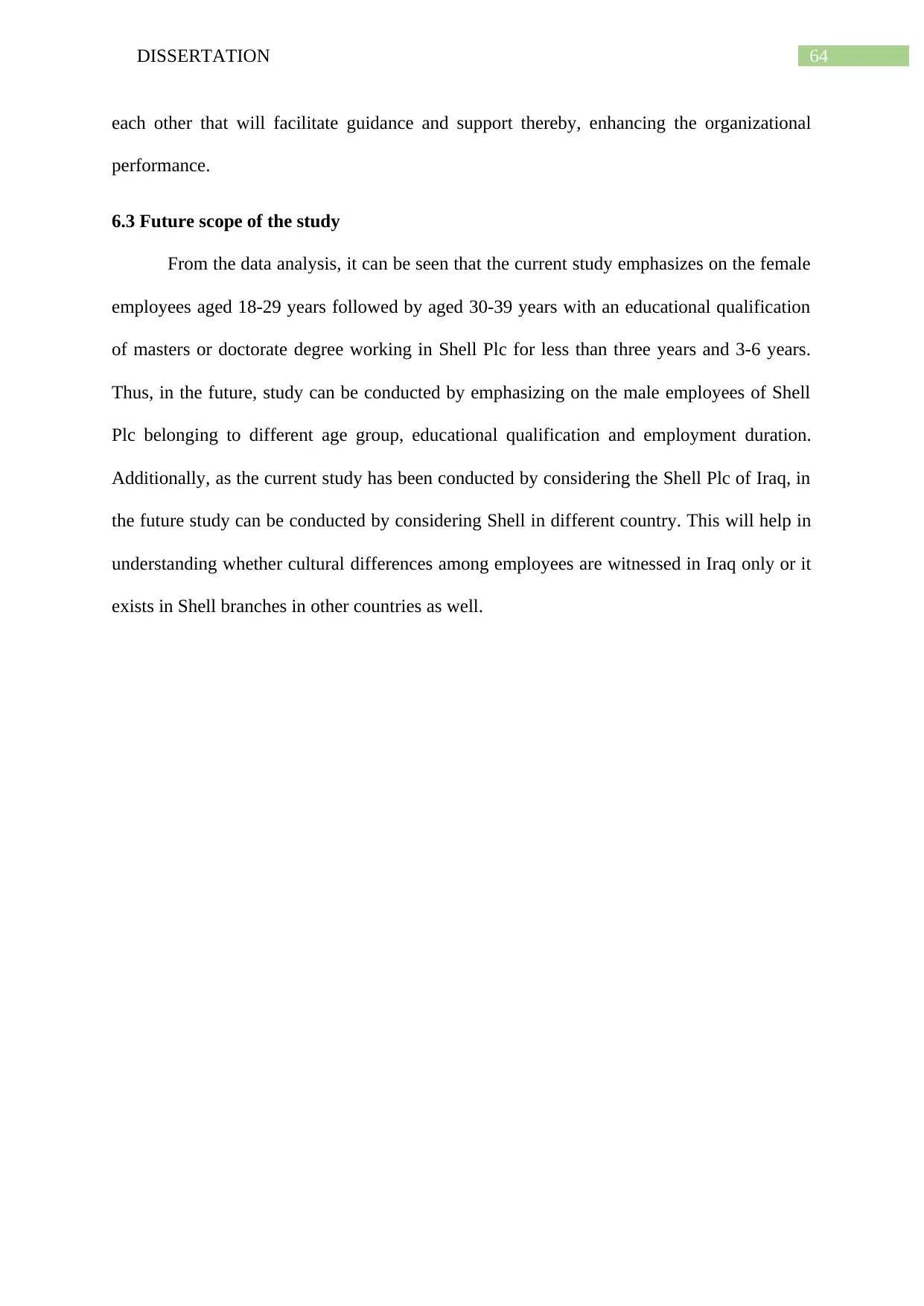
64DISSERTATION
each other that will facilitate guidance and support thereby, enhancing the organizational
performance.
6.3 Future scope of the study
From the data analysis, it can be seen that the current study emphasizes on the female
employees aged 18-29 years followed by aged 30-39 years with an educational qualification
of masters or doctorate degree working in Shell Plc for less than three years and 3-6 years.
Thus, in the future, study can be conducted by emphasizing on the male employees of Shell
Plc belonging to different age group, educational qualification and employment duration.
Additionally, as the current study has been conducted by considering the Shell Plc of Iraq, in
the future study can be conducted by considering Shell in different country. This will help in
understanding whether cultural differences among employees are witnessed in Iraq only or it
exists in Shell branches in other countries as well.
each other that will facilitate guidance and support thereby, enhancing the organizational
performance.
6.3 Future scope of the study
From the data analysis, it can be seen that the current study emphasizes on the female
employees aged 18-29 years followed by aged 30-39 years with an educational qualification
of masters or doctorate degree working in Shell Plc for less than three years and 3-6 years.
Thus, in the future, study can be conducted by emphasizing on the male employees of Shell
Plc belonging to different age group, educational qualification and employment duration.
Additionally, as the current study has been conducted by considering the Shell Plc of Iraq, in
the future study can be conducted by considering Shell in different country. This will help in
understanding whether cultural differences among employees are witnessed in Iraq only or it
exists in Shell branches in other countries as well.

65DISSERTATION
References
Acar, A.Z. and Acar, P., 2014. Organizational culture types and their effects on
organizational performance in Turkish hospitals. EMAJ: Emerging Markets Journal, 3(3),
pp.18-31.
Ahammad, M.F., Tarba, S.Y., Liu, Y. and Glaister, K.W., 2016. Knowledge transfer and
cross-border acquisition performance: The impact of cultural distance and employee
retention. International business review, 25(1), pp.66-75.
Alas, R. and Mousa, M., 2016. Organizational culture and workplace
spirituality. International journal of emerging research in management and technology, 5(3),
pp.285-314.
Arifin, H.M., 2015. The Influence of Competence, Motivation, and Organisational Culture to
High School Teacher Job Satisfaction and Performance. International Education
Studies, 8(1), pp.38-45.
Battiste, M., 2016. Research Ethics for Chapter Protecting Indigenous Knowledge and
Heritage. Ethical futures in qualitative research: Decolonizing the politics of knowledge, 111.
Bauer, G.R., 2014. Incorporating intersectionality theory into population health research
methodology: Challenges and the potential to advance health equity. Social science &
medicine, 110, pp.10-17.
Belias, D. and Koustelios, A., 2014. Organizational culture and job satisfaction: A
review. International Review of Management and Marketing, 4(2), pp.132-149.
Beugelsdijk, S., Maseland, R. and Van Hoorn, A., 2015. Are Scores on Hofstede's
Dimensions of National Culture Stable over Time? A Cohort Analysis. Global Strategy
Journal, 5(3), pp.223-240.
References
Acar, A.Z. and Acar, P., 2014. Organizational culture types and their effects on
organizational performance in Turkish hospitals. EMAJ: Emerging Markets Journal, 3(3),
pp.18-31.
Ahammad, M.F., Tarba, S.Y., Liu, Y. and Glaister, K.W., 2016. Knowledge transfer and
cross-border acquisition performance: The impact of cultural distance and employee
retention. International business review, 25(1), pp.66-75.
Alas, R. and Mousa, M., 2016. Organizational culture and workplace
spirituality. International journal of emerging research in management and technology, 5(3),
pp.285-314.
Arifin, H.M., 2015. The Influence of Competence, Motivation, and Organisational Culture to
High School Teacher Job Satisfaction and Performance. International Education
Studies, 8(1), pp.38-45.
Battiste, M., 2016. Research Ethics for Chapter Protecting Indigenous Knowledge and
Heritage. Ethical futures in qualitative research: Decolonizing the politics of knowledge, 111.
Bauer, G.R., 2014. Incorporating intersectionality theory into population health research
methodology: Challenges and the potential to advance health equity. Social science &
medicine, 110, pp.10-17.
Belias, D. and Koustelios, A., 2014. Organizational culture and job satisfaction: A
review. International Review of Management and Marketing, 4(2), pp.132-149.
Beugelsdijk, S., Maseland, R. and Van Hoorn, A., 2015. Are Scores on Hofstede's
Dimensions of National Culture Stable over Time? A Cohort Analysis. Global Strategy
Journal, 5(3), pp.223-240.
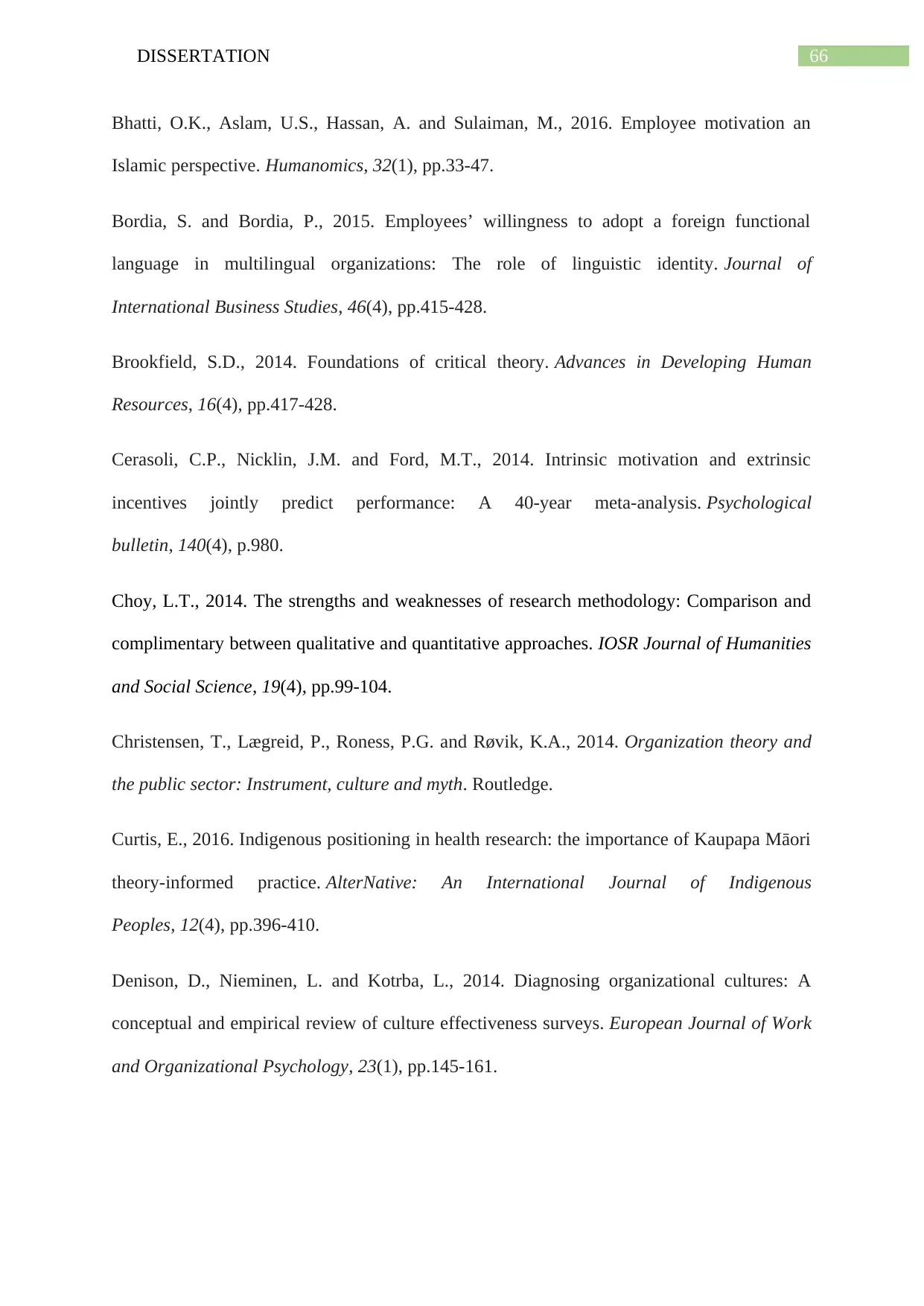
66DISSERTATION
Bhatti, O.K., Aslam, U.S., Hassan, A. and Sulaiman, M., 2016. Employee motivation an
Islamic perspective. Humanomics, 32(1), pp.33-47.
Bordia, S. and Bordia, P., 2015. Employees’ willingness to adopt a foreign functional
language in multilingual organizations: The role of linguistic identity. Journal of
International Business Studies, 46(4), pp.415-428.
Brookfield, S.D., 2014. Foundations of critical theory. Advances in Developing Human
Resources, 16(4), pp.417-428.
Cerasoli, C.P., Nicklin, J.M. and Ford, M.T., 2014. Intrinsic motivation and extrinsic
incentives jointly predict performance: A 40-year meta-analysis. Psychological
bulletin, 140(4), p.980.
Choy, L.T., 2014. The strengths and weaknesses of research methodology: Comparison and
complimentary between qualitative and quantitative approaches. IOSR Journal of Humanities
and Social Science, 19(4), pp.99-104.
Christensen, T., Lægreid, P., Roness, P.G. and Røvik, K.A., 2014. Organization theory and
the public sector: Instrument, culture and myth. Routledge.
Curtis, E., 2016. Indigenous positioning in health research: the importance of Kaupapa Māori
theory-informed practice. AlterNative: An International Journal of Indigenous
Peoples, 12(4), pp.396-410.
Denison, D., Nieminen, L. and Kotrba, L., 2014. Diagnosing organizational cultures: A
conceptual and empirical review of culture effectiveness surveys. European Journal of Work
and Organizational Psychology, 23(1), pp.145-161.
Bhatti, O.K., Aslam, U.S., Hassan, A. and Sulaiman, M., 2016. Employee motivation an
Islamic perspective. Humanomics, 32(1), pp.33-47.
Bordia, S. and Bordia, P., 2015. Employees’ willingness to adopt a foreign functional
language in multilingual organizations: The role of linguistic identity. Journal of
International Business Studies, 46(4), pp.415-428.
Brookfield, S.D., 2014. Foundations of critical theory. Advances in Developing Human
Resources, 16(4), pp.417-428.
Cerasoli, C.P., Nicklin, J.M. and Ford, M.T., 2014. Intrinsic motivation and extrinsic
incentives jointly predict performance: A 40-year meta-analysis. Psychological
bulletin, 140(4), p.980.
Choy, L.T., 2014. The strengths and weaknesses of research methodology: Comparison and
complimentary between qualitative and quantitative approaches. IOSR Journal of Humanities
and Social Science, 19(4), pp.99-104.
Christensen, T., Lægreid, P., Roness, P.G. and Røvik, K.A., 2014. Organization theory and
the public sector: Instrument, culture and myth. Routledge.
Curtis, E., 2016. Indigenous positioning in health research: the importance of Kaupapa Māori
theory-informed practice. AlterNative: An International Journal of Indigenous
Peoples, 12(4), pp.396-410.
Denison, D., Nieminen, L. and Kotrba, L., 2014. Diagnosing organizational cultures: A
conceptual and empirical review of culture effectiveness surveys. European Journal of Work
and Organizational Psychology, 23(1), pp.145-161.
Paraphrase This Document
Need a fresh take? Get an instant paraphrase of this document with our AI Paraphraser
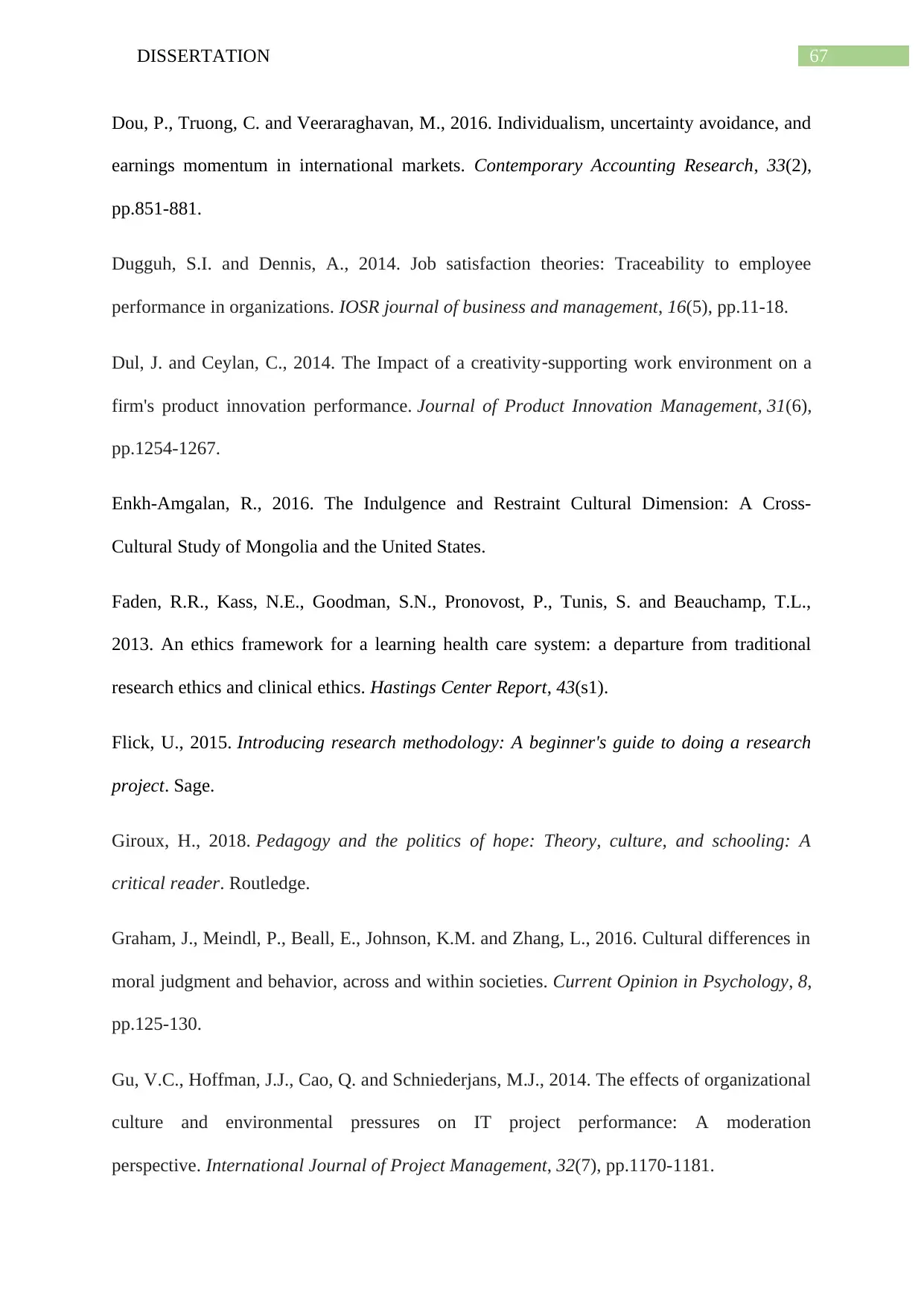
67DISSERTATION
Dou, P., Truong, C. and Veeraraghavan, M., 2016. Individualism, uncertainty avoidance, and
earnings momentum in international markets. Contemporary Accounting Research, 33(2),
pp.851-881.
Dugguh, S.I. and Dennis, A., 2014. Job satisfaction theories: Traceability to employee
performance in organizations. IOSR journal of business and management, 16(5), pp.11-18.
Dul, J. and Ceylan, C., 2014. The Impact of a creativity‐supporting work environment on a
firm's product innovation performance. Journal of Product Innovation Management, 31(6),
pp.1254-1267.
Enkh-Amgalan, R., 2016. The Indulgence and Restraint Cultural Dimension: A Cross-
Cultural Study of Mongolia and the United States.
Faden, R.R., Kass, N.E., Goodman, S.N., Pronovost, P., Tunis, S. and Beauchamp, T.L.,
2013. An ethics framework for a learning health care system: a departure from traditional
research ethics and clinical ethics. Hastings Center Report, 43(s1).
Flick, U., 2015. Introducing research methodology: A beginner's guide to doing a research
project. Sage.
Giroux, H., 2018. Pedagogy and the politics of hope: Theory, culture, and schooling: A
critical reader. Routledge.
Graham, J., Meindl, P., Beall, E., Johnson, K.M. and Zhang, L., 2016. Cultural differences in
moral judgment and behavior, across and within societies. Current Opinion in Psychology, 8,
pp.125-130.
Gu, V.C., Hoffman, J.J., Cao, Q. and Schniederjans, M.J., 2014. The effects of organizational
culture and environmental pressures on IT project performance: A moderation
perspective. International Journal of Project Management, 32(7), pp.1170-1181.
Dou, P., Truong, C. and Veeraraghavan, M., 2016. Individualism, uncertainty avoidance, and
earnings momentum in international markets. Contemporary Accounting Research, 33(2),
pp.851-881.
Dugguh, S.I. and Dennis, A., 2014. Job satisfaction theories: Traceability to employee
performance in organizations. IOSR journal of business and management, 16(5), pp.11-18.
Dul, J. and Ceylan, C., 2014. The Impact of a creativity‐supporting work environment on a
firm's product innovation performance. Journal of Product Innovation Management, 31(6),
pp.1254-1267.
Enkh-Amgalan, R., 2016. The Indulgence and Restraint Cultural Dimension: A Cross-
Cultural Study of Mongolia and the United States.
Faden, R.R., Kass, N.E., Goodman, S.N., Pronovost, P., Tunis, S. and Beauchamp, T.L.,
2013. An ethics framework for a learning health care system: a departure from traditional
research ethics and clinical ethics. Hastings Center Report, 43(s1).
Flick, U., 2015. Introducing research methodology: A beginner's guide to doing a research
project. Sage.
Giroux, H., 2018. Pedagogy and the politics of hope: Theory, culture, and schooling: A
critical reader. Routledge.
Graham, J., Meindl, P., Beall, E., Johnson, K.M. and Zhang, L., 2016. Cultural differences in
moral judgment and behavior, across and within societies. Current Opinion in Psychology, 8,
pp.125-130.
Gu, V.C., Hoffman, J.J., Cao, Q. and Schniederjans, M.J., 2014. The effects of organizational
culture and environmental pressures on IT project performance: A moderation
perspective. International Journal of Project Management, 32(7), pp.1170-1181.
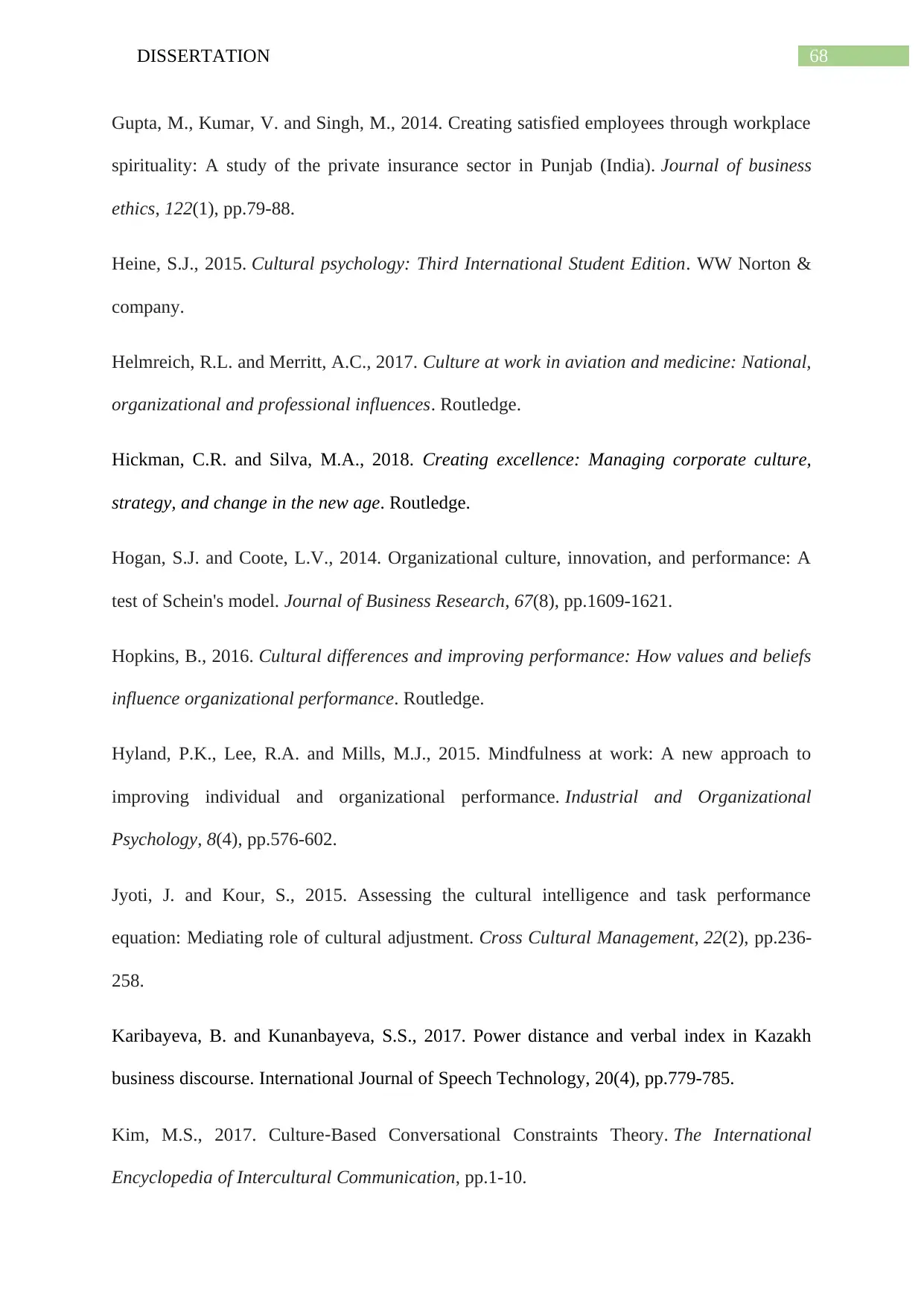
68DISSERTATION
Gupta, M., Kumar, V. and Singh, M., 2014. Creating satisfied employees through workplace
spirituality: A study of the private insurance sector in Punjab (India). Journal of business
ethics, 122(1), pp.79-88.
Heine, S.J., 2015. Cultural psychology: Third International Student Edition. WW Norton &
company.
Helmreich, R.L. and Merritt, A.C., 2017. Culture at work in aviation and medicine: National,
organizational and professional influences. Routledge.
Hickman, C.R. and Silva, M.A., 2018. Creating excellence: Managing corporate culture,
strategy, and change in the new age. Routledge.
Hogan, S.J. and Coote, L.V., 2014. Organizational culture, innovation, and performance: A
test of Schein's model. Journal of Business Research, 67(8), pp.1609-1621.
Hopkins, B., 2016. Cultural differences and improving performance: How values and beliefs
influence organizational performance. Routledge.
Hyland, P.K., Lee, R.A. and Mills, M.J., 2015. Mindfulness at work: A new approach to
improving individual and organizational performance. Industrial and Organizational
Psychology, 8(4), pp.576-602.
Jyoti, J. and Kour, S., 2015. Assessing the cultural intelligence and task performance
equation: Mediating role of cultural adjustment. Cross Cultural Management, 22(2), pp.236-
258.
Karibayeva, B. and Kunanbayeva, S.S., 2017. Power distance and verbal index in Kazakh
business discourse. International Journal of Speech Technology, 20(4), pp.779-785.
Kim, M.S., 2017. Culture‐Based Conversational Constraints Theory. The International
Encyclopedia of Intercultural Communication, pp.1-10.
Gupta, M., Kumar, V. and Singh, M., 2014. Creating satisfied employees through workplace
spirituality: A study of the private insurance sector in Punjab (India). Journal of business
ethics, 122(1), pp.79-88.
Heine, S.J., 2015. Cultural psychology: Third International Student Edition. WW Norton &
company.
Helmreich, R.L. and Merritt, A.C., 2017. Culture at work in aviation and medicine: National,
organizational and professional influences. Routledge.
Hickman, C.R. and Silva, M.A., 2018. Creating excellence: Managing corporate culture,
strategy, and change in the new age. Routledge.
Hogan, S.J. and Coote, L.V., 2014. Organizational culture, innovation, and performance: A
test of Schein's model. Journal of Business Research, 67(8), pp.1609-1621.
Hopkins, B., 2016. Cultural differences and improving performance: How values and beliefs
influence organizational performance. Routledge.
Hyland, P.K., Lee, R.A. and Mills, M.J., 2015. Mindfulness at work: A new approach to
improving individual and organizational performance. Industrial and Organizational
Psychology, 8(4), pp.576-602.
Jyoti, J. and Kour, S., 2015. Assessing the cultural intelligence and task performance
equation: Mediating role of cultural adjustment. Cross Cultural Management, 22(2), pp.236-
258.
Karibayeva, B. and Kunanbayeva, S.S., 2017. Power distance and verbal index in Kazakh
business discourse. International Journal of Speech Technology, 20(4), pp.779-785.
Kim, M.S., 2017. Culture‐Based Conversational Constraints Theory. The International
Encyclopedia of Intercultural Communication, pp.1-10.
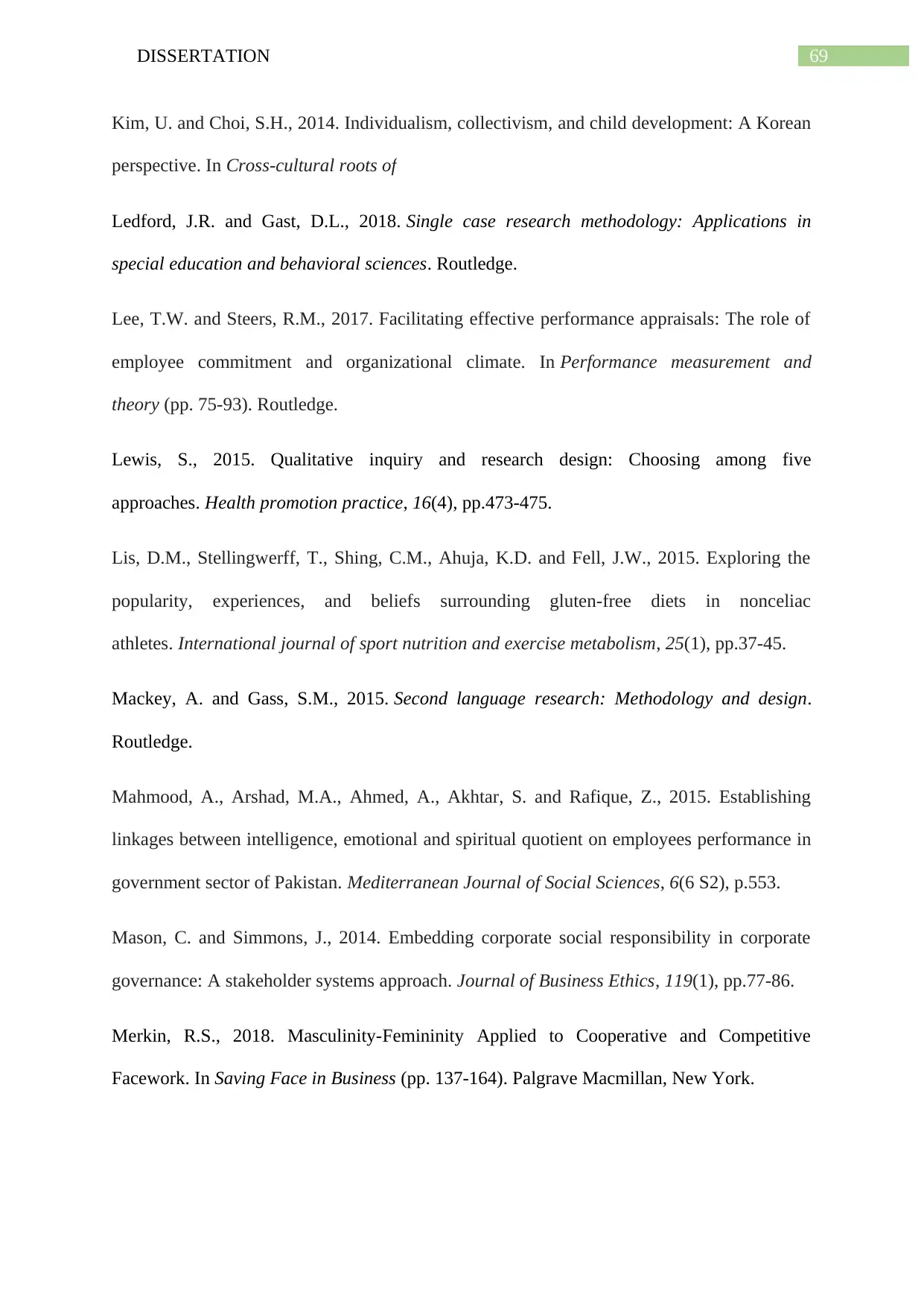
69DISSERTATION
Kim, U. and Choi, S.H., 2014. Individualism, collectivism, and child development: A Korean
perspective. In Cross-cultural roots of
Ledford, J.R. and Gast, D.L., 2018. Single case research methodology: Applications in
special education and behavioral sciences. Routledge.
Lee, T.W. and Steers, R.M., 2017. Facilitating effective performance appraisals: The role of
employee commitment and organizational climate. In Performance measurement and
theory (pp. 75-93). Routledge.
Lewis, S., 2015. Qualitative inquiry and research design: Choosing among five
approaches. Health promotion practice, 16(4), pp.473-475.
Lis, D.M., Stellingwerff, T., Shing, C.M., Ahuja, K.D. and Fell, J.W., 2015. Exploring the
popularity, experiences, and beliefs surrounding gluten-free diets in nonceliac
athletes. International journal of sport nutrition and exercise metabolism, 25(1), pp.37-45.
Mackey, A. and Gass, S.M., 2015. Second language research: Methodology and design.
Routledge.
Mahmood, A., Arshad, M.A., Ahmed, A., Akhtar, S. and Rafique, Z., 2015. Establishing
linkages between intelligence, emotional and spiritual quotient on employees performance in
government sector of Pakistan. Mediterranean Journal of Social Sciences, 6(6 S2), p.553.
Mason, C. and Simmons, J., 2014. Embedding corporate social responsibility in corporate
governance: A stakeholder systems approach. Journal of Business Ethics, 119(1), pp.77-86.
Merkin, R.S., 2018. Masculinity-Femininity Applied to Cooperative and Competitive
Facework. In Saving Face in Business (pp. 137-164). Palgrave Macmillan, New York.
Kim, U. and Choi, S.H., 2014. Individualism, collectivism, and child development: A Korean
perspective. In Cross-cultural roots of
Ledford, J.R. and Gast, D.L., 2018. Single case research methodology: Applications in
special education and behavioral sciences. Routledge.
Lee, T.W. and Steers, R.M., 2017. Facilitating effective performance appraisals: The role of
employee commitment and organizational climate. In Performance measurement and
theory (pp. 75-93). Routledge.
Lewis, S., 2015. Qualitative inquiry and research design: Choosing among five
approaches. Health promotion practice, 16(4), pp.473-475.
Lis, D.M., Stellingwerff, T., Shing, C.M., Ahuja, K.D. and Fell, J.W., 2015. Exploring the
popularity, experiences, and beliefs surrounding gluten-free diets in nonceliac
athletes. International journal of sport nutrition and exercise metabolism, 25(1), pp.37-45.
Mackey, A. and Gass, S.M., 2015. Second language research: Methodology and design.
Routledge.
Mahmood, A., Arshad, M.A., Ahmed, A., Akhtar, S. and Rafique, Z., 2015. Establishing
linkages between intelligence, emotional and spiritual quotient on employees performance in
government sector of Pakistan. Mediterranean Journal of Social Sciences, 6(6 S2), p.553.
Mason, C. and Simmons, J., 2014. Embedding corporate social responsibility in corporate
governance: A stakeholder systems approach. Journal of Business Ethics, 119(1), pp.77-86.
Merkin, R.S., 2018. Masculinity-Femininity Applied to Cooperative and Competitive
Facework. In Saving Face in Business (pp. 137-164). Palgrave Macmillan, New York.
Secure Best Marks with AI Grader
Need help grading? Try our AI Grader for instant feedback on your assignments.
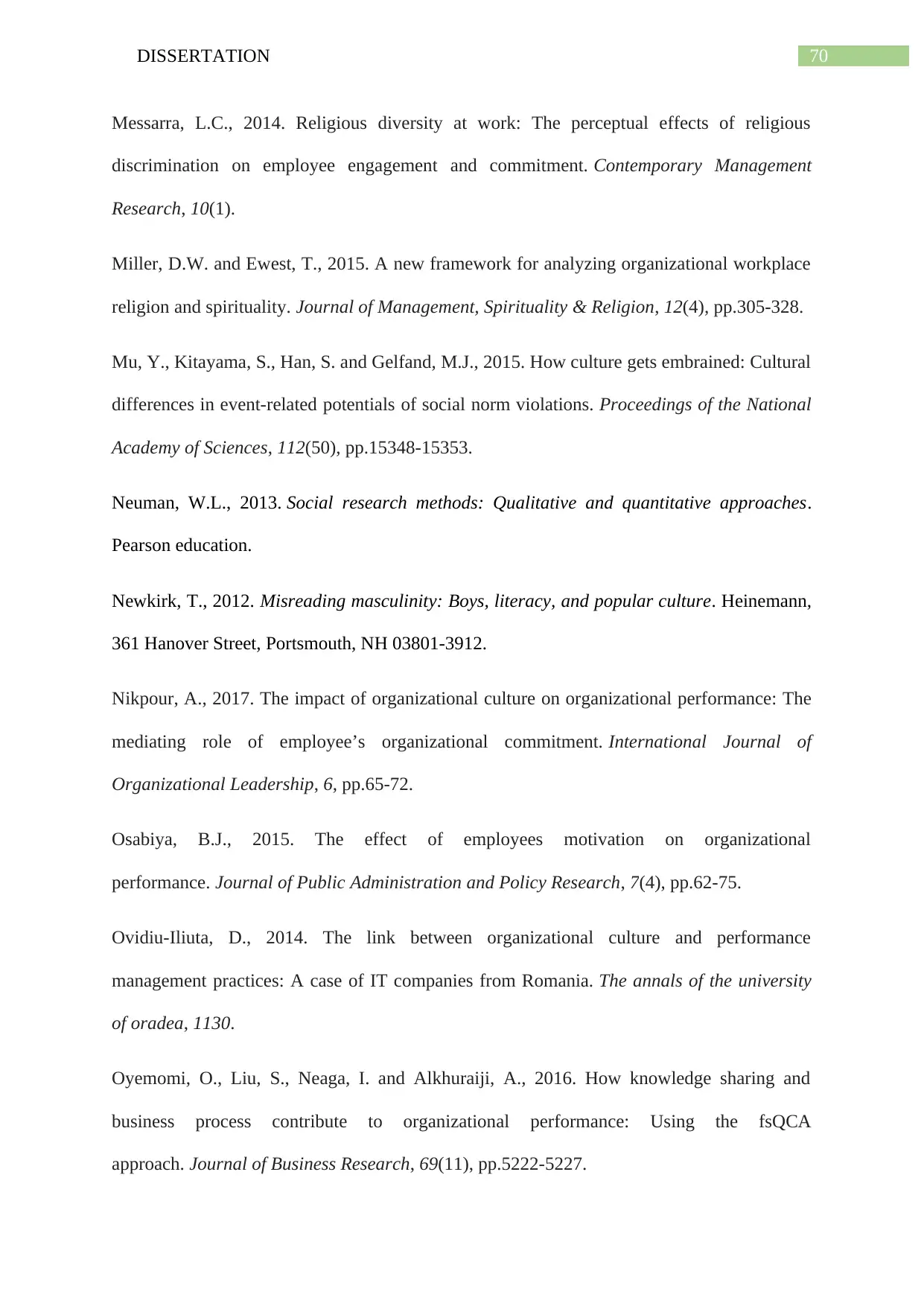
70DISSERTATION
Messarra, L.C., 2014. Religious diversity at work: The perceptual effects of religious
discrimination on employee engagement and commitment. Contemporary Management
Research, 10(1).
Miller, D.W. and Ewest, T., 2015. A new framework for analyzing organizational workplace
religion and spirituality. Journal of Management, Spirituality & Religion, 12(4), pp.305-328.
Mu, Y., Kitayama, S., Han, S. and Gelfand, M.J., 2015. How culture gets embrained: Cultural
differences in event-related potentials of social norm violations. Proceedings of the National
Academy of Sciences, 112(50), pp.15348-15353.
Neuman, W.L., 2013. Social research methods: Qualitative and quantitative approaches.
Pearson education.
Newkirk, T., 2012. Misreading masculinity: Boys, literacy, and popular culture. Heinemann,
361 Hanover Street, Portsmouth, NH 03801-3912.
Nikpour, A., 2017. The impact of organizational culture on organizational performance: The
mediating role of employee’s organizational commitment. International Journal of
Organizational Leadership, 6, pp.65-72.
Osabiya, B.J., 2015. The effect of employees motivation on organizational
performance. Journal of Public Administration and Policy Research, 7(4), pp.62-75.
Ovidiu-Iliuta, D., 2014. The link between organizational culture and performance
management practices: A case of IT companies from Romania. The annals of the university
of oradea, 1130.
Oyemomi, O., Liu, S., Neaga, I. and Alkhuraiji, A., 2016. How knowledge sharing and
business process contribute to organizational performance: Using the fsQCA
approach. Journal of Business Research, 69(11), pp.5222-5227.
Messarra, L.C., 2014. Religious diversity at work: The perceptual effects of religious
discrimination on employee engagement and commitment. Contemporary Management
Research, 10(1).
Miller, D.W. and Ewest, T., 2015. A new framework for analyzing organizational workplace
religion and spirituality. Journal of Management, Spirituality & Religion, 12(4), pp.305-328.
Mu, Y., Kitayama, S., Han, S. and Gelfand, M.J., 2015. How culture gets embrained: Cultural
differences in event-related potentials of social norm violations. Proceedings of the National
Academy of Sciences, 112(50), pp.15348-15353.
Neuman, W.L., 2013. Social research methods: Qualitative and quantitative approaches.
Pearson education.
Newkirk, T., 2012. Misreading masculinity: Boys, literacy, and popular culture. Heinemann,
361 Hanover Street, Portsmouth, NH 03801-3912.
Nikpour, A., 2017. The impact of organizational culture on organizational performance: The
mediating role of employee’s organizational commitment. International Journal of
Organizational Leadership, 6, pp.65-72.
Osabiya, B.J., 2015. The effect of employees motivation on organizational
performance. Journal of Public Administration and Policy Research, 7(4), pp.62-75.
Ovidiu-Iliuta, D., 2014. The link between organizational culture and performance
management practices: A case of IT companies from Romania. The annals of the university
of oradea, 1130.
Oyemomi, O., Liu, S., Neaga, I. and Alkhuraiji, A., 2016. How knowledge sharing and
business process contribute to organizational performance: Using the fsQCA
approach. Journal of Business Research, 69(11), pp.5222-5227.
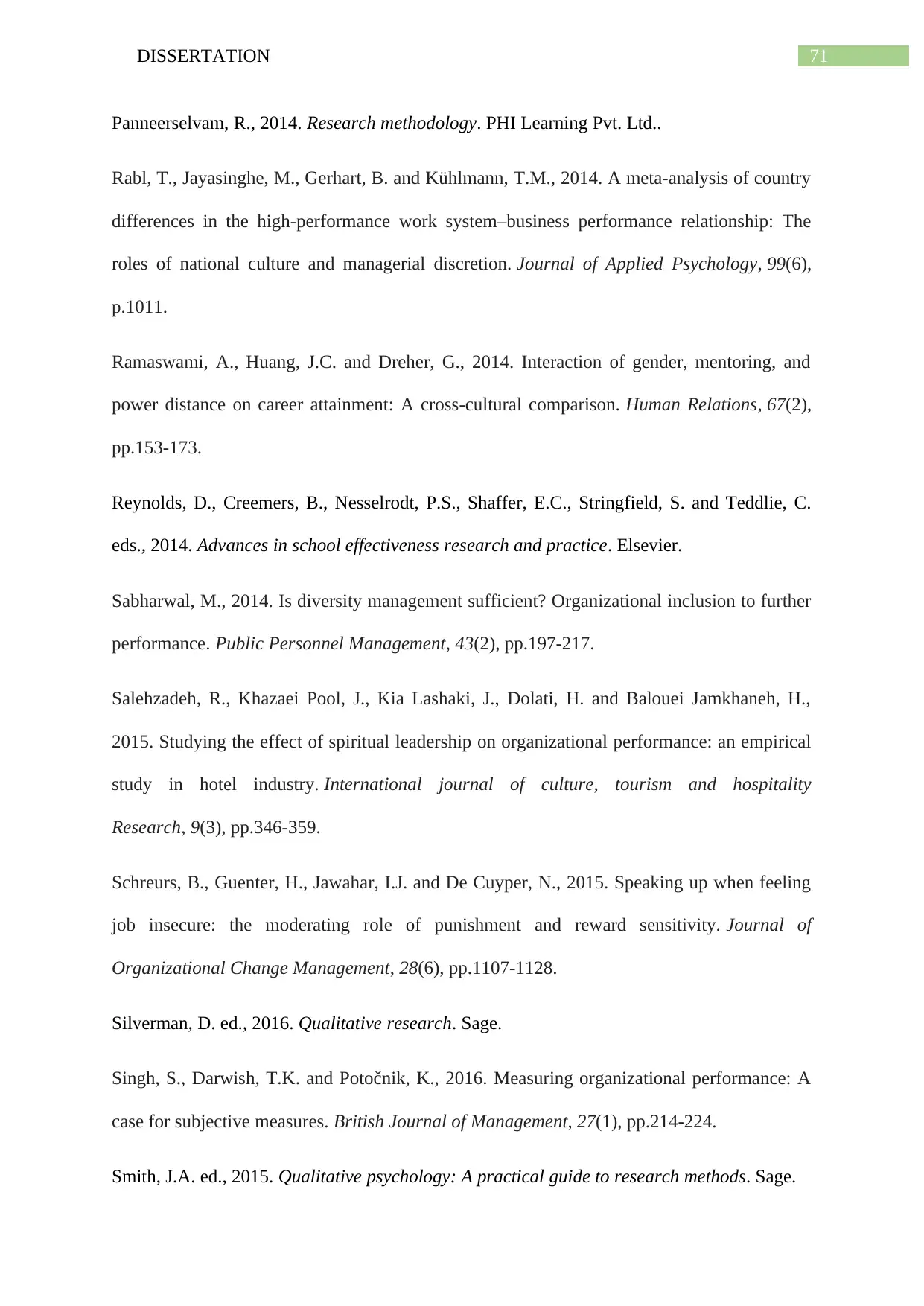
71DISSERTATION
Panneerselvam, R., 2014. Research methodology. PHI Learning Pvt. Ltd..
Rabl, T., Jayasinghe, M., Gerhart, B. and Kühlmann, T.M., 2014. A meta-analysis of country
differences in the high-performance work system–business performance relationship: The
roles of national culture and managerial discretion. Journal of Applied Psychology, 99(6),
p.1011.
Ramaswami, A., Huang, J.C. and Dreher, G., 2014. Interaction of gender, mentoring, and
power distance on career attainment: A cross-cultural comparison. Human Relations, 67(2),
pp.153-173.
Reynolds, D., Creemers, B., Nesselrodt, P.S., Shaffer, E.C., Stringfield, S. and Teddlie, C.
eds., 2014. Advances in school effectiveness research and practice. Elsevier.
Sabharwal, M., 2014. Is diversity management sufficient? Organizational inclusion to further
performance. Public Personnel Management, 43(2), pp.197-217.
Salehzadeh, R., Khazaei Pool, J., Kia Lashaki, J., Dolati, H. and Balouei Jamkhaneh, H.,
2015. Studying the effect of spiritual leadership on organizational performance: an empirical
study in hotel industry. International journal of culture, tourism and hospitality
Research, 9(3), pp.346-359.
Schreurs, B., Guenter, H., Jawahar, I.J. and De Cuyper, N., 2015. Speaking up when feeling
job insecure: the moderating role of punishment and reward sensitivity. Journal of
Organizational Change Management, 28(6), pp.1107-1128.
Silverman, D. ed., 2016. Qualitative research. Sage.
Singh, S., Darwish, T.K. and Potočnik, K., 2016. Measuring organizational performance: A
case for subjective measures. British Journal of Management, 27(1), pp.214-224.
Smith, J.A. ed., 2015. Qualitative psychology: A practical guide to research methods. Sage.
Panneerselvam, R., 2014. Research methodology. PHI Learning Pvt. Ltd..
Rabl, T., Jayasinghe, M., Gerhart, B. and Kühlmann, T.M., 2014. A meta-analysis of country
differences in the high-performance work system–business performance relationship: The
roles of national culture and managerial discretion. Journal of Applied Psychology, 99(6),
p.1011.
Ramaswami, A., Huang, J.C. and Dreher, G., 2014. Interaction of gender, mentoring, and
power distance on career attainment: A cross-cultural comparison. Human Relations, 67(2),
pp.153-173.
Reynolds, D., Creemers, B., Nesselrodt, P.S., Shaffer, E.C., Stringfield, S. and Teddlie, C.
eds., 2014. Advances in school effectiveness research and practice. Elsevier.
Sabharwal, M., 2014. Is diversity management sufficient? Organizational inclusion to further
performance. Public Personnel Management, 43(2), pp.197-217.
Salehzadeh, R., Khazaei Pool, J., Kia Lashaki, J., Dolati, H. and Balouei Jamkhaneh, H.,
2015. Studying the effect of spiritual leadership on organizational performance: an empirical
study in hotel industry. International journal of culture, tourism and hospitality
Research, 9(3), pp.346-359.
Schreurs, B., Guenter, H., Jawahar, I.J. and De Cuyper, N., 2015. Speaking up when feeling
job insecure: the moderating role of punishment and reward sensitivity. Journal of
Organizational Change Management, 28(6), pp.1107-1128.
Silverman, D. ed., 2016. Qualitative research. Sage.
Singh, S., Darwish, T.K. and Potočnik, K., 2016. Measuring organizational performance: A
case for subjective measures. British Journal of Management, 27(1), pp.214-224.
Smith, J.A. ed., 2015. Qualitative psychology: A practical guide to research methods. Sage.
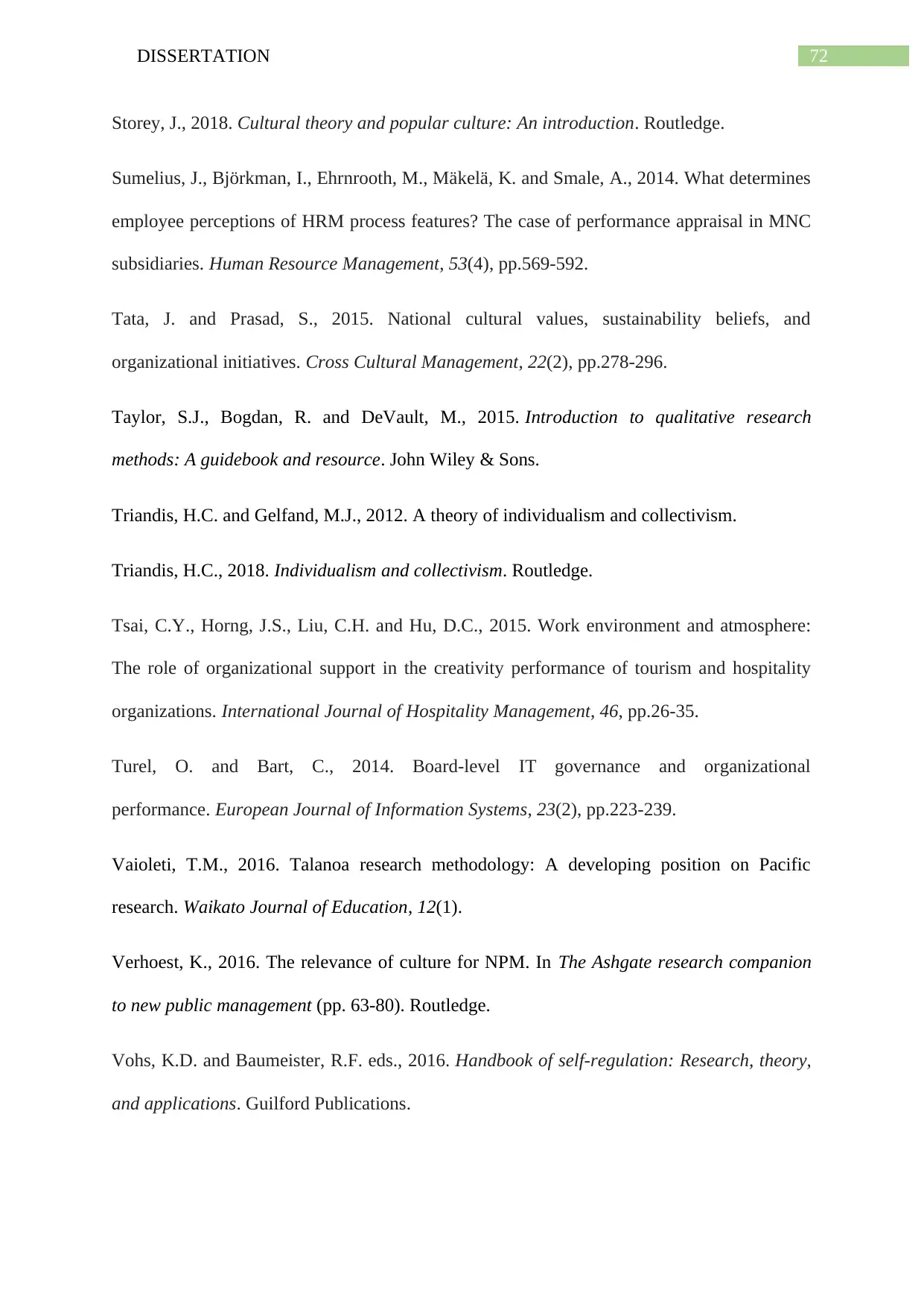
72DISSERTATION
Storey, J., 2018. Cultural theory and popular culture: An introduction. Routledge.
Sumelius, J., Björkman, I., Ehrnrooth, M., Mäkelä, K. and Smale, A., 2014. What determines
employee perceptions of HRM process features? The case of performance appraisal in MNC
subsidiaries. Human Resource Management, 53(4), pp.569-592.
Tata, J. and Prasad, S., 2015. National cultural values, sustainability beliefs, and
organizational initiatives. Cross Cultural Management, 22(2), pp.278-296.
Taylor, S.J., Bogdan, R. and DeVault, M., 2015. Introduction to qualitative research
methods: A guidebook and resource. John Wiley & Sons.
Triandis, H.C. and Gelfand, M.J., 2012. A theory of individualism and collectivism.
Triandis, H.C., 2018. Individualism and collectivism. Routledge.
Tsai, C.Y., Horng, J.S., Liu, C.H. and Hu, D.C., 2015. Work environment and atmosphere:
The role of organizational support in the creativity performance of tourism and hospitality
organizations. International Journal of Hospitality Management, 46, pp.26-35.
Turel, O. and Bart, C., 2014. Board-level IT governance and organizational
performance. European Journal of Information Systems, 23(2), pp.223-239.
Vaioleti, T.M., 2016. Talanoa research methodology: A developing position on Pacific
research. Waikato Journal of Education, 12(1).
Verhoest, K., 2016. The relevance of culture for NPM. In The Ashgate research companion
to new public management (pp. 63-80). Routledge.
Vohs, K.D. and Baumeister, R.F. eds., 2016. Handbook of self-regulation: Research, theory,
and applications. Guilford Publications.
Storey, J., 2018. Cultural theory and popular culture: An introduction. Routledge.
Sumelius, J., Björkman, I., Ehrnrooth, M., Mäkelä, K. and Smale, A., 2014. What determines
employee perceptions of HRM process features? The case of performance appraisal in MNC
subsidiaries. Human Resource Management, 53(4), pp.569-592.
Tata, J. and Prasad, S., 2015. National cultural values, sustainability beliefs, and
organizational initiatives. Cross Cultural Management, 22(2), pp.278-296.
Taylor, S.J., Bogdan, R. and DeVault, M., 2015. Introduction to qualitative research
methods: A guidebook and resource. John Wiley & Sons.
Triandis, H.C. and Gelfand, M.J., 2012. A theory of individualism and collectivism.
Triandis, H.C., 2018. Individualism and collectivism. Routledge.
Tsai, C.Y., Horng, J.S., Liu, C.H. and Hu, D.C., 2015. Work environment and atmosphere:
The role of organizational support in the creativity performance of tourism and hospitality
organizations. International Journal of Hospitality Management, 46, pp.26-35.
Turel, O. and Bart, C., 2014. Board-level IT governance and organizational
performance. European Journal of Information Systems, 23(2), pp.223-239.
Vaioleti, T.M., 2016. Talanoa research methodology: A developing position on Pacific
research. Waikato Journal of Education, 12(1).
Verhoest, K., 2016. The relevance of culture for NPM. In The Ashgate research companion
to new public management (pp. 63-80). Routledge.
Vohs, K.D. and Baumeister, R.F. eds., 2016. Handbook of self-regulation: Research, theory,
and applications. Guilford Publications.
Paraphrase This Document
Need a fresh take? Get an instant paraphrase of this document with our AI Paraphraser

73DISSERTATION
Wang, C.L. and Rafiq, M., 2014. Ambidextrous organizational culture, Contextual
ambidexterity and new product innovation: a comparative study of UK and C hinese high‐
tech Firms. British Journal of management, 25(1), pp.58-76.
White III, L.T., 2014. Policies of Chaos: The Organizational Causes of Violence in China's
Cultural Revolution (Vol. 1031). Princeton University Press.
Wu, S.P.J., Straub, D.W. and Liang, T.P., 2015. How information technology governance
mechanisms and strategic alignment influence organizational performance: Insights from a
matched survey of business and IT managers. Mis Quarterly, 39(2), pp.497-518.
Xu, Y. and Hamamura, T., 2014. Folk beliefs of cultural changes in China. Frontiers in
psychology, 5, p.1066.
Yamao, S. and Sekiguchi, T., 2015. Employee commitment to corporate globalization: The
role of English language proficiency and human resource practices. Journal of World
Business, 50(1), pp.168-179.
Yang, L.R., Huang, C.F. and Hsu, T.J., 2014. Knowledge leadership to improve project and
organizational performance. International Journal of Project Management, 32(1), pp.40-53.
Zohar, D. and Polachek, T., 2014. Discourse-based intervention for modifying supervisory
communication as leverage for safety climate and performance improvement: A randomized
field study. Journal of applied psychology, 99(1), p.113.
Wang, C.L. and Rafiq, M., 2014. Ambidextrous organizational culture, Contextual
ambidexterity and new product innovation: a comparative study of UK and C hinese high‐
tech Firms. British Journal of management, 25(1), pp.58-76.
White III, L.T., 2014. Policies of Chaos: The Organizational Causes of Violence in China's
Cultural Revolution (Vol. 1031). Princeton University Press.
Wu, S.P.J., Straub, D.W. and Liang, T.P., 2015. How information technology governance
mechanisms and strategic alignment influence organizational performance: Insights from a
matched survey of business and IT managers. Mis Quarterly, 39(2), pp.497-518.
Xu, Y. and Hamamura, T., 2014. Folk beliefs of cultural changes in China. Frontiers in
psychology, 5, p.1066.
Yamao, S. and Sekiguchi, T., 2015. Employee commitment to corporate globalization: The
role of English language proficiency and human resource practices. Journal of World
Business, 50(1), pp.168-179.
Yang, L.R., Huang, C.F. and Hsu, T.J., 2014. Knowledge leadership to improve project and
organizational performance. International Journal of Project Management, 32(1), pp.40-53.
Zohar, D. and Polachek, T., 2014. Discourse-based intervention for modifying supervisory
communication as leverage for safety climate and performance improvement: A randomized
field study. Journal of applied psychology, 99(1), p.113.
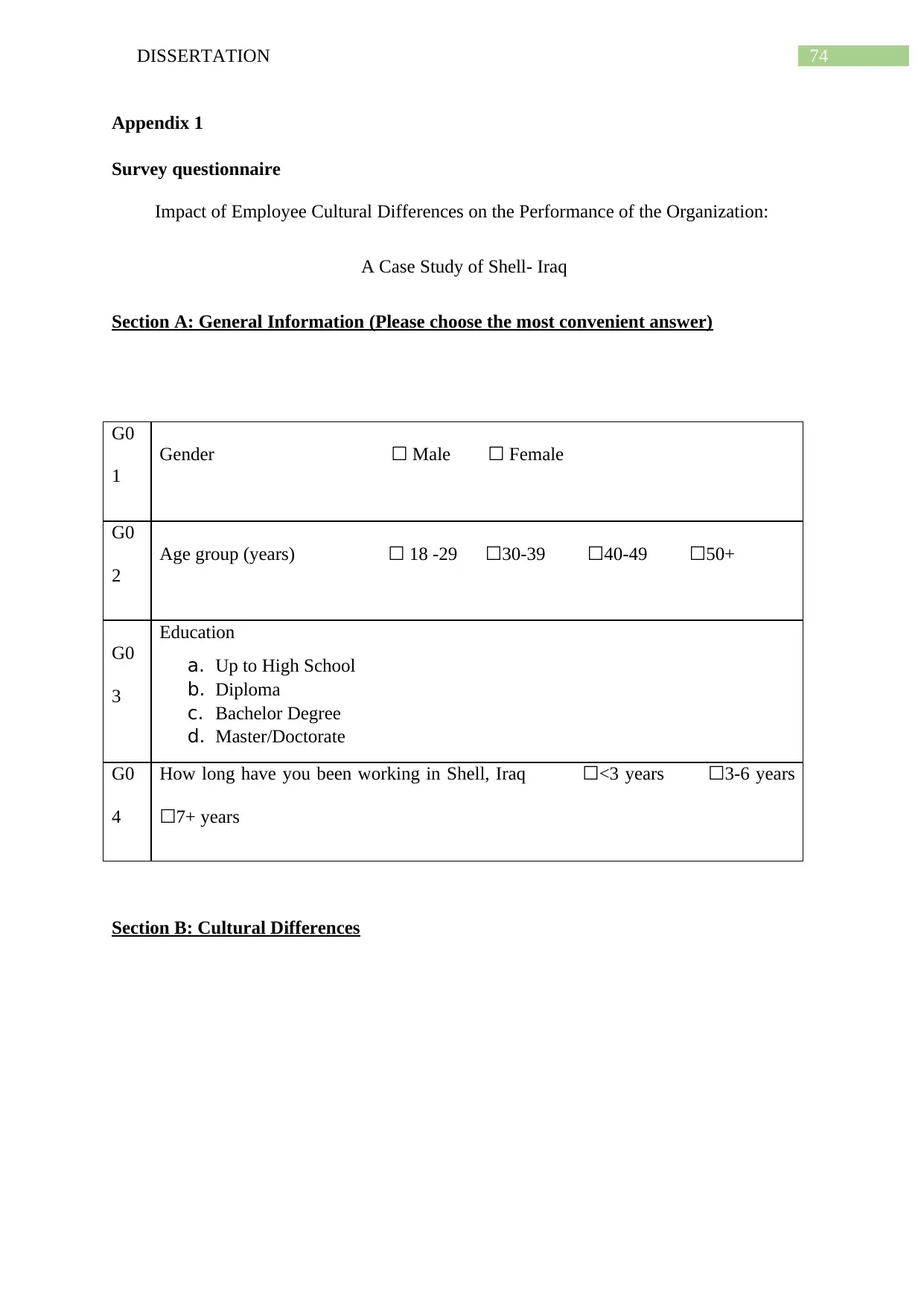
74DISSERTATION
Appendix 1
Survey questionnaire
Impact of Employee Cultural Differences on the Performance of the Organization:
A Case Study of Shell- Iraq
Section A: General Information (Please choose the most convenient answer)
G0
1
Gender ☐ Male ☐ Female
G0
2
Age group (years) ☐ 18 -29 ☐30-39 ☐40-49 ☐50+
G0
3
Education
a. Up to High School
b. Diploma
c. Bachelor Degree
d. Master/Doctorate
G0
4
How long have you been working in Shell, Iraq ☐<3 years ☐3-6 years
☐7+ years
Section B: Cultural Differences
Appendix 1
Survey questionnaire
Impact of Employee Cultural Differences on the Performance of the Organization:
A Case Study of Shell- Iraq
Section A: General Information (Please choose the most convenient answer)
G0
1
Gender ☐ Male ☐ Female
G0
2
Age group (years) ☐ 18 -29 ☐30-39 ☐40-49 ☐50+
G0
3
Education
a. Up to High School
b. Diploma
c. Bachelor Degree
d. Master/Doctorate
G0
4
How long have you been working in Shell, Iraq ☐<3 years ☐3-6 years
☐7+ years
Section B: Cultural Differences
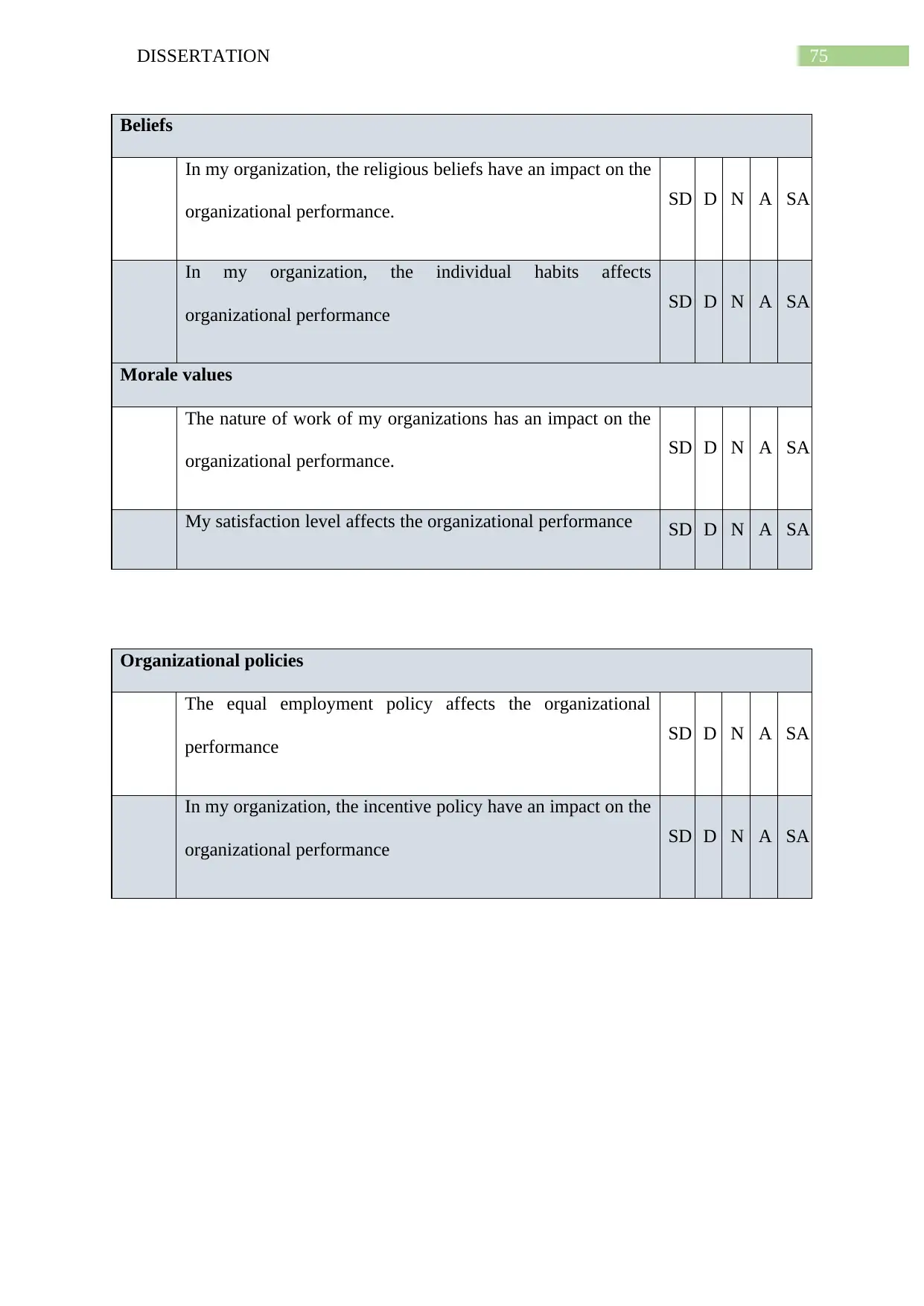
75DISSERTATION
Beliefs
In my organization, the religious beliefs have an impact on the
organizational performance. SD D N A SA
In my organization, the individual habits affects
organizational performance SD D N A SA
Morale values
The nature of work of my organizations has an impact on the
organizational performance. SD D N A SA
My satisfaction level affects the organizational performance SD D N A SA
Organizational policies
The equal employment policy affects the organizational
performance SD D N A SA
In my organization, the incentive policy have an impact on the
organizational performance SD D N A SA
Beliefs
In my organization, the religious beliefs have an impact on the
organizational performance. SD D N A SA
In my organization, the individual habits affects
organizational performance SD D N A SA
Morale values
The nature of work of my organizations has an impact on the
organizational performance. SD D N A SA
My satisfaction level affects the organizational performance SD D N A SA
Organizational policies
The equal employment policy affects the organizational
performance SD D N A SA
In my organization, the incentive policy have an impact on the
organizational performance SD D N A SA
Secure Best Marks with AI Grader
Need help grading? Try our AI Grader for instant feedback on your assignments.

76DISSERTATION
Section C: Organizational performance
Language
In my organization, different cultural language affects the
organizational performance SD D N A SA
In my organization, using native cultural language has an
impact on organizational performance SD D N A SA
Native cultural language restricts me to perform well in the
organization SD D N A SA
Organizational tradition
The use of desirable behaviour has a positive impact on
organizational performance SD D N A SA
Respecting the native culture has an impact on the
performance of my organization SD D N A SA
Section C: Organizational performance
Language
In my organization, different cultural language affects the
organizational performance SD D N A SA
In my organization, using native cultural language has an
impact on organizational performance SD D N A SA
Native cultural language restricts me to perform well in the
organization SD D N A SA
Organizational tradition
The use of desirable behaviour has a positive impact on
organizational performance SD D N A SA
Respecting the native culture has an impact on the
performance of my organization SD D N A SA

77DISSERTATION
Organizational performance
The existing culture of my organization has an impact on the
organizational performance SD D N A SA
The guidance provided in my organization has an impact on
the organizational performance SD D N A SA
The motivational level in my organization has an impact on
the organizational performance SD D N A SA
The existing knowledge in my organization has an impact on
the organizational performance
Organizational performance
The existing culture of my organization has an impact on the
organizational performance SD D N A SA
The guidance provided in my organization has an impact on
the organizational performance SD D N A SA
The motivational level in my organization has an impact on
the organizational performance SD D N A SA
The existing knowledge in my organization has an impact on
the organizational performance
1 out of 78
Related Documents
Your All-in-One AI-Powered Toolkit for Academic Success.
+13062052269
info@desklib.com
Available 24*7 on WhatsApp / Email
![[object Object]](/_next/static/media/star-bottom.7253800d.svg)
Unlock your academic potential
© 2024 | Zucol Services PVT LTD | All rights reserved.





